Quebec
George Eric Jarvis and Catherine Arta Johnson Jarvis
George Eric Jarvis and Catherine Arta Johnson Jarvis, “Quebec,” in Canadian Mormons: History of the Church of Jesus Christ of Latter-Day Saints in Canada, ed. Roy A. and Carma T. Prete (Provo, UT: Religious Studies Center; Salt Lake City: Deseret Book, 2017), 412-453.
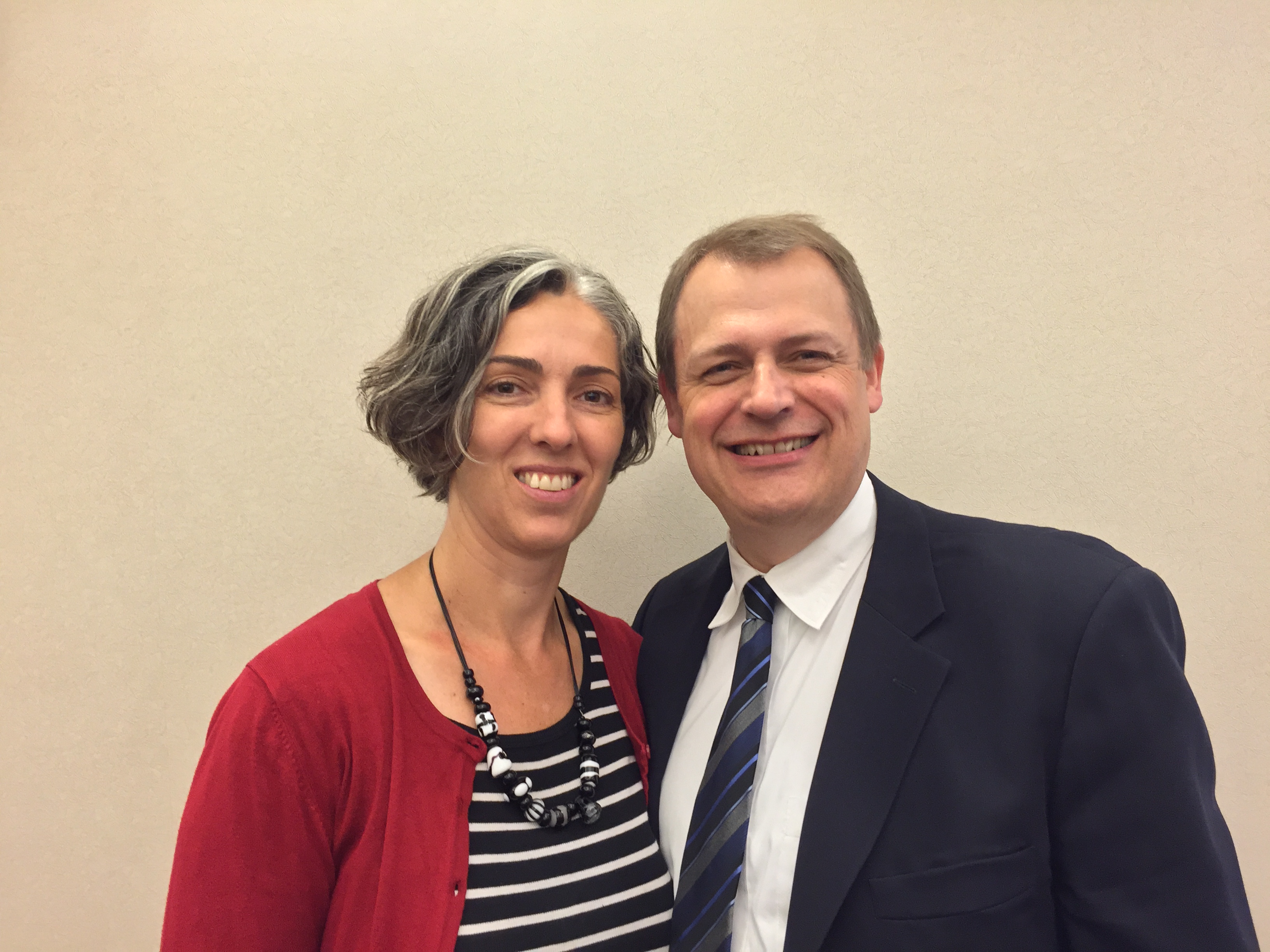
George Eric Jarvis, MD, attended Brigham Young University prior to completing medical school at the University of Alberta, which was followed by specialty training in psychiatry, a research fellowship, and an MSc in social and transcultural psychiatry at McGill University. He is associate professor of psychiatry at McGill University, where he directs the Cultural Consultation Service and the First Episode Psychosis Program at the Jewish General Hospital. He publishes and presents at international conferences on topics in culture and mental health and the history of psychiatry. His current research evaluates the impact of culture, language, and religion on the diagnosis and treatment of mental disorders. Dr. Jarvis served a full-time mission in Paris, France, and has been a branch president and stake president. He and his wife, Catherine, have four children.Catherine Arta Johnson Jarvis, MD, is a faculty lecturer in the Department of Family Medicine at McGill University. She obtained her medical degree from the University of Alberta (1994) and did her residency training in family medicine at McGill University (1996), followed by fellowships in Maternal-Child Health and Palliative Care (1997). She currently practices family medicine at the Centre Local de Services Communautaires (CLSC), an inner-city community health centre in Côte-Des-Neiges, which services a large immigrant population and where she also teaches undergraduate and postgraduate trainees. Her previous practice has included working at the Herzl Family Practice Centre, the Jewish General Hospital, and the Royal Victoria Hospital Palliative Care Unit, as well as running an obstetrical intake clinic for resident teaching. She has served in many Church capacities and is currently the public affairs codirector (with her husband) for the Quebec-Ottawa coordinating council and is the assistant director of public affairs in the North America North East Area. (Catherine Jarvis)
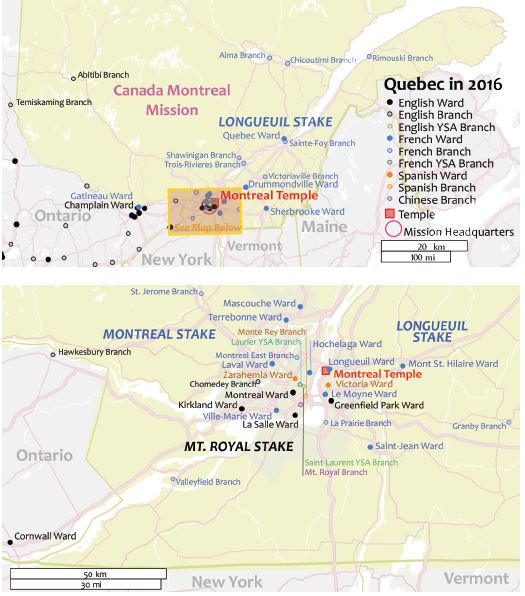 This map details the establishment of the Church in Quebec. Following a period of preaching in the 1830s and 1840s, missionaries returned early in the twentieth century, having modest success among the English-speaking population. Not until after the Quiet Revolution in Quebec in the 1960s and the highly successful Mormon Pavilion at the Man and His World exposition in Montreal, 1969–70, did significant numbers of French Quebecers join the Church. The Church has since blossomed in Quebec, with the result that by 2016 there were two French-speaking stakes and one English-speaking stake in the province, with a total population of over eleven thousand. Having served the region since the year 2000, the Montreal Quebec Temple, after extensive renovations, was rededicated in 2015.
This map details the establishment of the Church in Quebec. Following a period of preaching in the 1830s and 1840s, missionaries returned early in the twentieth century, having modest success among the English-speaking population. Not until after the Quiet Revolution in Quebec in the 1960s and the highly successful Mormon Pavilion at the Man and His World exposition in Montreal, 1969–70, did significant numbers of French Quebecers join the Church. The Church has since blossomed in Quebec, with the result that by 2016 there were two French-speaking stakes and one English-speaking stake in the province, with a total population of over eleven thousand. Having served the region since the year 2000, the Montreal Quebec Temple, after extensive renovations, was rededicated in 2015.
In the first two decades following the organization of The Church of Jesus Christ of Latter-day Saints in 1830, missionaries came to Quebec and made a few English-speaking converts who then left to join the Saints in their westward movement to Utah. The establishment of the Church in Quebec in the twentieth century began when missionaries from the newly established Canadian Mission, headquartered in Toronto, came to Montreal in 1919 and began work among the English-speaking population.
The Church grew slowly and for many years existed only as the Montreal Branch, which was created in 1928. Through the service of such early pioneers as James McCance (the first branch president, who served for seventeen years) and the sustained efforts of missionaries and members, the Church grew slowly but steadily over the next four decades. By 1969, there were three English-speaking branches of the Church in Quebec: Montreal, Pointe Claire, and Greenfield Park.[1]
The LDS Church during these years mainly existed among the English-speaking minority. The province of Quebec was distinct from most of Canada, having been settled by colonists from France, who brought with them Roman Catholicism and French language and culture. The Catholic Church remained dominant throughout much of the province’s history. Initial attempts to proselytize among the French-speaking majority of the province in the late 1940s and early 1950s met with failure and were discontinued until the reintroduction of French-speaking missionaries in 1961. The first French-speaking branch in Montreal (although a dependent branch) was formed in 1964, and the Quebec City Branch was formed in 1969, but the work proceeded slowly.
Prior to the late 1960s, Quebec was insular and somewhat unfriendly to outsiders; the Catholic Church controlled its social institutions; and its language and culture were losing ground to the English Canadian mainstream.[2] Bruce Blumell, a missionary assigned to Quebec in the early 1960s, described the nature of missionary work in those early days: “I can remember going tracting in French areas and people wouldn’t just say, ‘No, I’m not interested.’ You would get door after door just literally slammed in your face. . . . Their orientation was so completely Catholic that . . . as soon as they fully understood [we weren’t] Catholic, they’d just slam the door. And you’d go sometimes to dozens of doors before anyone would even talk to you.”[3]
Under these conditions, by 1969, after a presence of more than fifty years, total Church membership was 1,146,[4] almost entirely among the anglophone (as English speakers are referred to in Quebec) minority. The Church had only recently obtained legal recognition on 1 October 1967.[5] No one could have predicted that over the next fifty years, LDS Church membership in Quebec would expand nearly tenfold, initially among the French-speaking majority and later among immigrants to Quebec, to include a mission, three stakes, thirty-seven wards and branches, and 11,406 members,[6] plus a volunteer resource center for employment, thriving seminary and institute programs, five family history centres, and a temple.
Documenting the growth of the LDS Church in Quebec will be the main subject of this chapter. The history of the Church in Quebec from its beginnings will be presented, along with the changes to Quebec society that created an eagerness for new ideas, including religion, and which gave the Church room to grow and prosper. The chapter will also capture the dedication of Church members and missionaries and their many sacrifices, which has been and continue to be the engine of Church growth in the province.
The Nineteenth-Century Heritage
Before exploring how The Church of Jesus Christ of Latter-day Saints established itself in Quebec in the twentieth century, this section will review the earliest known LDS contacts and will outline the nineteenth-century heritage of faith left by early missionaries and members. Latter-day Saint missionaries visited Quebec in the 1830s and 1840s, resulting in some convert baptisms. The first missionaries to preach in Quebec were Hazen Aldrich and Horace Cowan. Sometime between 8 July and 17 October 1833, the two missionaries held a meeting in Lower Canada, likely near the Canadian-US border. They did not report any baptisms at that time.[7]
However, by July 1835, Jeremiah and Sarah Sturtevant Leavitt and over twenty members of their family from Hatley, Quebec, north of the Vermont border, accepted the gospel. Soon after, they left for Kirtland, Ohio, to gather with the main body of the Latter-day Saints. Several members of the Leavitt family were baptized after they arrived in Kirtland.[8] Of interest is the fact that the youngest son of Jeremiah and Sarah Sturtevant Leavitt, Thomas Rowell Leavitt, was an early settler in Cardston, Alberta, many years later.[9] Like the Leavitt family, the few converts from Quebec during these very early days left the province to gather with the main Church in Ohio or Nauvoo. Many of these crossed the plains to Utah from 1847 to 1863.[10]
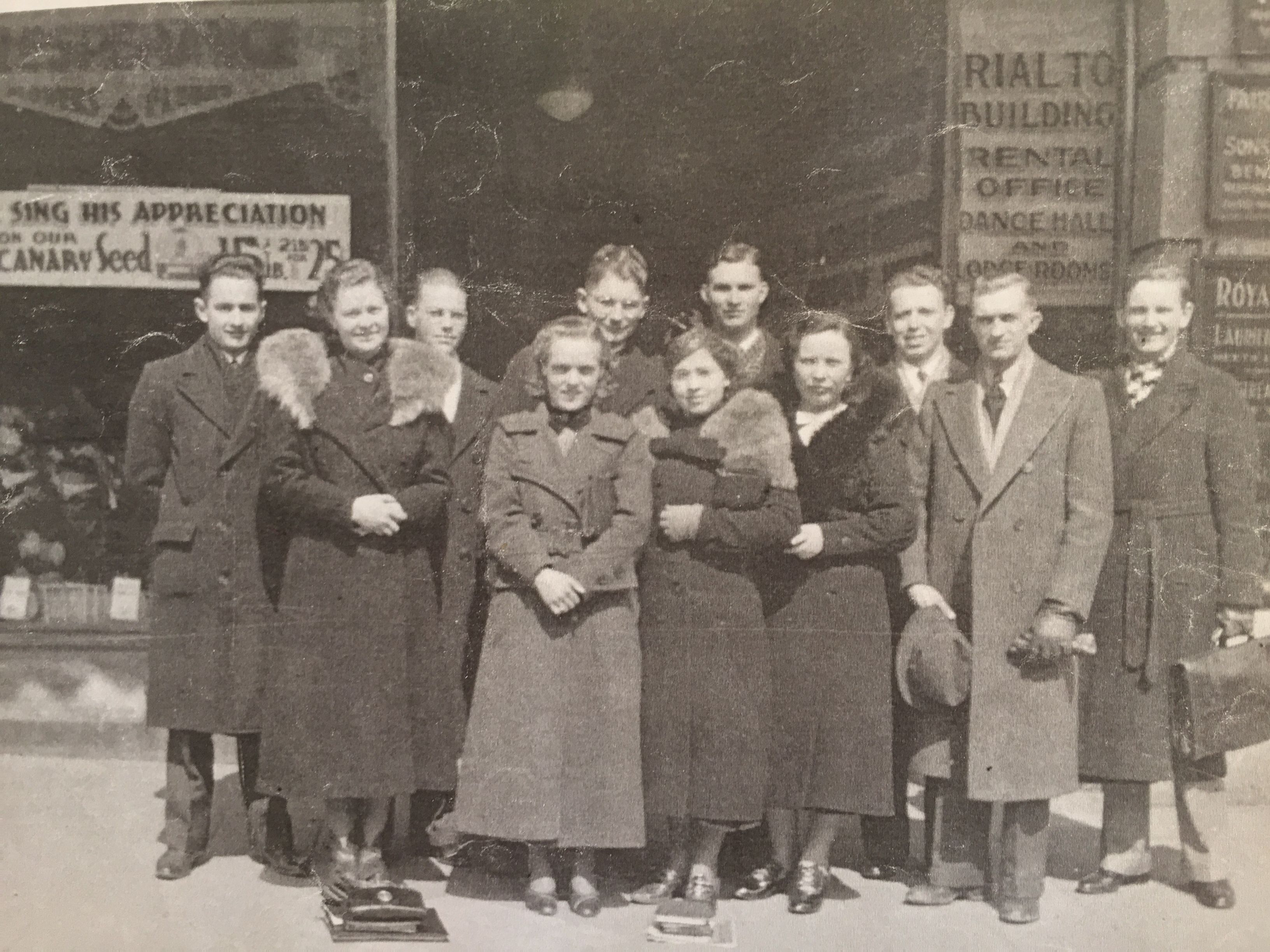 In the years following the creation of the Canadian Mission in 1919, missionaries were routinely assigned to serve in Quebec. This photograph shows eleven missionaries standing in front of the Rialto Theatre, the meeting place of the Montreal Branch in the 1930s. (Ray Sawyer)
In the years following the creation of the Canadian Mission in 1919, missionaries were routinely assigned to serve in Quebec. This photograph shows eleven missionaries standing in front of the Rialto Theatre, the meeting place of the Montreal Branch in the 1930s. (Ray Sawyer)
Jesse Crosby and Benjamin Brown, Latter-day Saint missionaries, visited Montreal and Quebec City in June 1844. They noted the intense Catholic worship of the day, and although they preached on two occasions in Montreal, there was no record of converts.[11] Catholic priests forbad them to preach in Quebec City.[12]
With the Church focused on establishing itself in the Intermountain West, missionary attention to Quebec and other eastern sectors waned. There were no known members of the Church in Quebec for several decades after the 1840s, when the last of the Leavitt family joined the main body of the Latter-day Saints in the United States, eventually crossing the plains to Utah in 1863.[13] The Eastern States Mission, which was organized in 1893, included eastern Canada within its boundaries.[14] Early records show that missionaries were operating sporadically in Montreal before 1914. These missionaries were not allowed to distribute Church literature, except by mail, which hampered the work.[15]
Gaining a Foothold in English-speaking Quebec
On 1 July 1919, Nephi Jensen was called as president of the newly formed Canadian mission, which was based in Toronto.[16] As a result, missionaries began to serve on a permanent basis in Montreal, and by 1920 there were six full-time missionaries serving in the city. The arrival in Montreal of two Latter-day Saint families from the British Isles in 1920, Frederick and Annie Lamb and Robert and Jeannie Berryman, provided a nucleus for Church growth. The missionaries began holding Sunday School regularly in the Lambs’ home in April 1921. The little group welcomed investigators, including Edith Poyser Sydenham, the first convert baptized in Quebec since the creation of the Canadian Mission. On 30 October 1921, James McCance, Cornelius O’Riordan, and David Lamb, a younger member of the large Lamb family, were baptized and confirmed members of the Church, at a time when missionaries often used the public baths for baptisms.[17] McCance was among the first group of men ordained to the priesthood in Quebec.[18]
As mentioned already, missionary work during these years took place almost exclusively among the English-speaking people of Quebec, with missionaries focusing their attention on Montreal and making occasional trips to English-speaking communities, such as Ormstown, Huntingdon, Lennoxville, Cowansville, Sherbrooke, and towns near the United States border.[19] In many cities, it was difficult for them to obtain permission to teach: the city of Outremont, for example, granted such permission for the first time on 27 October 1925, but only if the missionaries had a license.[20]
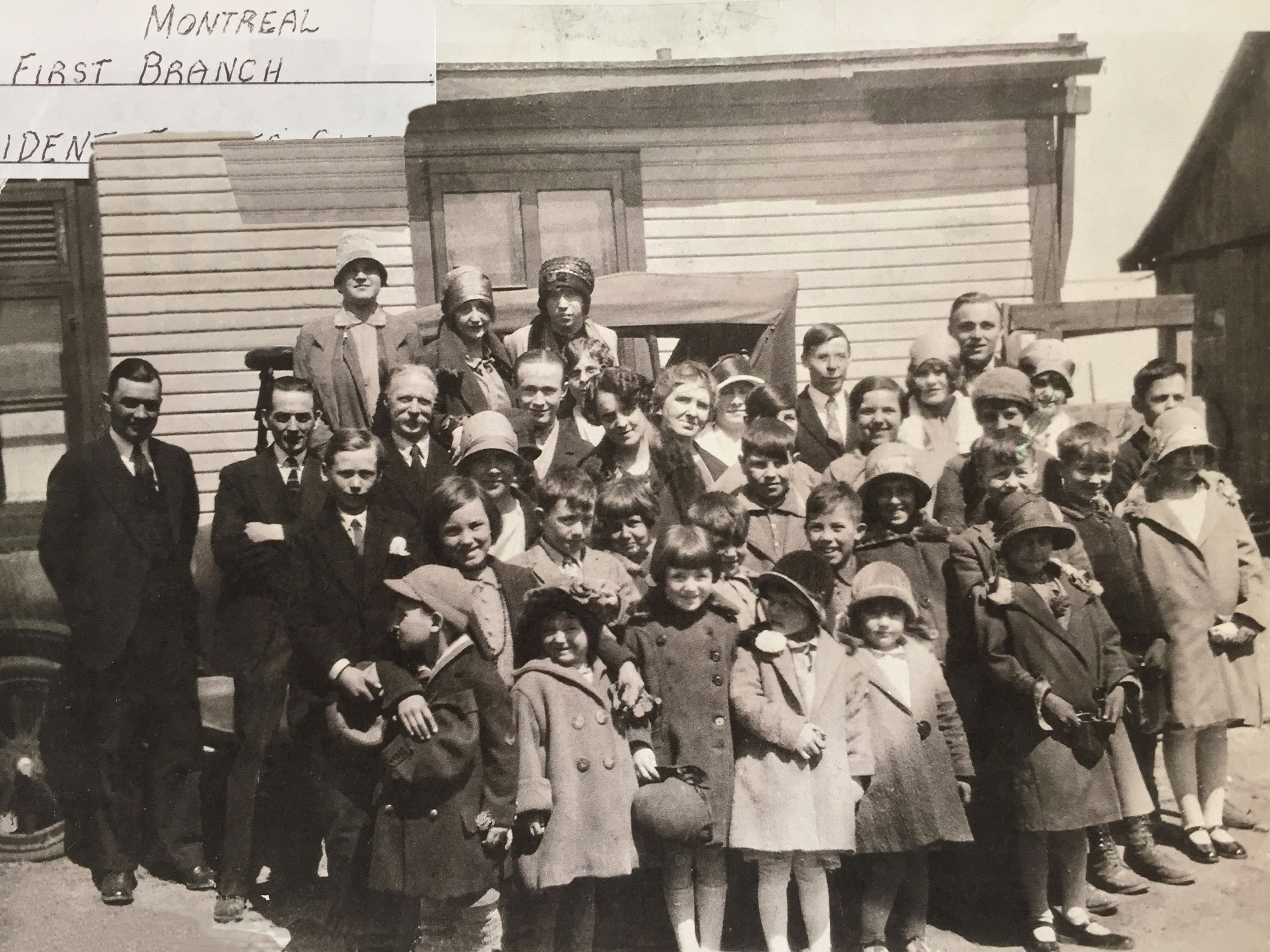 Members of the Montreal Branch standing in front of their rented meeting hall in the 1930s. Branch President James McCance is second from the left. (Ray Sawyer)
Members of the Montreal Branch standing in front of their rented meeting hall in the 1930s. Branch President James McCance is second from the left. (Ray Sawyer)
On 16 September 1928, Charles H. Hart, president of the Canadian Mission, organized the Montreal Branch, the first branch of the Church in Quebec. James McCance was called as president, with Frederick Lamb and Harold A. Peterson as counselors. The new branch met in a rented hall at 5711 Park Avenue.[21] During McCance’s seventeen-year term as branch president, the small branch grew slowly but steadily. Their first Gold and Green Ball was held in 1939, and in 1941 the first branch conference took place.[22] After years of meeting in rented halls, in 1942 the branch purchased the Mount Royal United Church building at 750 St. Joseph Boulevard, the first Church-owned meetinghouse in Quebec.[23] After renovations to the building were completed, Joseph Fielding Smith of the Quorum of the Twelve came to Montreal and dedicated the new meetinghouse in June the same year.[24]
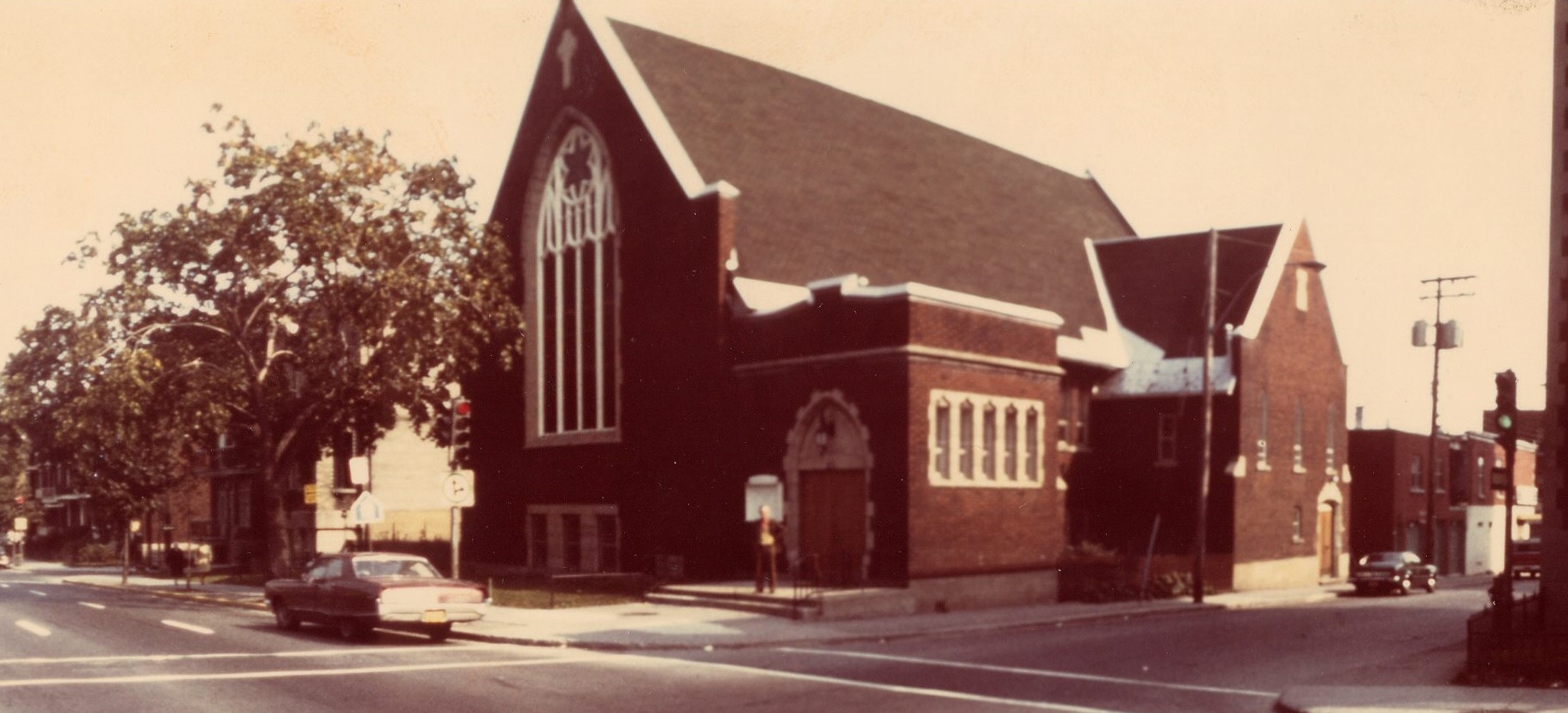 The St. Joseph Boulevard chapel. In 1942, after years of holding Church meetings in rented halls, members of the Montreal Branch were thrilled to purchase a church building from another denomination. This stately old building served both French and English branches, the Montreal Branch, and later the French-speaking Hochelaga Branch, until the building was seriously damaged by fire in 1979. (Nicolas Athanassi)
The St. Joseph Boulevard chapel. In 1942, after years of holding Church meetings in rented halls, members of the Montreal Branch were thrilled to purchase a church building from another denomination. This stately old building served both French and English branches, the Montreal Branch, and later the French-speaking Hochelaga Branch, until the building was seriously damaged by fire in 1979. (Nicolas Athanassi)
Raymond Sawyer was eight years old when the branch moved into the new building. He recalled that there were forty or fifty people attending meetings during that time. He noted that because Church members lived at great distances from one another, they “only saw each other on Sunday.” People travelled to church by bus and streetcar. President McCance would sit on the stand during meetings, looking serious and stern, and Sawyer’s grandfather, Frederick Lamb, would firmly remind his young grandson, Raymond, to be more reverent in the meetings. Sawyer also recalled looking out the windows of the Rialto Hall, where the branch would meet for conferences.[25]
The Second World War, in which Canada participated from 1939 to 1945, had a profound effect on proselytizing in Quebec. As more and more young men were called into military service in the United States and Canada, fewer and fewer were available to serve as missionaries. In 1943, eight local missionaries were called to serve in the Montreal District, presumably because of the shortage of full-time missionaries.[31] By April 1944, all missionaries had been transferred from Montreal, and there were no missionaries at all in Quebec for two years. It was not until April 1946, after the war had ended, that missionaries were assigned again to Quebec.[32]
Missionaries continued to encounter persecution throughout the 1940s and ‘50s. On 13 October 1946, the police chief in Quebec City declined to grant them permission to proselytize. On 24 October of that year, two missionaries were arrested in Montreal and were charged with distributing religious literature without a written city permit. Citizens of Westmount made additional complaints against the missionaries in December 1946, prompting the police to verify their permits.[33]
Incidents with the police occurred on occasion over the next few years: the police disrupted a street meeting in Montreal on 27 April 1947; two missionaries were expelled from the town of Richmond on 20 April 1949; and in the summer of 1949, six missionaries were apprehended by police and held for questioning on what came to be understood as false charges.[34] Similar incidents continued through 1951, when police and city officials from several jurisdictions limited missionary activities.[35] These problems culminated in acts of violence against missionaries and members: in Montreal in May 1955, a group of teenage boys attacked two missionaries with hockey sticks, seriously injuring one of them; and in December 1956, a mob approached the home of a Latter-day Saint family in Grenville, the Crookses, threatening to burn their house. Fortunately, when courageously confronted by Sister Crooks, the mob dispersed.[36] Gradually, over the course of the 1950s, tensions eased and missionaries gained formal approval from towns and cities to teach the gospel freely.
Despite the persecution and violence, missionaries took their message to other cities and towns in the province. Two missionaries optimistically wrote of their early efforts to proselytize in Drummondville in 1941: “The town is about 90 percent French, but the prospects are looking good among the English-speaking people”.[37]
Growth in the 1950s
In 1950, missionaries received permission to proselytize in Greenfield Park, an English-speaking suburb of Montreal. In due course, they baptized some stalwart families, including Hans and Elsa Peets. The Greenfield Park Branch was organized in 1962, with Hans Peets as branch president.[38] The Peets family had come to Canada as refugees from Estonia in the late 1940s and were converted to the gospel in Canada, with Hans joining the Church in 1956 and Elsa three years later in 1959.[39]
Meanwhile, the number of Church members on the northwest part of Montreal Island was growing. As a result, the Pointe Claire Branch was organized in 1967, with 125 members. The branch soon purchased a church building from the Baptists, and this meetinghouse, located at 93 St. Louis Avenue, was dedicated in 1969.[40]
Over the years various attempts were made to combine the strength of the two LDS communities in the Ottawa and Montreal regions. The Ottawa-Montreal District, which was formed in 1957, with Kenneth F. Nielsen as the first president, held conferences alternately in Ottawa and Montreal.[41] At the quarterly conference of the Ottawa-Montreal District, 14–15 June 1969, C. Leland Davey, president of the Canadian Mission, divided the district to form the Ottawa and Montreal Districts. Hans Peets was called as the first president of the Montreal District.[42]
Missionary Work in French-speaking Quebec in the 1960s
Laying the Foundation
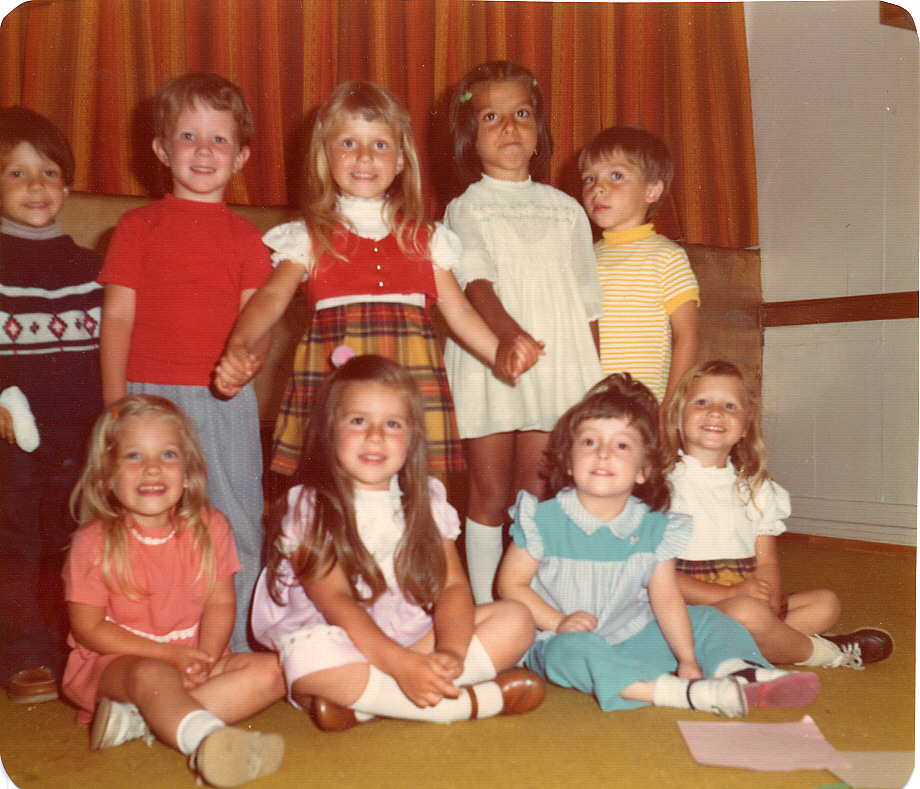 These children of the Hochelaga Branch, which was created in 1969, were among the first in Quebec to attend Primary in the French language. (Nicolas Athanassi)
These children of the Hochelaga Branch, which was created in 1969, were among the first in Quebec to attend Primary in the French language. (Nicolas Athanassi)
The first serious efforts to bring the gospel to the French-speaking people of Quebec started in December 1946, when four missionaries began taking French classes twice per week. In July 1947, six missionaries were assigned to work among the French—two in the western part of the province, two in Quebec City, and two sister missionaries in Montreal. The work came to an abrupt end, however, when on 26 September 1950, the missionaries who had been working in French, presumably for want of success, were transferred to the French Mission, with headquarters in Paris, France.[44]
Proselytizing among the French-speaking population was taken up again under the leadership of Thomas S. Monson, president of the Canadian Mission, this time permanently. On 20 April 1961, he assigned two missionaries to teach the gospel in French. They were based in Montreal and would conduct a French-speaking Sunday School and sacrament meeting each week.[45] By 31 December 1961, there were six French-speaking missionaries, and they were having success. President Monson noted that, although the work among the French-speaking people was slower than among the English, it was being firmly established.[46] Clear indicators of progress were the creation of the French Montreal missionary district in 1961 and the formation of the first French-language branch on 7 June 1964, the Montreal Second Branch, a dependent branch, which later became the independent Hochelaga Branch in 1969.[47]
Missionary work opened in Quebec City on 13 July 1965, and by 1966 a congregation of thirty was meeting regularly.[48] A French Sunday School was organized in Sherbrooke in 1966, and missionaries began working in Trois-Rivières in 1966 and in Chicoutimi, Hull, and Granby by 1968.
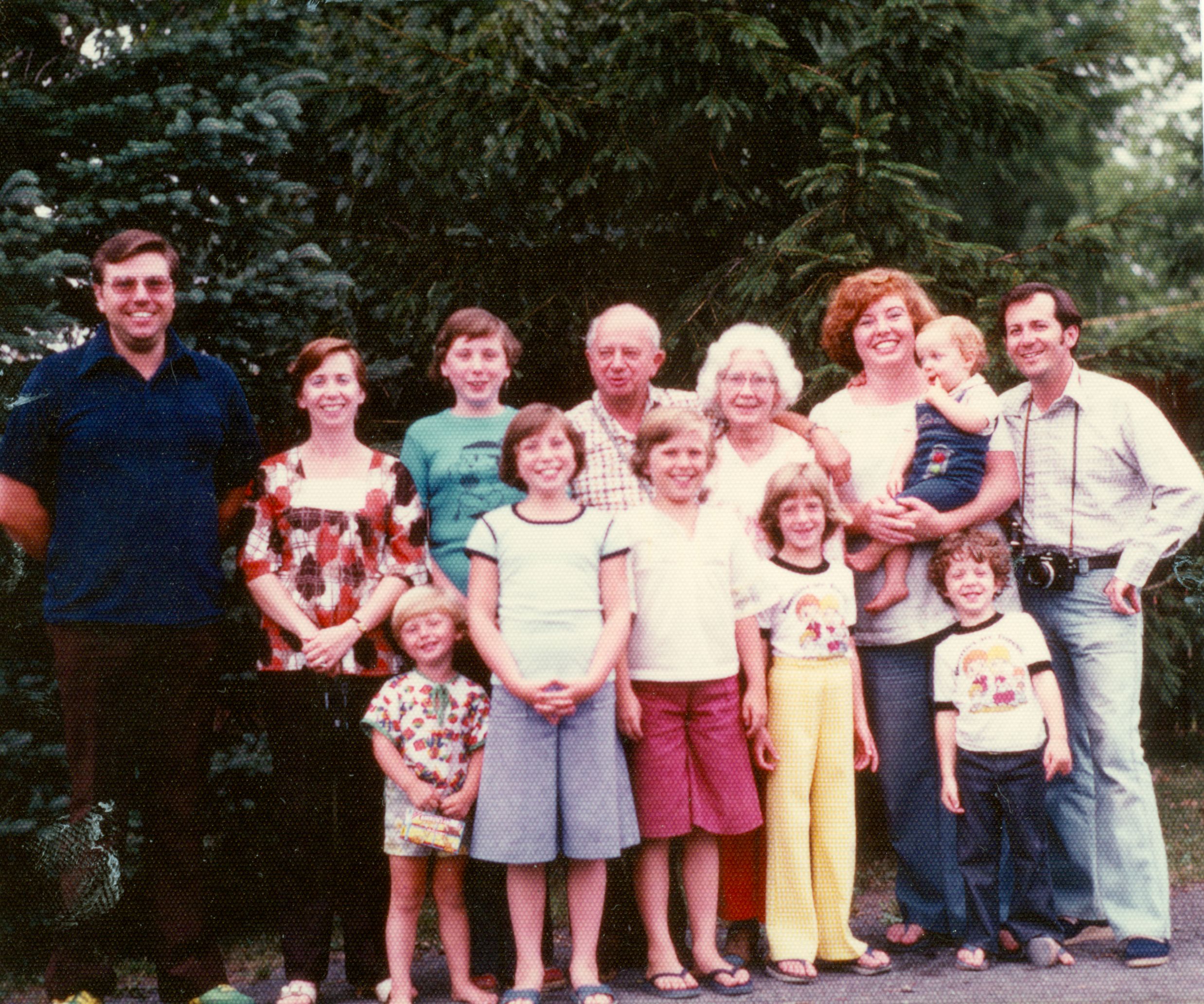 The Jehoda and MacBean families. Stephan Jehoda, an immigrant from Europe who was baptized in Montreal in 1963, became the first president of the independent Hochelaga Branch in 1969. His wife, Sandra MacBean, and her parents joined the Church in Montreal in the 1950s. Front, left to right: Cynthia, Natalie, and Lisa Jehoda, Janice and Allen MacBean; back row, left to right: Stephan Jehoda, Sandra MacBean Jehoda, Jacqueline Jehoda, Lorne and Olive MacBean, Corinne, Donald, and Stan MacBean. (Church History Library)
The Jehoda and MacBean families. Stephan Jehoda, an immigrant from Europe who was baptized in Montreal in 1963, became the first president of the independent Hochelaga Branch in 1969. His wife, Sandra MacBean, and her parents joined the Church in Montreal in the 1950s. Front, left to right: Cynthia, Natalie, and Lisa Jehoda, Janice and Allen MacBean; back row, left to right: Stephan Jehoda, Sandra MacBean Jehoda, Jacqueline Jehoda, Lorne and Olive MacBean, Corinne, Donald, and Stan MacBean. (Church History Library)
During the first fifty years of the LDS presence in Quebec, most members of the Church were English speaking, and many of these were only temporarily in the province. In the 1960s this pattern slowly began to change and gathered momentum by the end of the 1970s. During the late 1960s, a number of events took place in rapid succession that gave The Church of Jesus Christ of Latter-day Saints unprecedented exposure and secured a permanent presence in Quebec among the French-speaking people. The Mormon Tabernacle Choir came to Montreal in August 1967, where they performed at the World’s Fair Exposition on 22–23 August.[49] Shortly thereafter, a newspaper article, published on 1 October 1967 in La Patrie, reported that the Church had recently obtained official recognition in the Province of Quebec. As a result, the Church was given the right to perform legal marriages and carry on other activities permitted by other religious denominations.[50] There were then thirty-four missionaries assigned to Quebec and approximately one thousand members, of which one hundred already were French speaking.[51] This was an early indicator of the future growth of the Church. At the quarterly conference of the Ottawa-Montreal District, which took place 17–18 June 1967, French-speaking missionaries provided simultaneous translation for the French-speaking members in attendance.[52]
On 13 April 1969, J. Max Sabey, president of the Ottawa-Montreal District, visited Quebec City and formally organized the Quebec (City) Branch. Karl W. Devenport, a senior missionary, was appointed the first president of the new branch, which was only the second in Quebec (but the first independent branch) in which French was the mother tongue of many if not most members.[53] One week later, on 20 April 1969, the Hochelaga Branch, another French-language congregation, was created in Montreal.[54] Changes continued to come quickly to the Church in Quebec. The creation of the Montreal District in 1969 marked another step forward. A new spirit of hope and energy began to infuse missionary work in Quebec.
Impact of the Quiet Revolution
In what has become known as the “Quiet Revolution” (Révolution tranquille), Quebec experienced rapid social, economic, and political change, beginning in the early 1960s. Change in each of these spheres created a new setting of openness, in which the Church could gain acceptance, formal legal status, and adherents to the faith. The major transformations in society, which began with the election of the Liberal government of Jean Lesage in 1960, were largely complete by 1965. But the Quiet Revolution was an ongoing process that gradually permeated Quebec society and had a lasting effect, shaping much of the later development of the province.[55]
On the social front, the Quiet Revolution transformed Quebec from a conservative bastion to a modern secular society. The Catholic Church had long controlled public education and health care institutions, but under the reforms of the 1960s, the Catholic Church’s role in society diminished, and new legislation introduced equality for women and universal health care. Quebec’s economy was likewise transformed during the 1960s. The French phrase mâitres chez-nous (masters in our own home) implied a form of economic nationalism in which private companies, such as those providing hydroelectric power, were nationalized and came under the control of the provincial government. With economic nationalism came a much larger government which, among other things, championed use of the French language in business, education, health services, and government.[56]
At the same time, political relations between Quebec and the federal government in Ottawa grew tense. With a rising sense of nationalism and national identity, the province challenged the place of Quebec in the Canadian federation. Separatism became an option for many and an ardently desired eventuality for some.[57] All these changes, whether social, economic, or political, served to bring Quebec out of a centuries-old sociopolitical structure and into uncharted territory in which nothing was taken for granted and new possibilities abounded. In this context, The Church of Jesus Christ of Latter-day Saints was well situated to benefit from the new attitudes and intellectual openness afforded the people of Quebec.
The Church responded to these changing values and the greater opportunities for teaching the gospel in French by making the French language more available to the membership of the Church in Quebec. The Montreal District, which had been created in 1969 by a division of the Ottawa-Montreal District, included French- and English-speaking branches.[58] Stephan Jehoda, describing the challenges of meeting the needs of both language groups, recalled that in 1970, Hans Peets, president of the Montreal District, began trying to learn to speak French, and, with the support and insistence of the French-speaking leaders, Peets made efforts to speak French in district meetings and “learned very fast.” Four district councilors who could function in French were appointed in the district. The Montreal District began holding separate leadership meetings for French and English leaders so they could be instructed in their preferred language.[59] Local Church leaders began to recognize that the time was coming to teach the people in French and to organize more French-language congregations. The ensuing exposure of the Church to the general public in the Man and His World (Terre des hommes) Exhibition in 1969–70 opened the way for an acceleration of Church growth in Quebec.
The Mormon Pavilion at the Man and His World Exhibition
In 1967, Montreal hosted the World’s Fair, commonly called Expo 67. Perhaps nothing exemplified the new Quebec more than hosting such an event. Governments from 120 countries participated in what became the most successful World’s Fair of the twentieth century. The event was notable for novelty, with futuristic carnival rides and buildings, and with islands constructed in the St. Lawrence River especially for the occasion.[60]
In the years after Expo 67, beginning in 1968, the site continued to host an exhibition called Terre des hommes (Man and His World). While The Church of Jesus Christ of Latter-day Saints had not been represented at Expo 67, and although in 1968 the Church was refused a pavilion space, in 1969 an opportunity miraculously opened for a Mormon pavilion on the exhibition grounds. Having unsuccessfully offered the City of Montreal $20,000 to lease a building on site in 1968, Church leaders were amazed when city officials offered them a pavilion in 1969 for the sum of one Canadian dollar.[61] Within a short time, a beautiful visitors’ centre had been created to introduce the Latter-day Saints and their beliefs to hundreds of thousands of visitors. Called A la Recherche du Bonheur (Man’s Search for Happiness—the same name as the classic LDS film), the pavilion featured large photographs depicting various aspects of the Church and Latter-day Saint life. There were tours in French and English, and the film Man’s Search for Happiness featured prominently.[62]
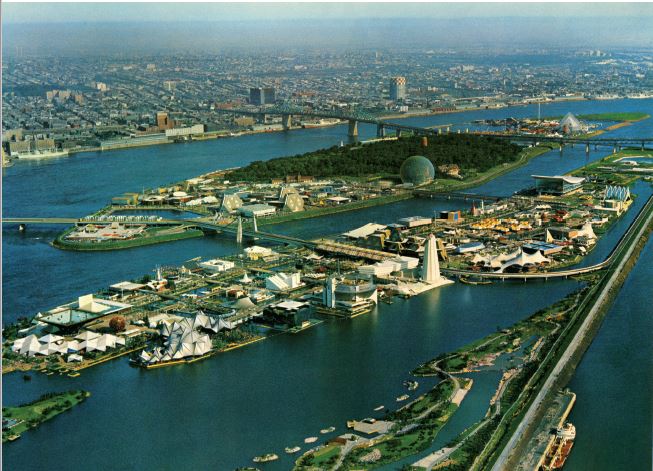 The Mormon pavilion at the Man and His World exposition in the summers of 1969 and 1970 resulted in a dramatic rise in the number of baptisms in Quebec. The exposition was held on the same location as the 1967 World’s Fair, Expo 67. (Archives de la Ville de Montréal, P67-Y_2)
The Mormon pavilion at the Man and His World exposition in the summers of 1969 and 1970 resulted in a dramatic rise in the number of baptisms in Quebec. The exposition was held on the same location as the 1967 World’s Fair, Expo 67. (Archives de la Ville de Montréal, P67-Y_2)
Roger Richards, a missionary serving in Quebec at that time, reported that for some months, missionaries were transferred to Montreal from throughout the province to serve as tour guides in the Mormon pavilion, causing missionary work in other parts of Quebec to come “to a screeching halt.” But a large group of new missionaries was sent to Quebec to follow up on the thousands of self-referrals from pavilion visitors. “The sleeping giant was now awake,” wrote Richards. “[The pavilion] changed the complexion of the Church in all of Quebec forever.”[63]
The exhibit seems to have symbolized the new Quebec and the limitless possibilities of the Church in this new, open society, and had far-reaching impact on the lives of those who experienced it firsthand. According to Leland Davey, president of the Canadian Mission at the time, more than three hundred thousand people visited the pavilion during the summer of 1969, by all counts an indicator that a significant number of people from Quebec were curious about the Church. The next year, the Mormon pavilion had more than fifty thousand visitors, prompting President Davey to say, “The pavilions of 1969 and of this summer have literally brought the Mormon Church out of obscurity in Montreal, and surrounding areas; . . . many baptisms have been the direct result of the pavilion.”[64]
Two such converts were Gérard and Linda Pelchat, who went to the exhibition in 1969 specifically to see the film, Man’s Search for Happiness. When the missionaries met with them later, Gérard, who was Catholic, had some difficulty at first accepting their message because he had always been told that his Church was the right one. The missionaries told him, “Don’t believe us if our Church is the right one—pray to find your own answer.” This greatly impressed Gérard, who followed their advice. The couple were baptized 31 October 1970, a direct result of the Man and His World pavilion. Gérard Pelchat later became the first president of Quebec’s first French-language stake, on 18 June 1978.[65]
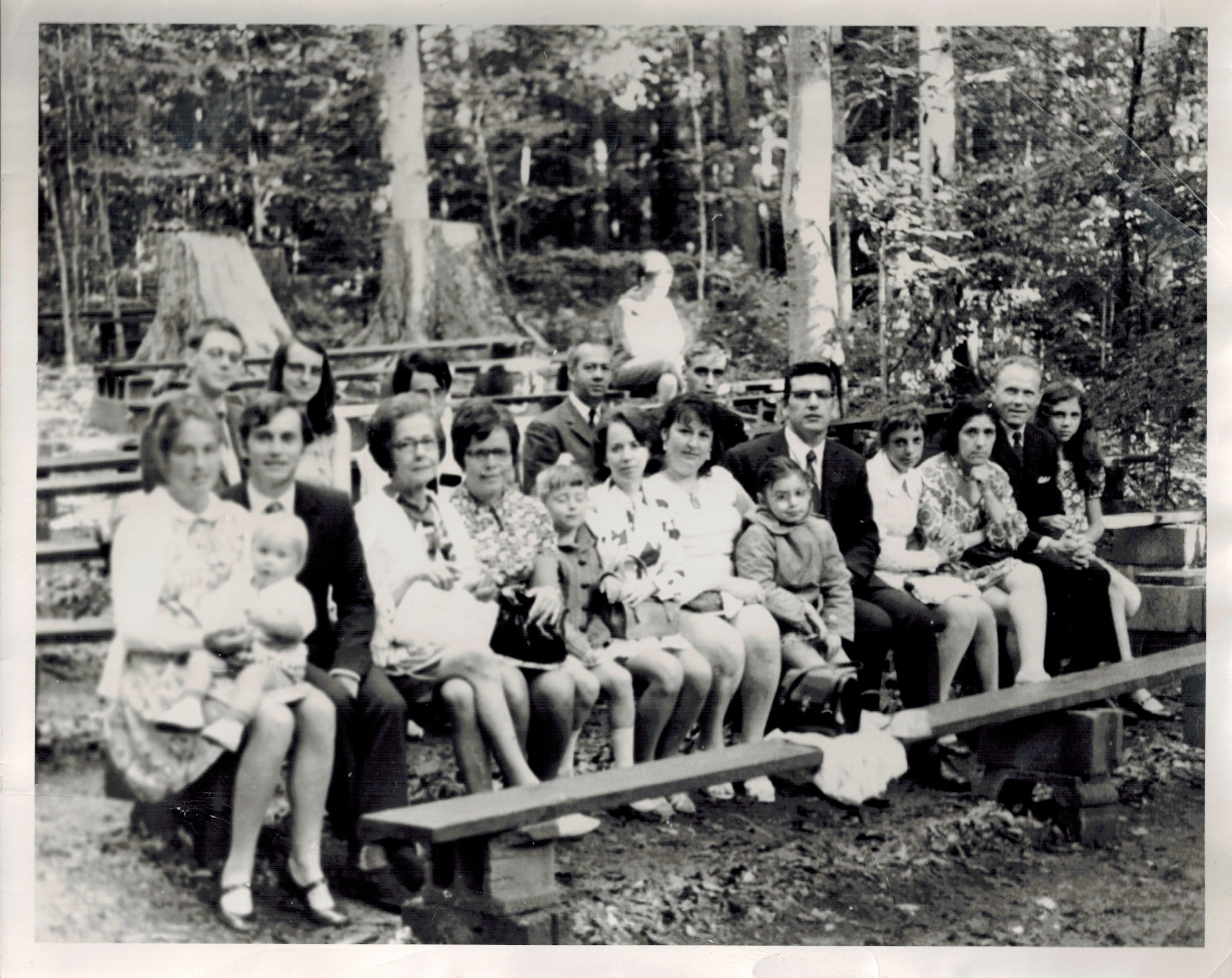 In 1971, members of the Hochelaga Branch made their first trip to Palmyra, New York, to visit important Church history sites. In this photograph, the branch members are seated in the Sacred Grove for a sacrament meeting. (Réne L’Helgoual’ch)
In 1971, members of the Hochelaga Branch made their first trip to Palmyra, New York, to visit important Church history sites. In this photograph, the branch members are seated in the Sacred Grove for a sacrament meeting. (Réne L’Helgoual’ch)
Rapid Growth of the Church in French-speaking Quebec, 1970–2016
The timeline that follows shows the rapid development of the Church in Quebec since 1969 and includes district and stake leaders in addition to mission and temple presidents. The number of first (i.e., founding) presidents of stakes and districts attests to the youth of the Church and its growth and dynamism in Quebec over these five decades.[66]
Rapid growth of the Church in Quebec followed in the decade after the Man and His World exposition, which put the LDS faith “on the map” in terms of public awareness. This public awareness multiplied the possibilities for missionary work, while the Quiet Revolution continued to open Quebec society to new ideas. Changes in how the mission was organized allowed more local control and emphasis on proselytizing in the French language. On 10 June 1970, the name of the Canadian Mission was changed to the Ontario-Quebec Mission, and two years later, on 1 July 1972, when the Ontario-Quebec Mission was officially divided, the Quebec Mission was born. For the first time, the Church in Quebec would be administered from within the province rather than from elsewhere.
Although the presidency of the Quebec Branch had made representation to Church headquarters that the seat of the mission be established in Quebec City, arguing that Quebec City was the cultural centre of the province, [67] practical considerations prevailed. Montreal was chosen as the mission base, notably because of the need to serve the larger population of the metropolitan area, plus the English-speaking population in northeastern Ontario that was far distant from Toronto.[68]
Before the Quebec Mission officially opened in July 1972, John K. Olsen, the first president, came to Montreal in April 1972 to decide on the location of the mission home. The Church real estate department had already chosen several properties in the west end of Montreal Island from which President Olsen could choose. Olsen rejected these selections because they were in predominantly English neighbourhoods. He noted that when Harold B. Lee had called him as mission president, he had emphasized the need to advance the work among French Quebecers. Olsen “felt very strongly” that the mission home should be located in a more French-speaking area of the city. Ultimately, a property at 85 Henley Avenue in the Town of Mount Royal, at that time about 50 percent French, was selected, and Olsen and his family moved into the mission home, purchased furnishings, and arranged for office space.[69] The name of the mission was changed to the Canada Montreal Mission on 20 June 1974.[70]
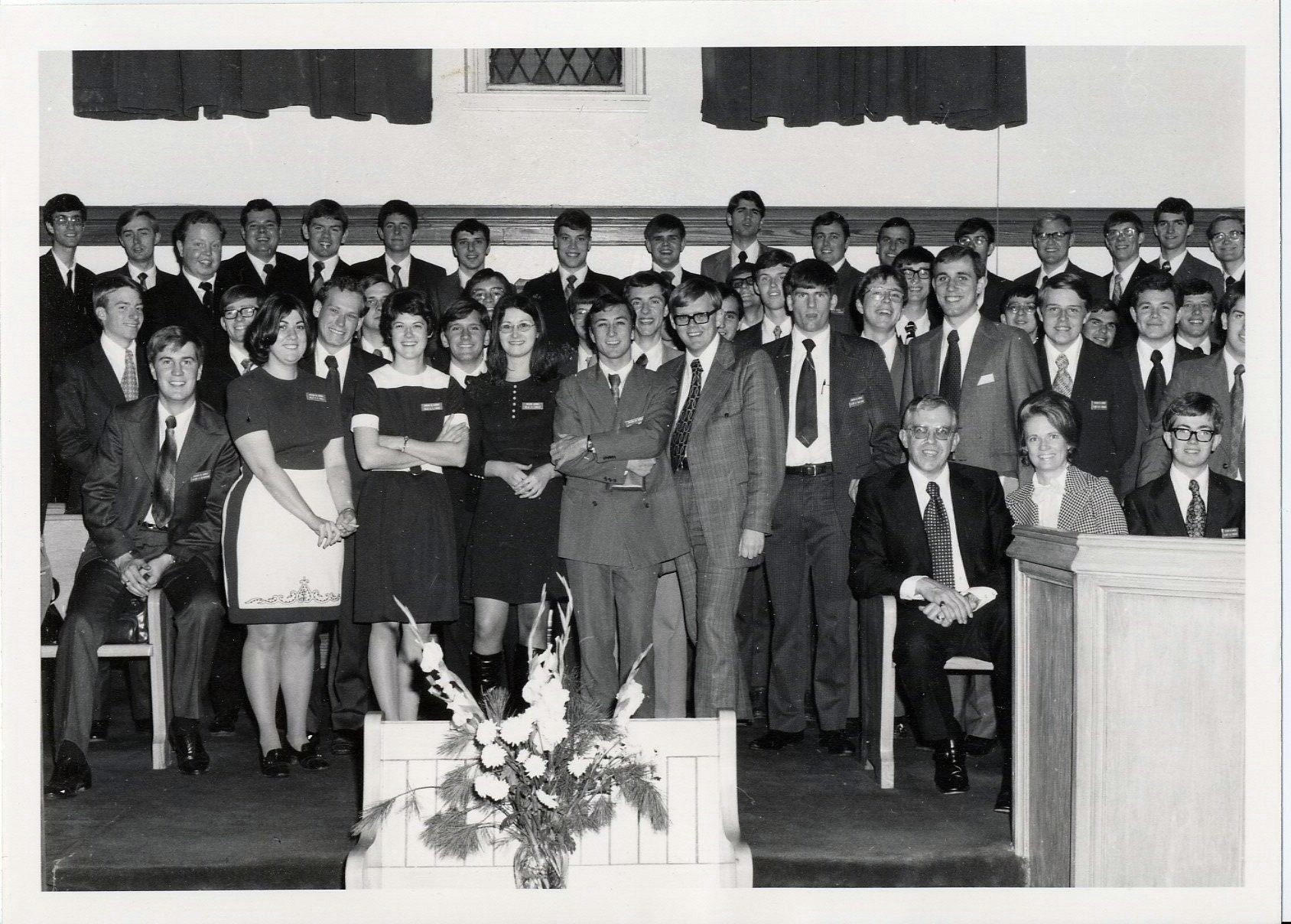 The Quebec Mission, the first LDS mission to be headquartered in the province of Quebec, was organized in July 1972. The photograph shows the first mission president, John K. M. Olsen, and his wife, Susan, in Montreal with missionaries. In 1974, the mission was renamed the Canada Montreal Mission. (Nicolas Athanassi)
The Quebec Mission, the first LDS mission to be headquartered in the province of Quebec, was organized in July 1972. The photograph shows the first mission president, John K. M. Olsen, and his wife, Susan, in Montreal with missionaries. In 1974, the mission was renamed the Canada Montreal Mission. (Nicolas Athanassi)
Church leadership took additional steps to adapt missionary work more fully to the needs of the French-speaking population. As of 18 October 1972, all missionaries assigned to speak English in Quebec were sent to the Ontario Mission. From then on, only missionaries with French-language training were assigned to Quebec.[71] By 1972, due to the growing number of French-speaking converts, conferences of the Montreal District were held in separate French and English sessions.[72] Missionary work bore fruit in other areas of the province, and by 1975 there were also dependent French-speaking branches at Trois-Rivières, Granby, Sherbrooke, Val-d’Or, and Rouyn.[73]
Further evidence of growing numbers of French-speaking members is supported by the Montreal District conference in September 1973. For the first time, separate French- and English-language sessions took place on consecutive weekends in order to reduce the confusion of having two sessions on the same weekend.[74] Linda Pelchat recalled that a Sunday School for French-speaking people began in 1974 at the Ste. Hélène Street chapel, in Longueuil, with her husband, Gérard, as teacher. She also described attending a general conference broadcast and seeing “two rows in the back of people wearing earphones,” listening to the French translation of the proceedings.[75]
Georges L. Bourget, who often acted as interpreter for visiting General Authorities in Quebec, said of his experience, “Since the Canada-Montreal Mission was created in 1972 under John Olsen, General Authorities were visiting our area quite regularly. While on assigned visits to North Eastern states or going or returning from Europe, it seemed that General Authorities took the time to visit us in Montreal. At the time, there were few French-speaking members fluent in English so I was soon asked to interpret for the Brethren from English to French. We used to do this side-by-side and sentence-by-sentence a method which was more difficult for the visiting authorities but simpler for us since we had no equipment to do otherwise. I had no training in this, but I soon learned the Church terms in English and I became the assigned interpreter. This opportunity for me was a great blessing and a faith strengthening activity in my life. I still had no training in interpretation but I used to fast for 24 hours before an assignment and soon realized that the Spirit was very strong with me and that I was able to do a decent job as an interpreter.”[76] These are examples of early efforts to bring the gospel to the French-speaking majority of Quebec.\
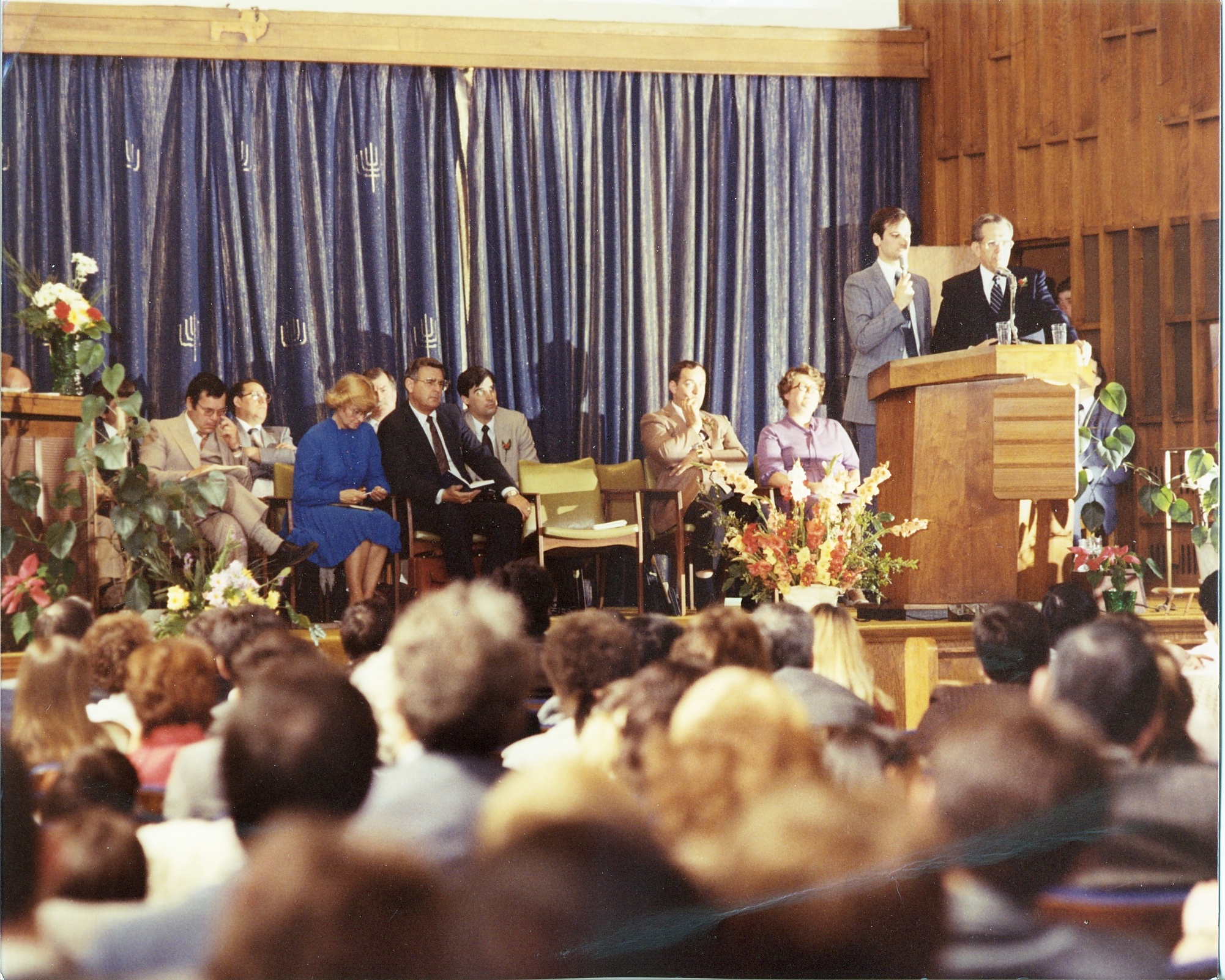 When non-French-speaking General Authorities visited conferences of the Montreal Quebec Stake, they spoke in English, and a translator standing beside them repeated their words in French. In this photo, Boyd K. Packer of the Quorum of the Twelve addressed the stake conference in May 1982. When French speakers were addressing the congregation, the General Authorities wore headphones and received English translation of the proceedings. (Linda Pelchat)
When non-French-speaking General Authorities visited conferences of the Montreal Quebec Stake, they spoke in English, and a translator standing beside them repeated their words in French. In this photo, Boyd K. Packer of the Quorum of the Twelve addressed the stake conference in May 1982. When French speakers were addressing the congregation, the General Authorities wore headphones and received English translation of the proceedings. (Linda Pelchat)
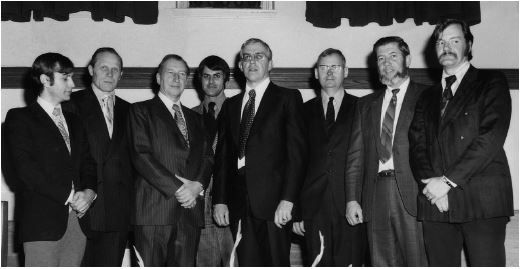 Quebec Church leaders, many of whom were French speaking, Left to right: Luc Salm, Jean Bogdaniec, Hans Peets (district president), Dan Boscovitch, John K. M. Olsen (mission president), James Davidson, Jerald Izatt (president of the Quebec City Branch), and Georges L. Bourget. Photo was taken in 1972. (Nicolas Athanassi)
Quebec Church leaders, many of whom were French speaking, Left to right: Luc Salm, Jean Bogdaniec, Hans Peets (district president), Dan Boscovitch, John K. M. Olsen (mission president), James Davidson, Jerald Izatt (president of the Quebec City Branch), and Georges L. Bourget. Photo was taken in 1972. (Nicolas Athanassi)
Additional changes took place at breakneck speed through the 1970s. On 9 September 1974, the Montreal District was divided to form the Montreal District and the Quebec District. The Montreal District included mainly English-speaking members and had the following branches: Montreal (created in 1928), Greenfield Park (1962), and Pointe Claire (1967). The new president was Thomas L. Wilde, with Chu-Jen Chia and Garth K. Palmer as counselors.
The Quebec District originally included the Quebec City and Hochelaga Branches (both created in 1969). The Quebec District’s first president was Georges L. Bourget, with Gérard Pelchat and Luc Salm as counselors.[77] The Hochelaga Branch, which had started as the dependent Montreal Second Branch (French) in 1964 and struggled for the first few years,[78] experienced rapid growth after 1969. Stephan Jehoda described how crowded their meetinghouse became, with the chapel completely filled as well as the mezzanine level.[79] Only six years after it became independent, the Hochelaga Branch was divided into three on 22 June 1975, forming the Laval Branch, covering Laval and the North Shore; the Lemoyne Branch, covering the South Shore; and the Hochelaga Branch, covering the Island of Montreal.[80] The Valleyfield Branch was created in 1976.[81]
In the Eastern Townships, a branch was formed in Drummondville in 1974, only two years after the first convert was baptized there. Prior to that time, the Drummondville Saints had been functioning as a Sunday School.[82] The Drummondville Branch was later divided to create the Sherbrooke Branch (1987) and the Victoriaville Branch (2000).[83]
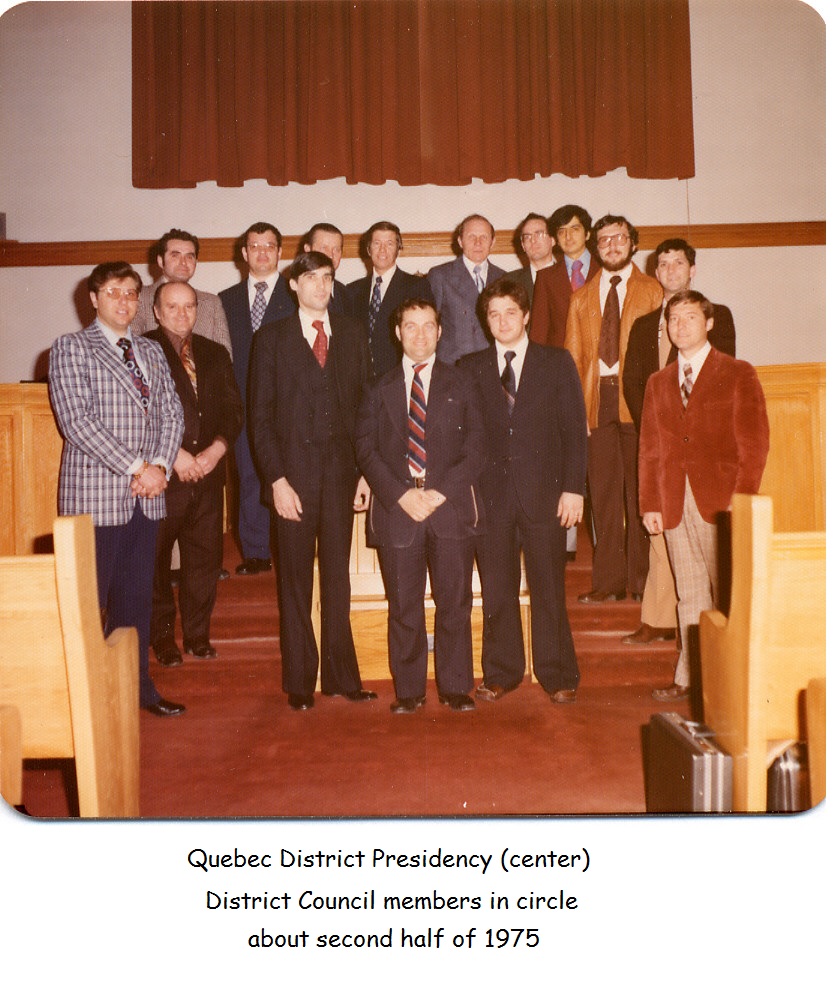 The presidency of the Quebec District, with members of the district council, 1975. Front, left to right: Michel Pelat, counselor; Gérard C. Pelchat, district president; and Alain Allard, counselor. Standing in a semicircle behind the presidency are the twelve members of the district council. (Nicolas Athanassi)
The presidency of the Quebec District, with members of the district council, 1975. Front, left to right: Michel Pelat, counselor; Gérard C. Pelchat, district president; and Alain Allard, counselor. Standing in a semicircle behind the presidency are the twelve members of the district council. (Nicolas Athanassi)
In 1975 and 1976, there was a large increase in the number of convert baptisms in the Canada Montreal Mission. For example, in September 1975 there were fifty-seven baptisms, in November 1975 there were sixty-five baptisms, and in March 1976 there were ninety convert baptisms reported.[84] Earlier, on 22–25 August 1975, Neal A. Maxwell, who had served as a missionary in Montreal in 1948 and who was in 1975 an Assistant to the Twelve, toured the Canada Montreal Mission. President Owens recorded that Elder Maxwell “saw a stake struggling to be born in our mission. . . . Many investigators received a spiritual testimony from hearing and meeting Elder Neal A. Maxwell.”[85]
Looking back on those years in a 1979 interview, Sandra Jehoda reflected on the growth of the Church in Quebec in the 1970s. She noted that Church growth among the English-speaking people was moderate, but the “French work is really rolling quickly,” to which her husband, Stephan, added, “They must be part of the Lamanites, because it seems to work. Their work is progressing faster.”[86]
In the years that followed, the Church continued to grow relatively quickly among the French-speaking people. The first French-speaking stake in Quebec (and North America) was created on 18 June 1978, at Place des Arts in Montreal, under the direction of Thomas S. Monson, then of the Quorum of the Twelve. Gérard C. Pelchat was called as stake president, with counselors Robert Gaudreau and Jean Saintonge. The new stake included the Drummondville, Hochelaga, Laval, Lemoyne, and Papineau (renamed Mascouche in 1989) Wards, along with the Valleyfield, Gatineau (formerly named Outaouais), Trois-Rivières, and Zarahemla Branches.[87] (The Gatineau Branch was transferred to the Ottawa Ontario Stake in 1990.[88])
Jean Saintonge, who served as the second counselor in the newly called stake presidency, noted how quickly the Church had grown, especially among the French-speaking members: “I was baptized in April 1966 with my parents. I was 19, single child. Except for one year at the start of my membership, I was always active and witnessed the evolution of the Church in Quebec. I am amazed, as I look back, that in the span of 12 years, we grew from a membership of a hand full of members to the creation of a Stake. No one could tell in ’66 that we would have a Temple in 2000.”[89] No wonder Saintonge was so amazed. When he and his family were baptized, they were part of the “twig,” the dependent Montreal Second Branch (French), where “there were more missionaries than members!” For him, the creation of a stake among the French-speaking members of the Church in Quebec and later the building of a temple in Montreal were miraculous events that could not have been accomplished by human hands alone, especially given the humble state of the Church in Quebec not many years before.[90]
Other miracles took place in short order. On the same day as the creation of the Montreal Quebec Stake, Georges L. Bourget was ordained to the office of high priest and set apart as the president of the Fiji Suva Mission. His wife, Huguette, said, “I knew we were going on a mission but I thought we were going in 15 years not 15 months!” The newly called stake president, Gérard C. Pelchat, told the Bourgets: “Don’t worry Georges, we will look after renting your home in St-Eustache until you return from your mission.” And that’s what he did. The Bourget family left for Fiji with their four daughters the same day as the organization of the stake and soon joined Elder Thomas S. Monson, who had presided at the stake conference, and other leaders at the mission presidents’ seminar the following day in Provo, Utah.[91]
With the rapid growth of the Church among the French-speaking population of Quebec and the creation of several new branches, the need for LDS meetinghouses became acute. In 1975, President Wayne Owens acquired for the Church the Lacordaire building (located on Lacordaire Boulevard north of Metropolitain Boulevard, in the St-Léonard sector of northeast Montreal) from La Congrégation des Soeurs de St-Paul. This building had been used as the nuns’ residence and retirement home. It was in this building that Elder Thomas S. Monson on Saturday, 17 June 1978, held Saturday meetings and conducted interviews in preparation for the creation of the stake on Sunday, which took place elsewhere.[92]
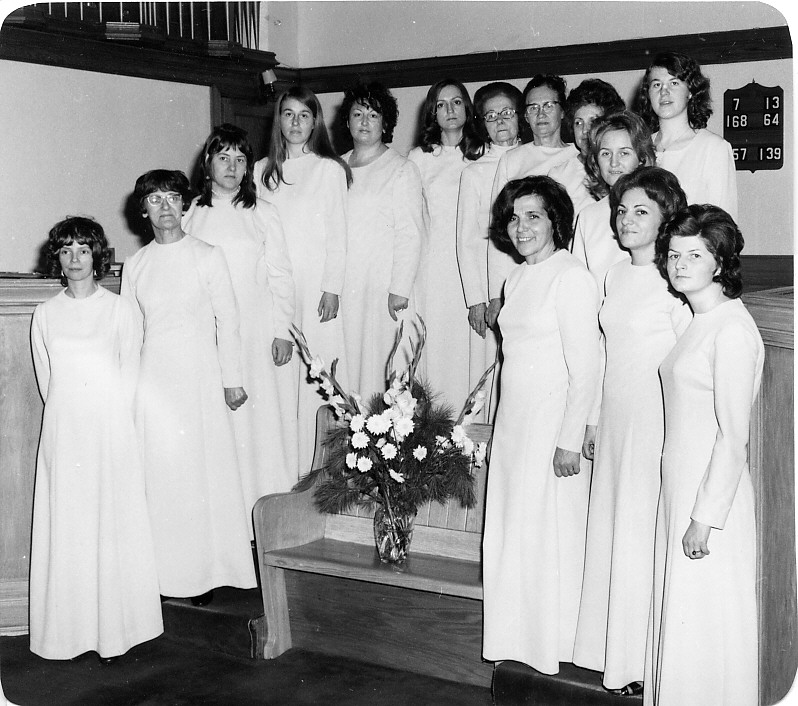 Hochelaga Branch women’s choir in 1974. Fourteen women from the Hochelaga Branch Relief Society in matching dresses they had sewn themselves, formed a choir, which performed regularly in Sunday meetings. (Nicolas Athanassi)
Hochelaga Branch women’s choir in 1974. Fourteen women from the Hochelaga Branch Relief Society in matching dresses they had sewn themselves, formed a choir, which performed regularly in Sunday meetings. (Nicolas Athanassi)
In 1977, President Owens brought forty priesthood leaders from the Quebec District to see the just-completed two-phase LDS meetinghouse in Kingston, Ontario, and to catch a vision of how LDS meetinghouses would benefit their own members. Roy A. Prete, who provided translation on the occasion, recorded that “the French brethren were thrilled with the whole experience.”[93]
After the St. Joseph Boulevard chapel fire in 1979, the Gilford chapel building was acquired by the Church. It was a former Montreal Police Fraternity building and was located almost next door to the former St. Joseph Boulevard chapel and across the street from the Laurier-sud metro station. This building is still in use and has been extensively used by the Montreal Quebec Stake and the Montreal Quebec Mount Royal Stake. Currently, it houses the Saint Laurent and Laurier YSA Branches and the mission office.[94]
Several years later, after Michel J. Carter became the second president of the Montreal Quebec Stake in 1987, he worked hard to bring real Latter-day Saint meetinghouses to Quebec. Under his leadership, several chapels were built, including the Montreal Quebec stake centre, which occupied a strategic location near the Jacques-Cartier Bridge where it was in full view to motor traffic accessing the bridge.[95]
Quebec City and Eastern Quebec
By 1966, a congregation of thirty Latter-day Saints was meeting at the Cambrai Curling Club in Quebec City.[96] Three years later, the Quebec City Branch was created, with Karl W. Devenport, a senior missionary from Idaho, as branch president. The following year, after Jerald Izatt and his family moved to Quebec City, Izatt became the branch president. Under his leadership, more emphasis was placed on using the French language in Church meetings and on expanding the influence of the mission in areas outside Montreal. Izatt also mentored Georges L. Bourget, who had joined the Church in 1971 in Quebec City and went on to become the first mission president called from Quebec.[97]
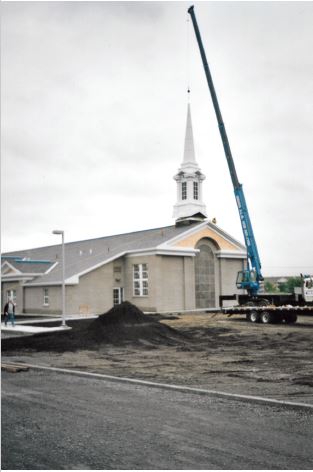 The raising of the steeple of the Quebec City meetinghouse was a dramatic moment as the long- awaited structure neared completion. The building was dedicated in 1983. (Rémy Tremblay)
The raising of the steeple of the Quebec City meetinghouse was a dramatic moment as the long- awaited structure neared completion. The building was dedicated in 1983. (Rémy Tremblay)
By the late 1960s, the Church was also being established in some of the small communities of northeastern Quebec. Demoine A. (Tex) Findlay was posted to the Royal Canadian Air Force base at Bagotville in 1965. When he arrived there in June, with his wife, Joyce, and two daughters, there was no organized branch of the Church in the area. After two American LDS families moved nearby, the Bagotville-Chicoutimi Branch was created, with Tex Findlay as branch president. The new branch was dependent on the Montreal Branch.[99]
The group held meetings in homes and later in the base chapel in Bagotville.[100] Missionaries were assigned to the area in 1967.[101] Meetings were bilingual after missionaries brought French-speaking contacts.[102] This was the beginning of the branch in Chicoutimi, which included the settlements of Arvida, Jonquière, Bagotville, Alma, and all surrounding areas.[103] Some of these jurisdictions were merged in 2002 to form the city of Saguenay, but in the 1960s they were distinct and separate communities.
There was considerable openness to the Church in those years. Grant Fletcher, a missionary assigned to the region in December 1967, reported that missionaries spoke to a group of fifty-seven Catholic priests, each of whom received a copy of the Book of Mormon. Fletcher reported that over 150 copies of the Book of Mormon were distributed to hotels, 200 copies were placed at the local college, and even the mayor’s wife accepted a copy.[104]
The first French-speaking converts in Eastern Quebec, André and Carmen Bilodeau, who had two small children, were baptized in March 1968.[105] By the time the Findlays were transferred to another military post on 6 December 1968, the branch had about forty members, but once other LDS military families left, it went into rapid decline.[106] The branch was discontinued for several years but was reorganized in 1976.[107] Over the ensuing years, the Chicoutimi Branch lost many members to other parts of Quebec due to limited employment opportunities in this remote part of the province.[108]
John Olsen, the mission president, organized the Miscellaneous Group Branch in 1973 to look after the needs of scattered Church members in Quebec who lived outside the boundaries of existing branches. Among the groups of Latter-day Saints included in this branch were those living in Noranda and Val d’Or, in northwestern Quebec. Unit leaders were appointed to administer the Church in each area under the direction of the president of the Miscellaneous Group Branch. Noel André Demers was the unit leader in Noranda; and Jean-Pierre Vallée, in Val d’Or.[109]
The Quebec Quebec District was formed 25 June 1978, one week after the creation of the Montreal Quebec Stake. The district included branches in Quebec City, Chicoutimi, and Noranda.[110] Pierre-Paul Morin, the first president of the Quebec Quebec District, said of these events, “The Quebec Quebec District included Quebec City, all of eastern Quebec to Sept-Iles, Saguenay-Lac-St-Jean, northward, and Abitibi. In fact, it included all of Quebec that was not included in the Montreal Stake. To my great surprise, I was called to be the district president. President Owens [the mission president], somewhat jokingly, told me that they didn’t have many candidates for the job. I could not believe it because at that time I was a student, with no job, no car, and no wife. But, as always, the Lord took care of the details. I was very inexperienced for this responsibility, having been converted in 1974 and only having had the benefit of serving a full-time mission. As President Hinckley once said, ‘The Lord took a chance on me.’”[111]
The difficulty for Morin and subsequent Church leaders of administering to the Quebec District was staggering. The district comprised a few small branches spread out over great distances. Most Church members were new converts who needed training and nurturing. Morin regularly hitchhiked hundreds of miles in the first years of his presidency before he had a car to visit and support the members in scattered branches.[112]
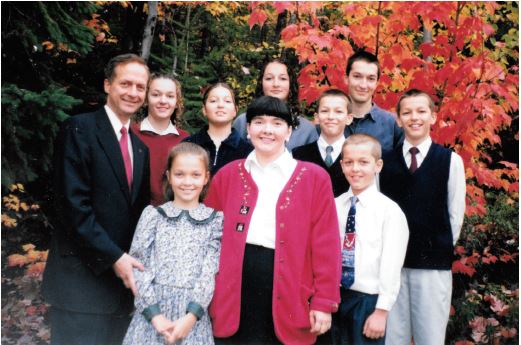 Pierre-Paul Morin and his wife, Collette, and their children in the late 1990s. In 1978, after returning from a mission to Belgium and Northern France and still single, Morin was called as the first president of the Quebec Quebec District. In 2006, he became president of the newly formed Longueuil Quebec Stake, and in 2014 he was called to be the president of the Benin Cotonou Mission. (Rémy Tremblay)
Pierre-Paul Morin and his wife, Collette, and their children in the late 1990s. In 1978, after returning from a mission to Belgium and Northern France and still single, Morin was called as the first president of the Quebec Quebec District. In 2006, he became president of the newly formed Longueuil Quebec Stake, and in 2014 he was called to be the president of the Benin Cotonou Mission. (Rémy Tremblay)
The Church began to grow in other places as well. Joseph Camille Rioux visited the Church pavilion at the Expo 67 site. He was impressed by what he saw and wanted to learn more. His brother, Émilien, who later became a stake patriarch and temple worker, recommended that missionaries be sent to Rimouski. The mission president assigned the first missionaries to Rimouski in January 1975. Joseph Rioux and four members of his family were baptized in the river in August 1975. From those times, the sacrament meeting attendance has ranged from ten to twenty members.[113] The Rimouski Branch was organized in 1979.[114] Brother Rioux, Church pioneer in Rimouski, died in 2013.[115]
On 21 October 1984, members of the newly created Alma Branch held their first meetings. Before this, they had attended Sunday services in Chicoutimi. Victorien Bouchard was the first branch president, with counselors Jean-Claude Duchesne and Patrice Proulx. The new branch held meetings in various facilities, including a school, a presbytery, and the Bouchard home. In May 1987, construction began on a meetinghouse, and by November of that year, it was sufficiently ready for branch meetings. These were happy times for the members of the Alma Branch. They enjoyed many activities together, including Christmas dinners, corn roasts, quorum brunches, and bowling competitions. Half of the active membership does its own family history work.[116]
By 1988, the total French-speaking membership in Quebec had grown to over 3,000, with 2,605 in the Montreal Quebec Stake and 488 in the Quebec Quebec District.[119] On 19 September 1988, a regional conference was held at Place des Arts in Montreal. Many French-speaking Church members in the audience were disappointed that the earphones to provide simultaneous French translation were late in arriving at the conference and were insufficient in number. M. Russell Ballard of the Quorum of the Twelve, the presiding authority at the conference, when it was his turn to speak, inquired of the congregation how many people could not understand him. Many hands were raised. Elder Ballard then invited a translator to stand beside him and translate his message into French.[120]
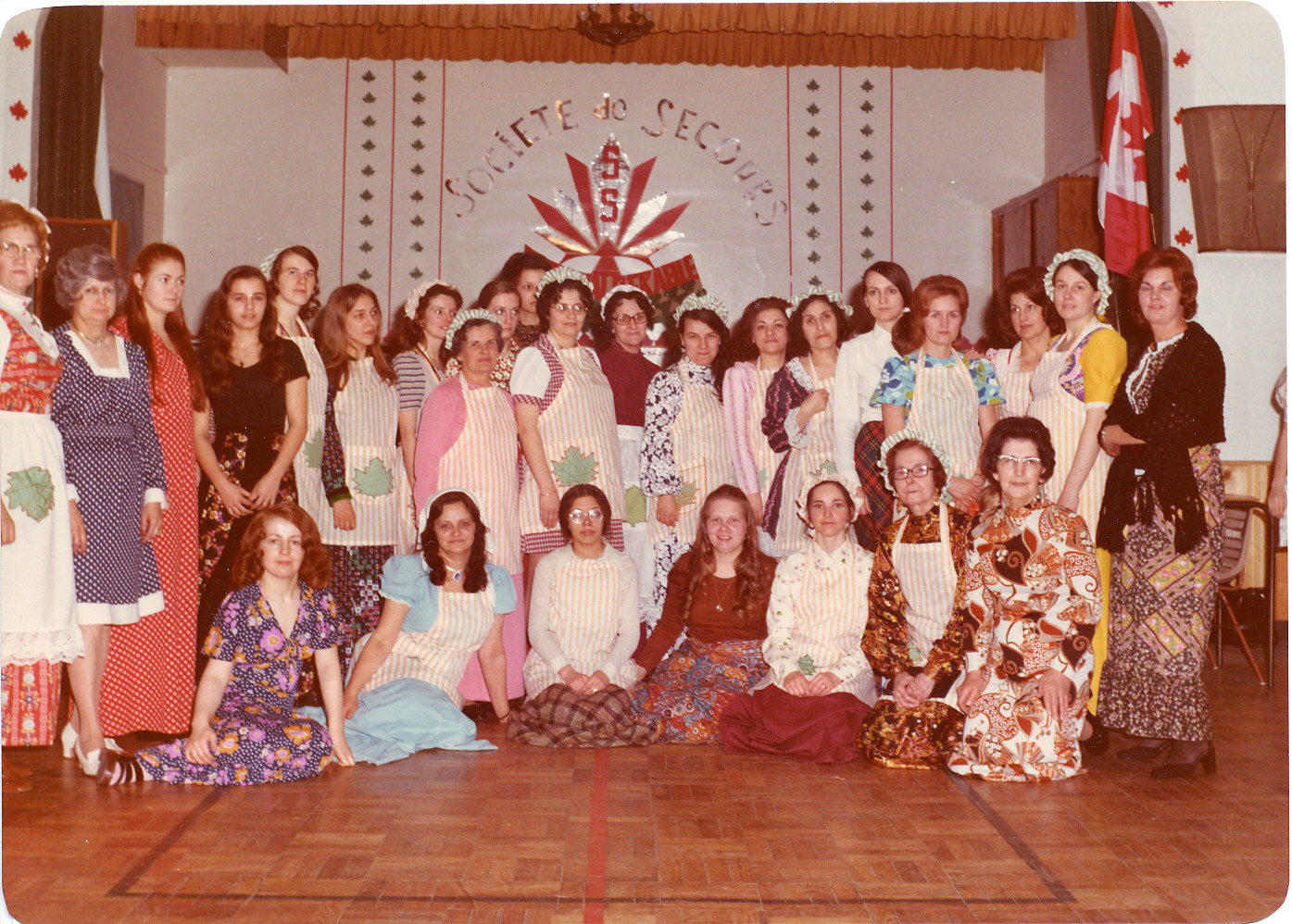 Relief Society women of the Hochelaga Ward participating in a Fête de l’Erable (Maple Sugar Festival). (Nicolas Athanassi)
Relief Society women of the Hochelaga Ward participating in a Fête de l’Erable (Maple Sugar Festival). (Nicolas Athanassi)
A report of Church membership by the Canada Montreal Mission in December 1996 listed the following membership totals: the Montreal Quebec Mount Royal Stake (with units in Ontario and New York State) included seven branches and wards, and had a total Church membership of about 2,400; the Montreal Quebec Stake (French) had thirteen branches and wards, and included about 3,500 members; the Quebec Quebec District (French) had five branches and about 600 members; and the Val d’Or Branch (which was administered directly by the mission) had 35 members.[121] Clearly, by this time, the French-speaking members had become the dominant force in the Church in Quebec.
A Second French-language Stake
Sustained growth continued among the French-speaking population, which led to the creation of several new wards and branches within the Montreal Quebec Stake and the Quebec Quebec District. Under the leadership of successive stake presidents, Gérard C. Pelchat (1978–87), Michel J. Carter (1987–96), Benoît J. Duquette (1996–99), and Sterling H. Dietze (1999–2006), the Montreal Quebec Stake added no less than seven new branches in the period from when the stake was formed in 1978, to 2005 (see table 1). Of note, two of the new units, the Monte Rey Ward and the Victoria Branch, were Spanish speaking, while new branches in Sherbrooke and St. Jean were some distance from the city. The Longueuil Branch, created in 2000, grew to be a ward by 2005, under the leadership of branch president O. Léona Caron.[122] Membership in the Montreal stake had increased to 3,809 by the end of 2005, despite the transfer of two branches, Drummondville and Trois-Rivières, to the Quebec Quebec District.[123]
There was also significant growth in the Quebec Quebec District in the same period with the transfer of two branches from the Montreal Quebec Stake in 2000[125] and the creation of new branches in Rimouski (1979), Alma (1984), and Lévis (1994, which closed, however, in 2001) and Victoriaville (2000).[126] These developments facilitated the creation of a second stake.
On 7 May 2006, Elder Neil L. Andersen of the Presidency of the Seventy organized the Longueuil Quebec Stake, the second French-language stake in Quebec, which was formed by a realignment of boundaries of the Montreal Quebec Stake and the Quebec Quebec District. The new stake included the Longueuil, Lemoyne, St. Jean, and Sherbrooke Wards and the Victoria Branch (Spanish), from the Montreal Quebec Stake; and the Quebec Ward and the Trois-Rivières, Drummondville, and Victoriaville, Branches from the Quebec District.[127]
Pierre-Paul Morin from Quebec City was selected to be the first stake president, with counselors Robert Levert and Ghislain Labbé. The centre of gravity of the new stake was nearer Montreal than Quebec City, with the majority of stake members living in the Montreal area and the headquarters of the stake being in Longueuil (a suburb southeast of Montreal), but the new stake still covered a vast area. The Longueuil Quebec Stake Centre was dedicated on 28 October 2007.[128]
The Rimouski, Chicoutimi, and Alma Branches had not initially been included in the new stake but were grouped to form the Saguenay Quebec District.[129] By 10 April 2011, as the new stake grew in strength, the Saguenay District was discontinued, and its branches became part of the Longueuil Quebec Stake.[130] The creation of new branches in Shawinigan and La Prairie in 2014 and in Granby in 2015 is further evidence of ongoing growth.[131]
The English-Speaking Church in Quebec, 1976–2016
On 12 December 1976, under the direction of Elder Thomas S. Monson of the Quorum of the Twelve, the Ottawa District, and the Montreal District were combined to create the Ottawa Ontario Stake. Combining the two districts was necessary to bring the total membership numbers within what would be expected for a stake.[133] Boyden E. Lee, previously president of the Ottawa District, was appointed as the first stake president, with Robert V. Petersen as first counselor and Ian G. Wilson as second counselor. The new stake, in addition to wards and branches from Ottawa and eastern Ontario, also included Quebec units that had formerly made up the Montreal District. These included the Montreal, Greenfield Park, Pointe Claire, and North Shore Wards and the Tung Fong Branch (a mainly Cantonese-speaking branch created 10 May 1975 and discontinued 14 November 1986).[134]
The Ottawa Ontario Stake was divided on 6 July 1980 to form a much smaller Ottawa Ontario Stake, with a membership of 1,601,[136] and the Montreal Quebec Mount Royal Stake, with membership at year-end of just 1,600.[137] The stake division was perhaps hastened by the departure of Boyden E. Lee, president of the Ottawa stake, who had accepted employment in New Mexico.[138] Ian G. Wilson was appointed president of the new stake, which included the Montreal, Greenfield Park, Pointe Claire, and North Shore Wards and the Tung Fong Branch. The stake also included the Cornwall and Hawkesbury Branches in Ontario; a ward in Potsdam, New York; and the Akwesasne Branch, an indigenous branch on the St. Regis Reserve.[139] Units in the United States (the Potsdam Ward and the Massena, Malone, and Ogdensburg Branches) were divided from the stake on 20 August 2000 to form the Potsdam District.[140]
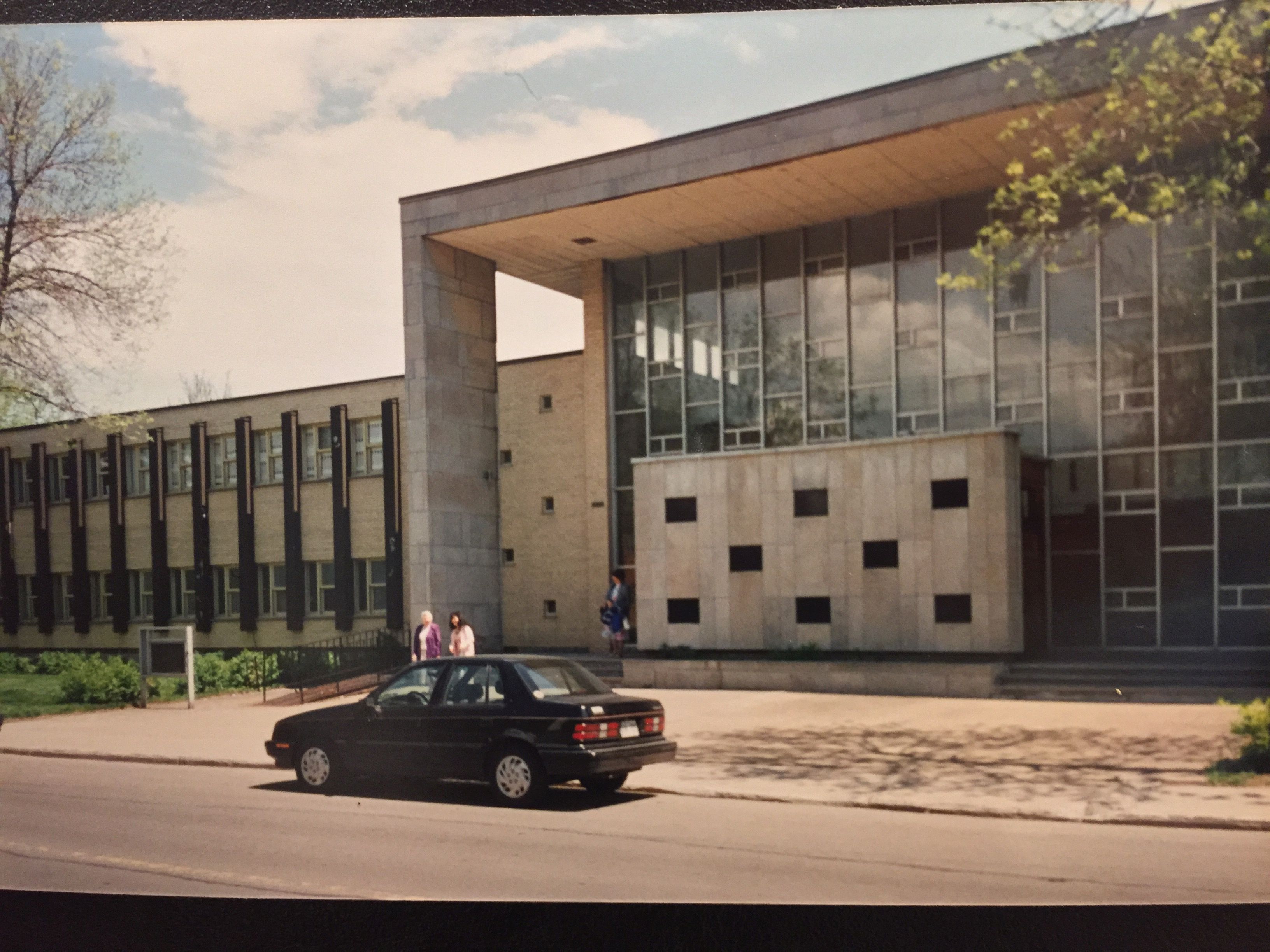 After the meetinghouse of the Montreal Ward, located on St. Joseph Boulevard, was seriously damaged by arson in 1979, the Church purchased a spacious building from the Temple Beth Sholom Jewish congregation. Church members sometimes informally referred to the building as “the synagogue.” (Catherine Jarvis)
After the meetinghouse of the Montreal Ward, located on St. Joseph Boulevard, was seriously damaged by arson in 1979, the Church purchased a spacious building from the Temple Beth Sholom Jewish congregation. Church members sometimes informally referred to the building as “the synagogue.” (Catherine Jarvis)
Despite the creation of an English-language stake based mostly in Quebec, the work among anglophones did not progress in the same way as among the French majority. In fact, it was much less dynamic, at least from a growth-in-numbers point of view. The greater rate of growth of the French-speaking stakes is evident from the fact that from its inception on 6 July 1980, the overall membership of the Montreal Quebec Mount Royal Stake remained smaller than the membership of the French-speaking stakes despite being supplemented by English-speaking units from out of the province. Total stake membership as of December 2015 reflected these trends: 2,460 members in the Montreal Quebec Stake; 3,020 members in the Longueuil Quebec Stake; and 2,161 in the Montreal Quebec Mount Royal Stake.[141]
It should be pointed out, however, that the Montreal Quebec Mount Royal Stake drew from a much smaller English-speaking population base. Despite its slow growth, the Montreal Quebec Mount Royal Stake still had a higher percentage of Latter-day Saints in the general population than its sister French stakes (see Ethnicity in Montreal on page 28). The English-speaking stake’s lower overall growth rate was in large part due to migration of English-speaking members out of Quebec to other parts of English North America, such as Toronto, Alberta, and Utah. However, the trend started to reverse itself somewhat in 2008, when the Montreal Quebec Mount Royal Stake began to increase its total membership and average sacrament meeting attendance.[142]
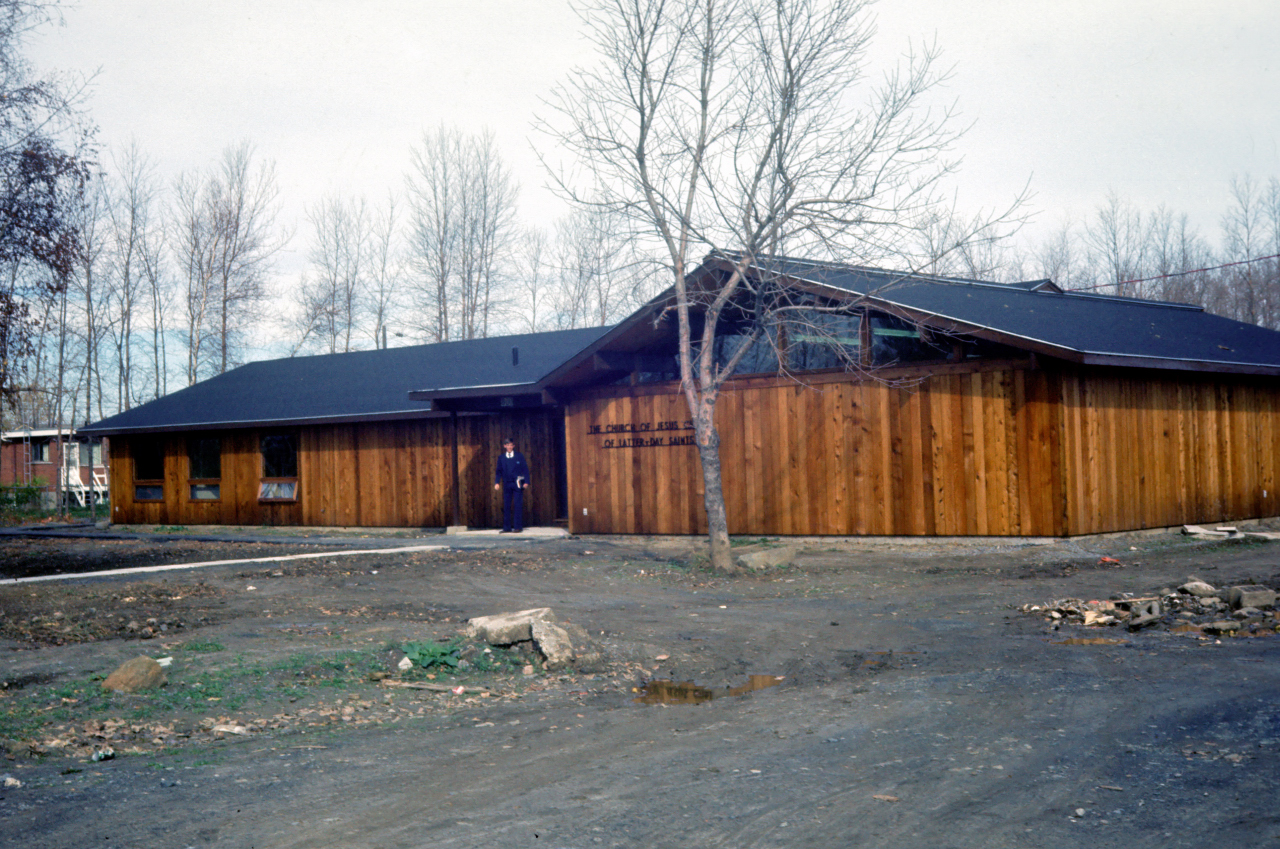 Construction of the Greenfield Park meetinghouse began in 1975. It became home to the Greenfield Park Ward of the Montreal Quebec Mount Royal Stake and the Lemoyne Ward of the Montreal Quebec Stake. (Peter Peets)
Construction of the Greenfield Park meetinghouse began in 1975. It became home to the Greenfield Park Ward of the Montreal Quebec Mount Royal Stake and the Lemoyne Ward of the Montreal Quebec Stake. (Peter Peets)
Secular Quebec nationalism, boosted by the Quiet Revolution, came into force with the founding of the Parti Québécois by René Lévesque in 1968. Lévesque’s party swept to power in 1976, with an avowed separatist agenda. Bill 101, the French-language charter establishing French as the only official language in Quebec and limiting the use of English in the province, came into effect in 1977. Lévesque’s charisma and passion inspired an ardent desire among many French Quebecers to leave the Canadian federation.[143]
During the ensuing times of political uncertainty in the years leading up to the referenda for Quebec sovereignty (1980 and 1995), for example, the overall growth of the Church in English-speaking Quebec stalled. This was most marked in the years leading up to and following the 1980 referendum. The total population of the Church in Quebec was affected by these times of uncertainty. After more than doubling from 1970 to 1978, it took five years for Church membership in Quebec to go from 3,172 in 1978 to 3,626 in 1983. During three of these years, there was actually a decline in overall Church membership in the province,[144] reflecting, at least in part, the relocation of English-speaking members from Quebec to English Canada, a trend that began in 1978 and has continued to a lesser degree to the current day.[145] Another reason for the tendency for English-speaking Latter-day Saints to leave Quebec may have been that some of these members originated in western Canada or the United States and were only temporarily in the province.
Evidence of such a decline in English-speaking membership comes from the merger of the North Shore and Pointe Claire Wards, in the Montreal Quebec Mount Royal Stake on 2 September 1980, to form a single unit: the Kirkland Ward.[146] The reason for the merger was a significant decline in the number of English-speaking Church members in the West Island and North Shore. The election of a Parti Québécois government in Quebec in 1976 and the subsequent passage of measures requiring the use of the French language prompted many businesses to relocate, resulting in an “exodus” of English-speaking people from Quebec.[147] Further evidence of language pressures on minorities in Quebec was the discontinuation of the Tung Fong Branch (mainly Cantonese speaking) on 14 November 1986, which perhaps occurred also because of Chinese members leaving Quebec for Ontario and other parts of Canada.
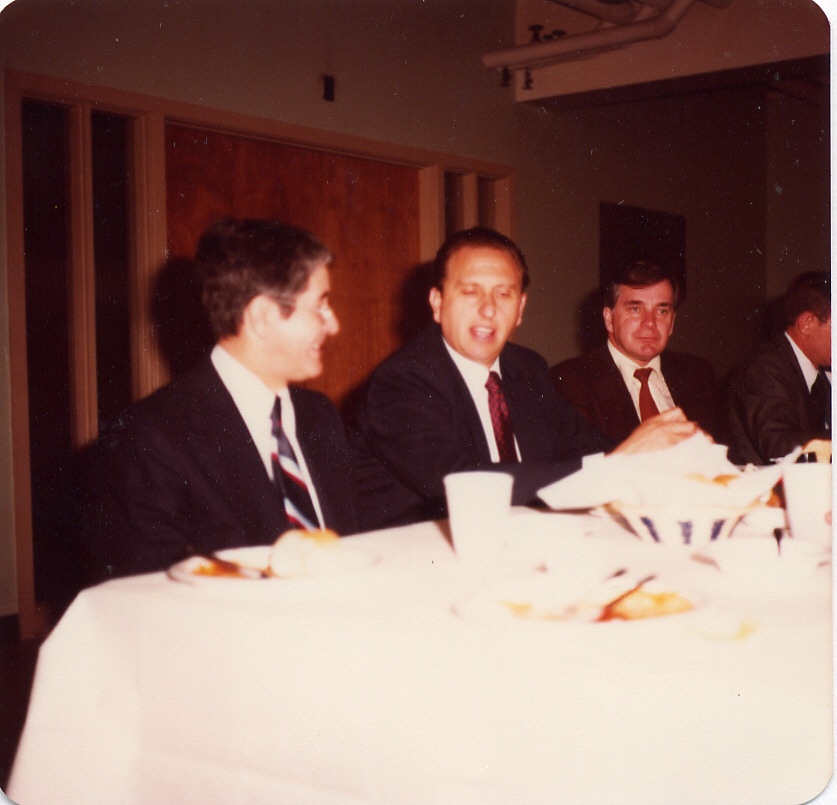 Thomas S. Monson, visiting Montreal in the late 1970s, is seated between Boyden E. Lee (on the right), president of the Ottawa Ontario Stake, and his counselor Ian G. Wilson (on the left), who became the first president of the Montreal Quebec Mount Royal Stake in 1980. (Nicolas Athanassi)
Thomas S. Monson, visiting Montreal in the late 1970s, is seated between Boyden E. Lee (on the right), president of the Ottawa Ontario Stake, and his counselor Ian G. Wilson (on the left), who became the first president of the Montreal Quebec Mount Royal Stake in 1980. (Nicolas Athanassi)
Personal recollections of English-speaking members seem to confirm these impressions. In 1979, in response to questions about the upcoming formation of an English-speaking stake in Quebec, Stephan Jehoda reflected on Bill 101, which obligated everyone to speak French as their working language. “I think our ward and the other English wards around Montreal are suffering a lot due to this situation,” he said.[148] Jehoda’s wife, Sandra, added, “Many, many people in the Pointe Claire Ward have left, and they were mostly the members who were our good, strong, stalwart ones. So we’ve really felt the pinch of it the last year or so.”[149]
Thomas Wilde, president of the Montreal Quebec Mount Royal Stake from 1989–97, recalled that the Pointe Claire Branch had been quite dynamic in the mid-1970s, until threats of Quebec separating from Canada dampened the progress. “Following the election of a separatist government in 1976, a large portion of the English community left Quebec, including many church members,” he said, making it necessary, in 1980, “to combine the North Shore and Pointe Claire [Wards] into a single unit called the Kirkland Ward.”[150] He went on to say that in the 1980s, there was a constant turnover of members, with few permanent English-speaking families remaining in the area.[151]
Ray Aloi recalled that in 1978, two-thirds of the Greenfield Park Ward left for Cornwall, Toronto, or to the western provinces.[152] Brian Lauder remembered those years well. He joined the Church in 1977 in Greenfield Park, an English-speaking ward, and saw “several families” move from the ward in the following years, including an estimated thirty-five people between 1980 and 1985. People with good jobs could usually transfer to positions in other provinces. It was a difficult time for those left behind. He and his wife finally left Quebec in 1992 for Toronto because he was worried about the economic consequences of another referendum. “It seemed the obvious thing to do,” he said.[153] Brian’s wife, Mary-Anne, was devastated by the move, but in the end felt blessed for the many opportunities Toronto gave to her.[154] Walter Svenson mentioned that in the early 1990s, the Cornwall Ontario Ward was larger than it had been before because several Spanish families had moved into the ward from Montreal due to fear of Quebec separation and in hopes of improving their employment prospects.[155]
It should be noted that these accounts differ considerably from the French Québécois point of view. According to Laurent M. Leclerc, the fear experienced by the Quebec English population during those years was the result of greatly exaggerated concerns of forced assimilation foisted upon the anglophone community by supporters of Canadian federalism in Ottawa and Quebec City.[156]
Notwithstanding these challenges, the stake continued to develop through the 1980s in spite of its transient anglophone membership, and by the end of the decade had added 650 additional members.[158] During this period, converts from neither English- nor French-language backgrounds—called “allophones” in Quebec—began increasingly to swell the ranks. Although growth in the 1990s plateaued[159] due to renewed political uncertainty and other causes, the ongoing need for larger facilities persisted. In 1995, the completion of the stake centre in LaSalle was an answer to prayers—at last the stake had a permanent home of its own! At the same time, the Montreal Ward (English speaking), which had grown too large in numbers and geography, was divided into three units: a new, pared-back ward in the centre and east of the Island of Montreal; the LaSalle Ward, around the stake centre and on the South Shore; and the St. Laurent Branch, which included a strip between the West Island and the Montreal Ward, a densely populated urban region rich in immigrants and newly baptized members.[160]
The division of the New York units from the stake in 2000 cut down immensely on travel time for leaders and members but also significantly reduced total stake membership. This put a strain on wards, branches, and the stake to fill essential callings, a problem that took a decade to ease. Other significant events included the creation of the Mount Royal Branch (Mandarin) in 2006, the designation of the St. Laurent Branch as a YSA branch in 2007, and the dedication of the De L’Orphelinat meetinghouse the same year.[161]
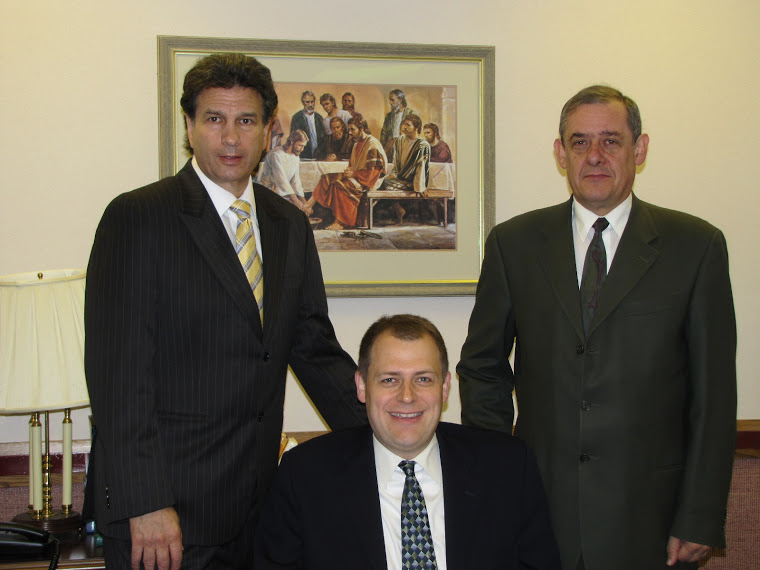 George Eric Jarvis served as president of the Montreal Quebec Mount Royal Stake from 2004 to 2013. He is shown in 2010 (centre) with his counselors, William Y. Kaufman (left) and Sérgio Morais (right). (Ronald Wong)
George Eric Jarvis served as president of the Montreal Quebec Mount Royal Stake from 2004 to 2013. He is shown in 2010 (centre) with his counselors, William Y. Kaufman (left) and Sérgio Morais (right). (Ronald Wong)
These strides forward set the stage for significant convert baptism growth from 2007–10, under the leadership of mission president Joel McKinnon and his wife, Genean Hawkins. This growth in overall membership was accompanied by important progress in the leadership of the stake such that more key positions at all levels were filled by spiritually stable men and women. Far more important than numbers or program growth over these years was the palpable spiritual maturation among the general membership, as manifested by their faith, dedication, and meaningful service in and out of the home.[162]
In sum, though enjoying much less growth than the French stakes, the Montreal Quebec Mount Royal Stake survived successive challenges and eventually added not only to its numbers but to its spiritual maturity. With just 1,600 members at its inception in 1980, the Mount Royal Stake managed over the decades to add more than 500 members to its ranks, despite some years of mass exodus and the loss in 2000 of one ward and three branches located in the United States. By 2015, the total membership of the stake stood at 2,185.[163] Most of this growth took place in the central Montreal units, while branches on the periphery did not fare as well. On 19 October 2014 the Saint Lazare Branch was discontinued due to lack of active membership,[164] and on 14 June 2015 the Montreal East Branch was designated French speaking and transferred to the Montreal Quebec Stake.[165]
The Growth of the Church among Immigrants to Quebec, 1975–2016
While the French-speaking people of Quebec were embracing the gospel and English-speaking members were leaving the province, a third demographic trend was beginning to assert itself in the Church: linguistic and ethnic diversity. Increasingly, new members of the Church were coming from allophone backgrounds, with resultant language and ethnic diversity in the stakes, wards, and branches. Reflecting this growing diversity, the Tung Fong Branch (mainly Cantonese speaking) was created 10 May 1975,[166] followed by the Zarahemla Branch (Spanish speaking) on 1 June 1978.[167] A second Spanish-speaking unit (Monte Rey Ward) was created on 16 February 1992,[168] and a third (Victoria Branch) on 10 April 2005.[169] Only five years later, in December 2010, the Victoria Branch became a ward.[170] A Mandarin-language unit (Mount Royal Branch) was created 22 January 2006.[171] In addition, a growing number of ethnic- and language-diverse converts began to fill the membership of the French- and English-language wards and branches of the Church in Quebec, especially in the Island of Montreal.
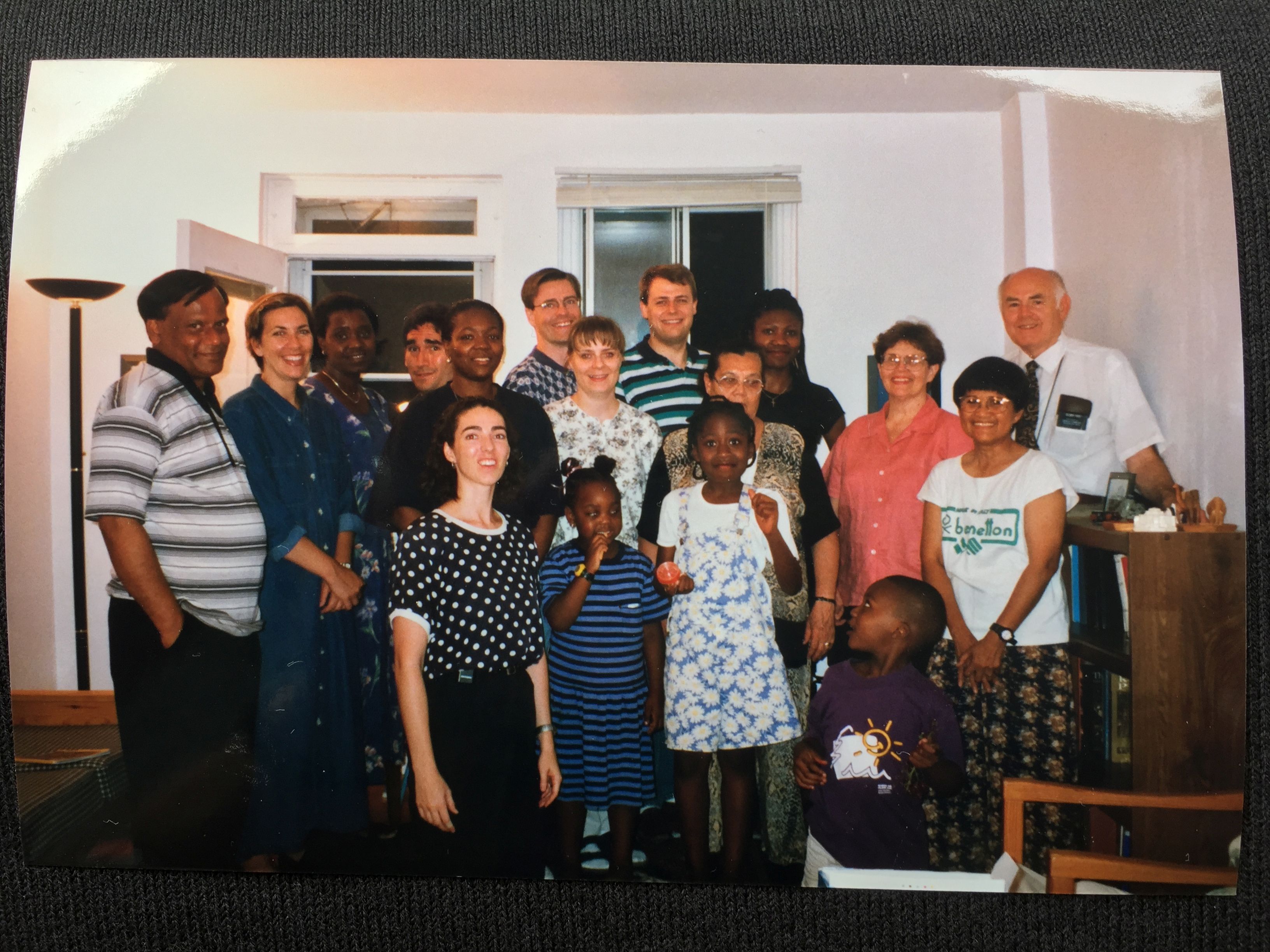 This photograph is of a gathering (family home evening) at the George Eric and Catherine Jarvis home and illustrates the ethnic diversity of the Saints in Montreal. (Catherine Jarvis)
This photograph is of a gathering (family home evening) at the George Eric and Catherine Jarvis home and illustrates the ethnic diversity of the Saints in Montreal. (Catherine Jarvis)
Although Church headquarters does not keep ethnic-membership data, some helpful approximations of diversity in the Quebec Church can be attempted. It is generally known from Canadian census data that the number of non-French and non-English people in Quebec was growing via immigration, so one might expect that this trend toward diversity would also be manifest in Church membership (see Immigrants in Montreal on page 22). However, it should be noted that immigrants are much more highly represented in the Church than in the population generally.
Considered from the point of view of ethnicity, Montreal is composed of approximately 14 percent visible minorities, whereas in the Church the percentage of visible minorities is 40 percent. By 2001, according to Canadian census data, in the metropolitan area of Montreal, 1,135 out of 2,825 Latter-day Saints were from one of the following groups: Black (260), Latin American (705), Asian (105), and other/
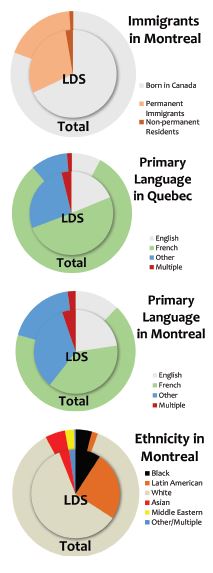
The ethnic composition of the population is reflected in the primary language claimed by each group in the 2001 Canadian census. For the province as a whole, as indicated in the figure titled Primary Language in Quebec, approximately 81 percent of the population claimed French as their primary language, about 8 percent claimed English, and 11 percent (the allophones) claimed languages other than French and English. In the Church across the whole province, just over 50 percent of members claimed French as their primary language, while approximately 19 percent claimed English, and 30 percent claimed languages other than French and English. The high percentage of English reflects the forty-year lead of proselytizing in English before it began in French, while the large allophone percentages reflect recent immigration and growth patterns.
The cosmopolitan nature of Montreal is shown in the figure titled Primary Language in Montreal, with approximately 68 percent claiming French as their primary language, 12 percent claiming English, and 20 percent claiming a language other than French or English. In the Church, approximately 38 percent claimed French as their primary language, 22 percent claimed English, and 40 percent, a language other than French or English.
In addition to these 2001 statistics, more-recent data gave further information. According to 2014 statistics from the Montreal Quebec Mount Royal Stake, 149 out of 2,262, or 7 percent of the total stake membership, belonged to the Mount Royal Branch (almost exclusively Mandarin speaking).[173] In the Longueuil Quebec Stake, 458 out of 3,215, or 14 percent of the members, were Spanish-speaking Latino Canadians, including 280 in the Victoria Ward.[174] In the Montreal Quebec Stake, 788 out of 2,776, or 28 percent, were of South or Central American origin.[175] These data are incomplete but do reflect the growth of language-minority units, particularly Spanish-speaking members, in the stakes. Many other immigrant members of the Church, such as Filipino, Haitian, Brazilian, and members from other countries, are not accounted for in these numbers.
Convert baptism data may paint a more accurate picture of the significant role of ethnic minorities in the recent growth of the Church in Quebec. For the Montreal Quebec Stake, 223 out of 676 convert baptisms from 2004 to 22 March 2015, or 33 percent, came from the two Spanish-speaking units alone.[176] A review of the convert baptisms in the French-language units of the stake over these years revealed many names of non-French and non-English origins.
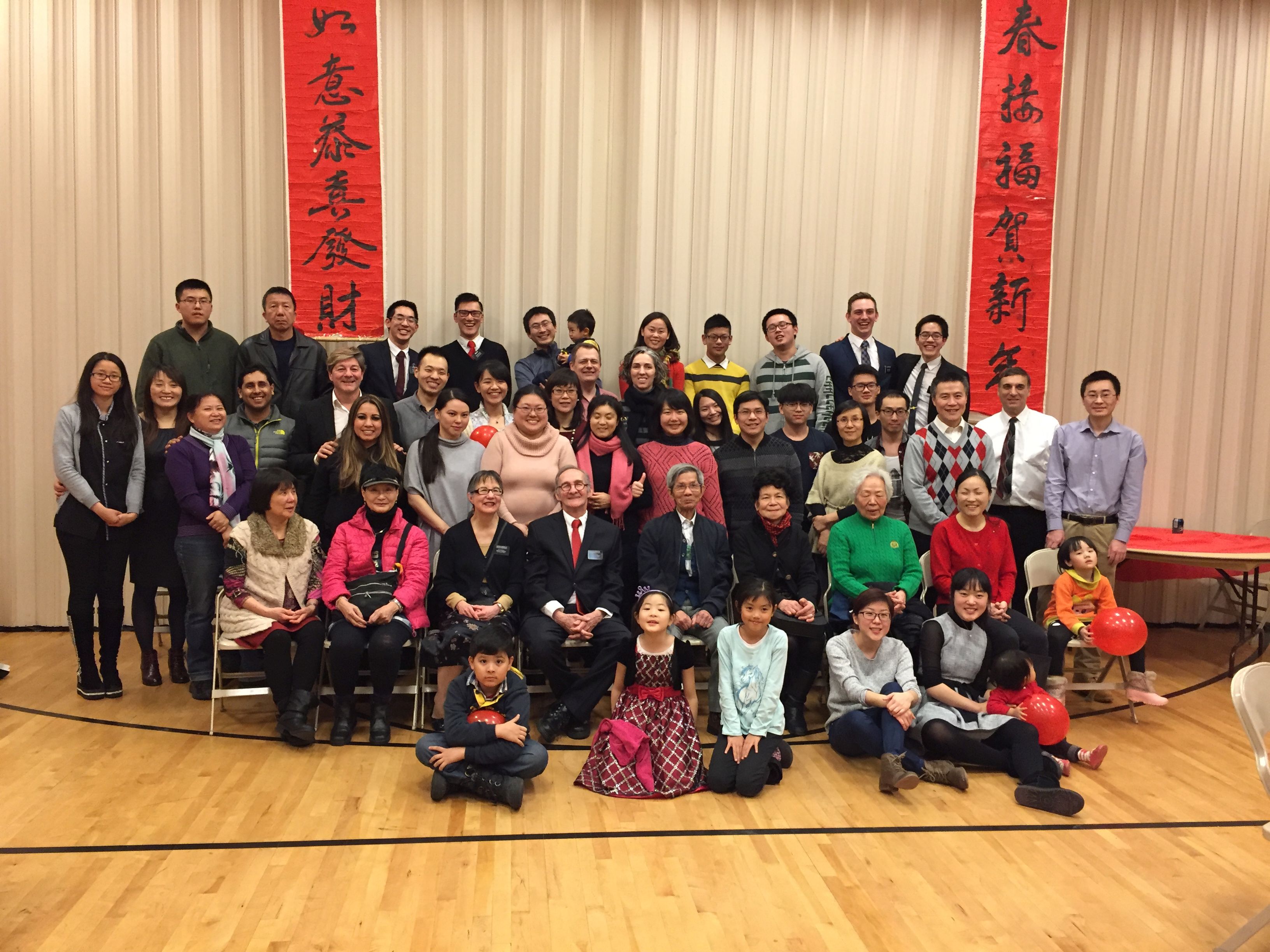 Members of the Mount Royal Branch (Mandarin) celebrate Chinese New Year in February 2016. (Catherine Jarvis)
Members of the Mount Royal Branch (Mandarin) celebrate Chinese New Year in February 2016. (Catherine Jarvis)
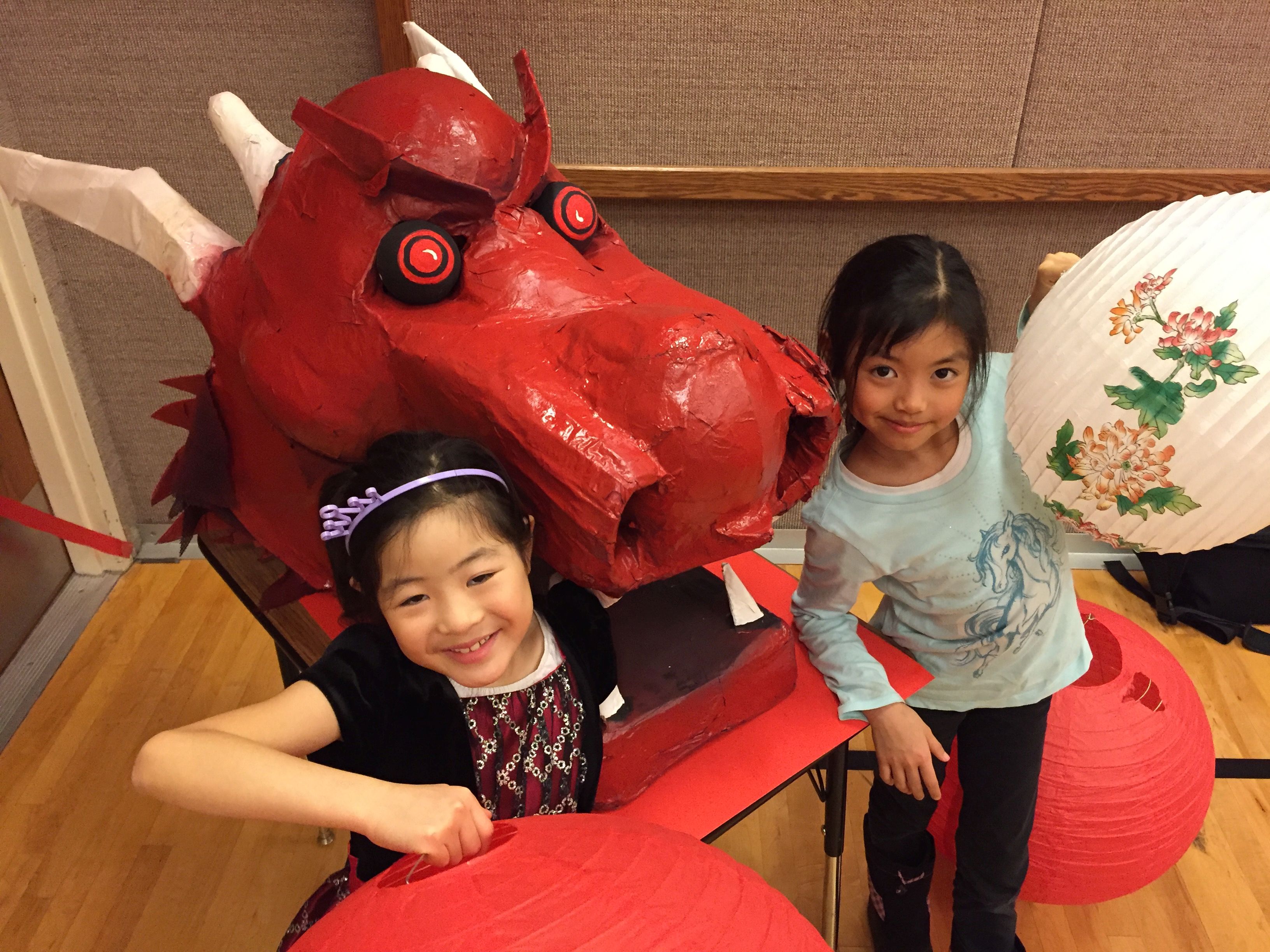 Two younger members of the branch with a traditional dragon at the 2016 Chinese New Year Celebration. (Catherine Jarvis)
Two younger members of the branch with a traditional dragon at the 2016 Chinese New Year Celebration. (Catherine Jarvis)
From 2008 to 2014, there were 334 convert baptisms in the Quebec units of the Montreal Quebec Mount Royal Stake. Of these, 213, or 64 percent of the total, were from immigrant origins, including 70 converts from the Mount Royal Branch (Mandarin) alone.[177] These figures may be an underestimate, especially of French and English Caribbean converts, but may include some newly baptized members moving to the stake from elsewhere in any given year. Ethnic diversity has also become the norm elsewhere in the province. For example, Dean Louder has estimated that one-third of the membership of the Ste-Foy Branch in Quebec City belongs to ethnic minorities.[178]
A Temple in Quebec
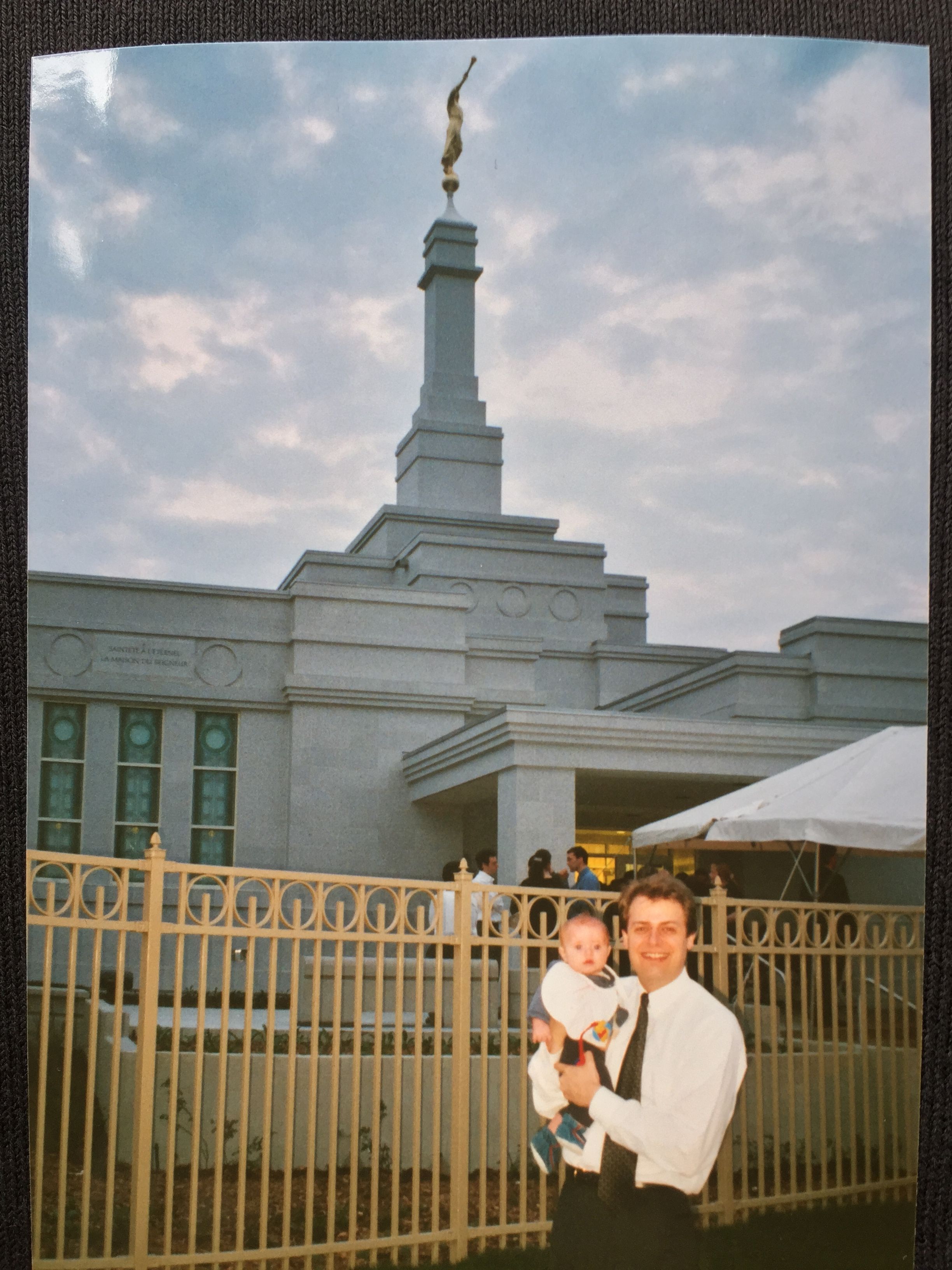 The Montreal Quebec Temple, dedicated in 2000, was a great source of joy to the Saints in Quebec. (Catherine Jarvis)
The Montreal Quebec Temple, dedicated in 2000, was a great source of joy to the Saints in Quebec. (Catherine Jarvis)
During a visit to Montreal and Quebec City on 6–7 August 1998, President Gordon B. Hinckley announced that a temple would be built in Montreal.[179] Thomas Wilde, a former stake president released the year before, said that the announcement came unexpectedly and caught local Church leaders by surprise.[180] There had been no particular efforts prior to that moment to prepare or apply for a temple in Montreal; but when President Hinckley spoke to the Montreal Latter-day Saints gathered at Place des Arts about the planned temple, the news was received with great joy, gasps of excitement, and clapping, prompting the prophet to say something to the effect, “That’s the way they reacted in Ghana!”[181]
Georges L. Bourget reported that President Hinckley actually sat down after concluding his talk and then just prior to the closing prayer stood up again and asked to speak to make the announcement of the temple. Huguette Bourget, attending that meeting with her family, stood up after the closing prayer and held up a printed banner she had prepared at home prior to the meeting, It read: “Thank you President Hinckley for the temple.” She had felt that President Hinckley would announce a new temple at that meeting.[182]
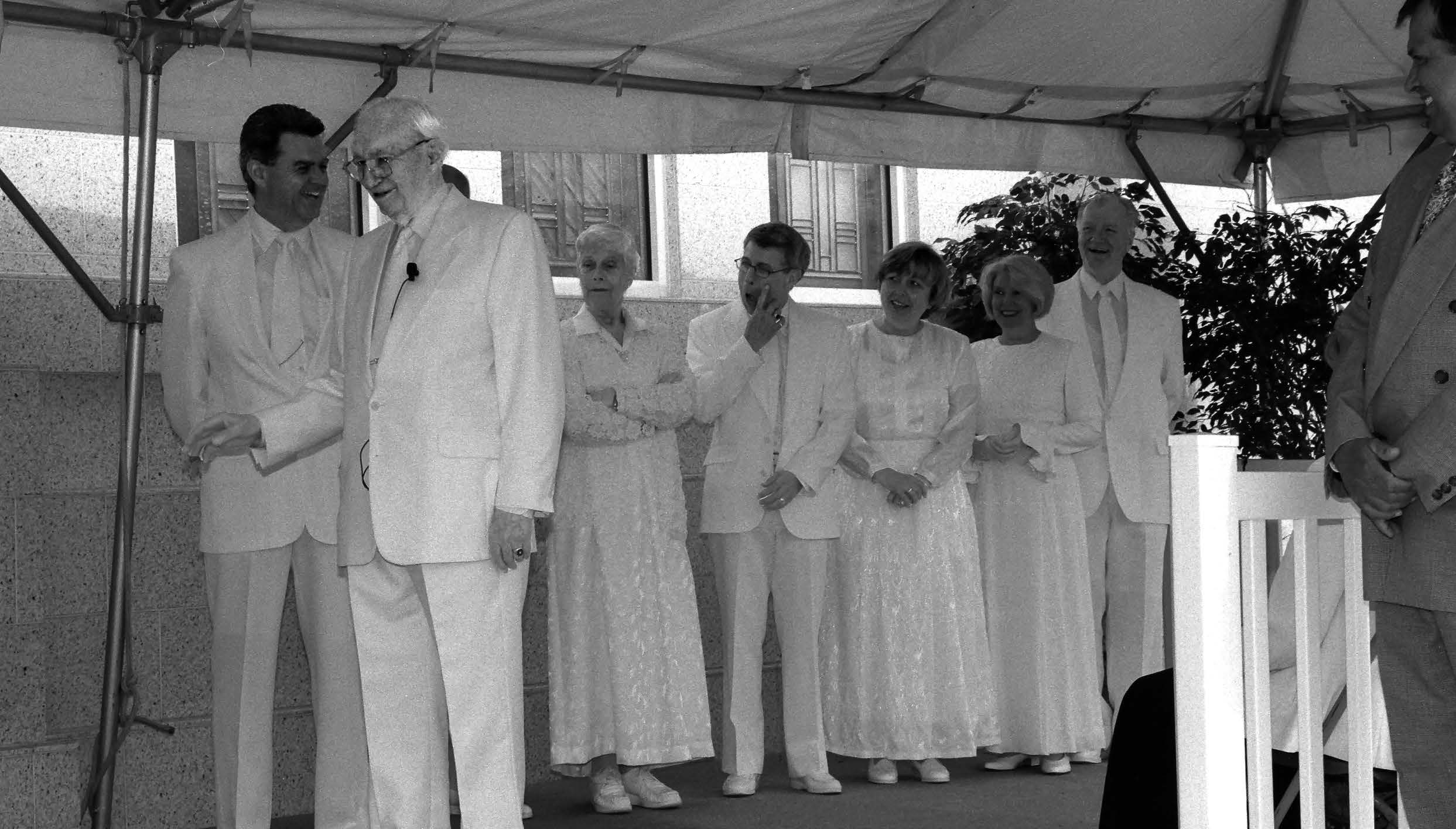 Gordon B. Hinckley, President of the Church, came to Montreal in June 2000 to dedicate the Montreal Quebec Temple. (Léona Caron)
Gordon B. Hinckley, President of the Church, came to Montreal in June 2000 to dedicate the Montreal Quebec Temple. (Léona Caron)
Eric Dumouchel described how he and his wife felt on that occasion: “The tri-lingual choir was wonderful. The discourses were inspiring. The spirit was as present as anywhere else I have felt it. At the very sight of our dear prophet my eyes welled up with tears for joy at being in his presence. My wife, on the other hand, wept when he announced that it was time for the meeting to conclude. The highlight of the meeting was when President Hinckley announced that a temple would soon be built in Montréal. (I heard ‘two years’ but my wife heard ‘a few years.’) He said that it would be a small temple but would be able to provide all of the temple ordinances but the patrons would have to acquire their own temple clothing.”[183]
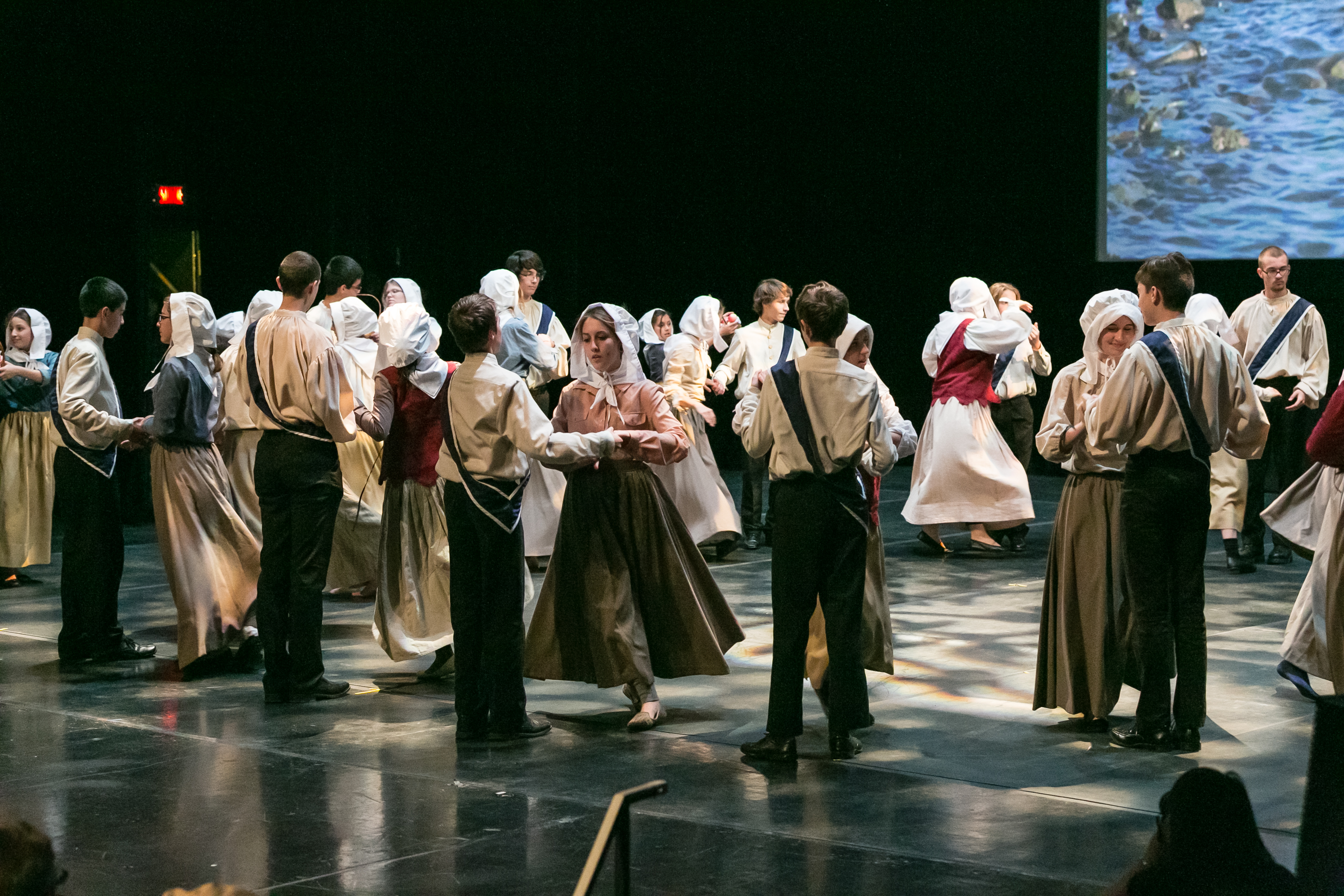 Prior to the rededication of the Montreal Temple in November 2015, youth from local stakes presented a cultural celebration. This photograph shows youth, dressed in traditional Québécois attire, portraying the culture of the early French settlers in the province. (David Brulé)
Prior to the rededication of the Montreal Temple in November 2015, youth from local stakes presented a cultural celebration. This photograph shows youth, dressed in traditional Québécois attire, portraying the culture of the early French settlers in the province. (David Brulé)
Such devotion with respect to the temple has been ongoing among the members of the Church in Quebec. Preparations proceeded quickly. Don MacFarlane, a local Church member, found the temple site that was eventually selected by President Hinckley.[184] The prayers of the Latter-day Saints for a temple were answered on 4 June 2000, when President Hinckley dedicated the Montreal Quebec Temple in Longueuil, on the south shore of the St. Lawrence River, across from Montreal.[185] Thomas S. Monson, First Counselor in the First Presidency, who had a particular connection to Church members in Quebec, having served as president of the Canadian Mission from 1959–62, having assigned the first permanent French-speaking missionaries to the province and having presided over the creation of the first French-speaking stake in 1978, also attended the dedication. The first president of the Montreal Quebec Temple was Scott H. Taggart, who had served as president of the Canada Montreal Mission from 1984–87,[186] and his counselors were Bernhard Gruber, from the Montreal Quebec Mount Royal Stake, and Georges L. Bourget, from the Montreal Quebec Stake.[187]
The temple was closed for renovations in June 2014 and was rededicated 22 November 2015 by President Henry B. Eyring of the First Presidency after extensive work on the external and internal structure. The general temple open house took place from 5 to 14 November 2015, with special VIP tours on 3–4 and 7 November. In all, there were approximately 160 VIP tours and 8,000 regular visits. A youth cultural celebration on 21 November directed by Guillaume Boudrias-Plouffe and Esther Caron, depicted the history and culture of Quebec. Major successes of the open house included the first meeting between a high-level leader of the Catholic Church, Monsignor Christian Lèpine, archbishop of Montreal, and an Area Seventy of The Church of Jesus Christ of Latter-day Saints, Elder Alain L. Allard.[188]
Other Noteworthy Developments
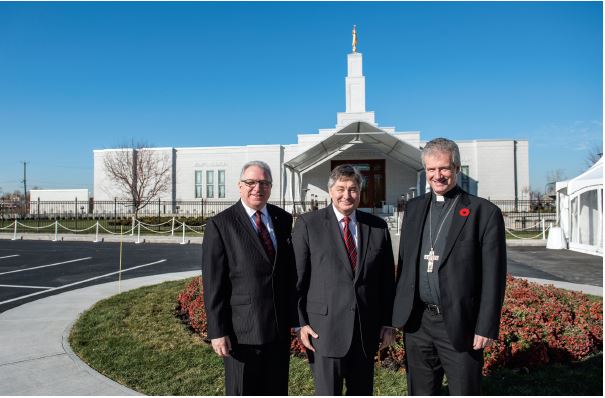 In recent years, through public affairs efforts and community service involvement, The Church of Jesus Christ of Latter-day Saints has developed improved relationships with other churches and community groups. Shown in the photograph are, Left to right, Laurent M. Leclerc, director of public affairs for the Longueuil Quebec Stake; Alain L. Allard, Area Seventy; and Christian Lépine, Catholic Archbishop of the Diocese of Montreal, at the open house of the Montreal Quebec Temple, prior to its rededication in 2015. (David Brulé)
In recent years, through public affairs efforts and community service involvement, The Church of Jesus Christ of Latter-day Saints has developed improved relationships with other churches and community groups. Shown in the photograph are, Left to right, Laurent M. Leclerc, director of public affairs for the Longueuil Quebec Stake; Alain L. Allard, Area Seventy; and Christian Lépine, Catholic Archbishop of the Diocese of Montreal, at the open house of the Montreal Quebec Temple, prior to its rededication in 2015. (David Brulé)
As the Church grew in strength and numbers in Quebec, other noteworthy developments occurred, reflecting its growing maturity. On 28 January 2007, the St. Laurent Branch, a family branch of the Montreal Quebec Mount Royal Stake, was designated a young single adult branch, the first of its kind in Quebec, with J. M. Yves Limoges as the branch president. This branch was primarily for English speaking members aged eighteen to thirty years.[189] On 9 August 2009, the Laurier Young Single Adult Branch was created in the Montreal Quebec Stake, with Bertrand Slight as branch president, and was principally French speaking.[190] Three other units were formed in the Montreal Quebec Stake: the Joliette Branch (2008), the Terrebonne Ward (2011), and the Saint-Jerome Branch (2014). However, the Joliette and Saint-Jerome Branches were later discontinued.[191]
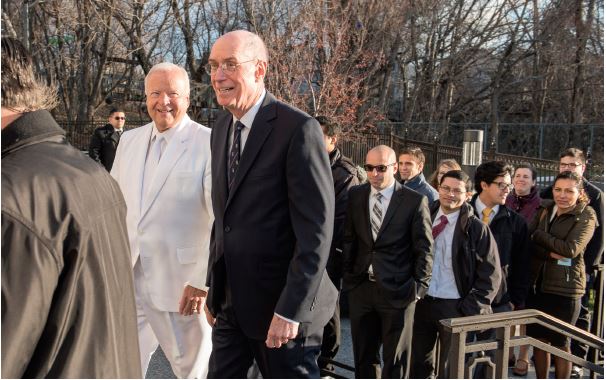 Henry B. Eyring of the First Presidency presided at the rededication of the Montreal Temple in November 2015. He is shown here arriving at the temple, accompanied by Kent F. Richards of the Seventy. (David Brulé)
Henry B. Eyring of the First Presidency presided at the rededication of the Montreal Temple in November 2015. He is shown here arriving at the temple, accompanied by Kent F. Richards of the Seventy. (David Brulé)
On 27 May 2007, a new Church meetinghouse was dedicated on Rue de L’Orphelinat.[192] This centrally located building became a heavily used meetinghouse for the Montreal Ward, the Mount Royal Branch (Mandarin), the St. Laurent YSA Branch, and the Montreal Institute. On 10 July 2011, the St. Laurent YSA Branch and the institute moved to the Gilford building, where they shared the building with the newly created Laurier YSA Branch. The Monte Rey Ward, which had recently been redesignated a branch, moved to De L’Orphelinat in place of the Saint Laurent YSA Branch.[193]
The Montreal Institute grew tremendously from 2000–16, under the leadership of the institute director, Daniel Limoges, and his wife, Johanne. They were ably assisted in 2003 by Reid and Nona Nibley,[194] who served as Church Educational System missionaries and brought together over one hundred young single adults for the first time for weekly activities.[195]
The Quebec City Institute was founded in 2009 and was managed by missionary couples called from the Longueuil Quebec Stake, the first being Monique and Daniel Couture from Mont St. Hilaire. From thirty to fifty students attended the institute, depending on the year. The institute led to the creation of the Ste-Foy Branch and increased the visibility of the Church among students and immigrants who lived nearby.[196]
On 8 July 2008, Salt Lake City approved the creation of an employment resource centre run by volunteers in the Montreal area.[197] The centre was initially located at Gilford but eventually settled at De L’Orphelinat in 2011,[198] where it provided employment services to members and nonmembers throughout the Montreal region. The first managers were Pierre and Louise Doyon, who served in this capacity for one year from 18 January 2009.[199] .
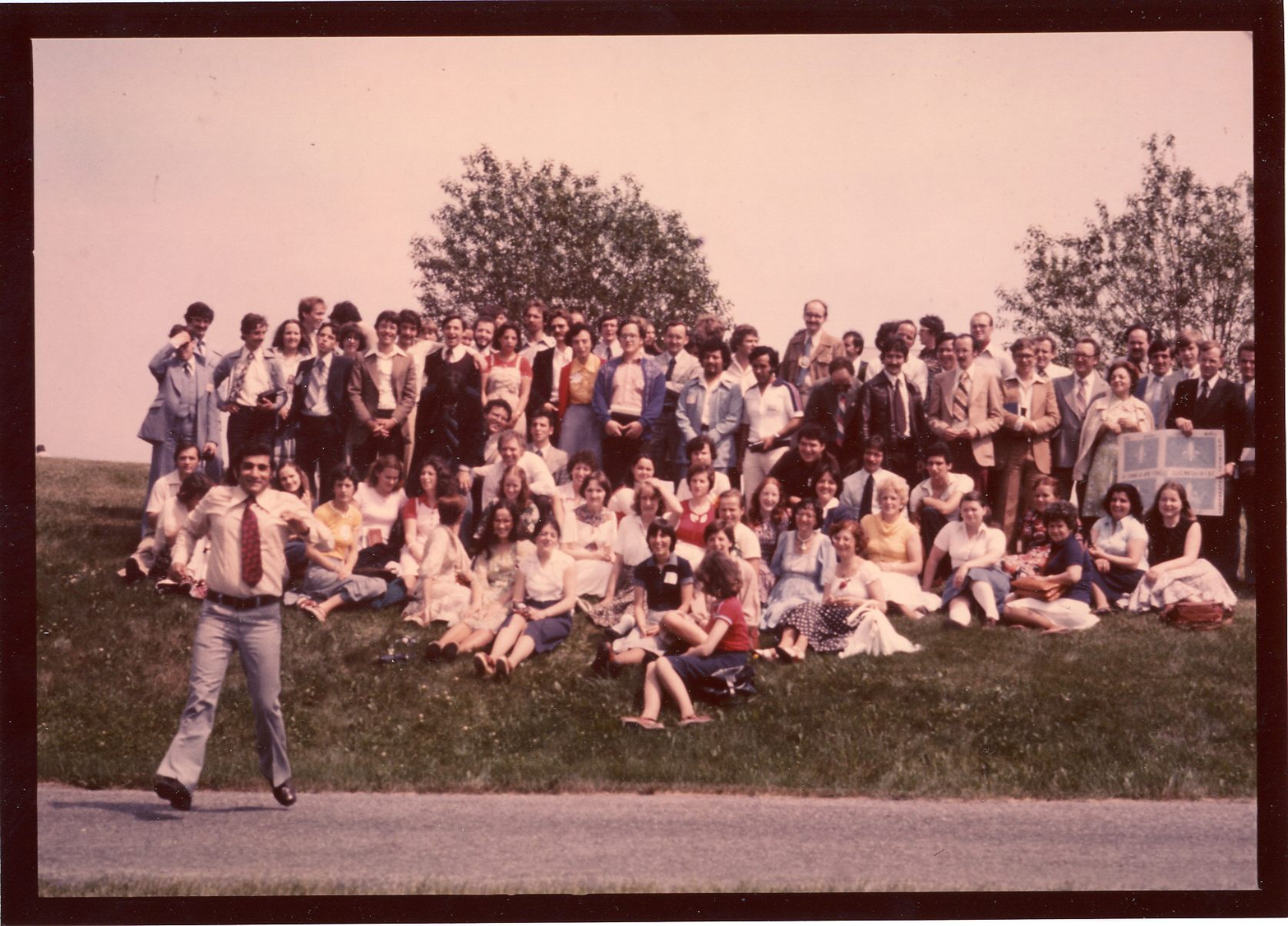 Young single adults of the Quebec District in Cap-Rouge in 1978. (Nicolas Athanassi)
Young single adults of the Quebec District in Cap-Rouge in 1978. (Nicolas Athanassi)
On 21 July 2009, Elder W. T. David Murray of the Seventy approved an addiction recovery program (ARP) for members living within the stakes of the Ottawa-Montreal Coordinating Council.[200] Stephan and Sandra Jehoda were called to direct the program. Meetings took place at the new Church building at De L’Orphelinat across the Decarie highway from the Villa Maria Metro station, beginning 8 January 2010 with five participants.[201]
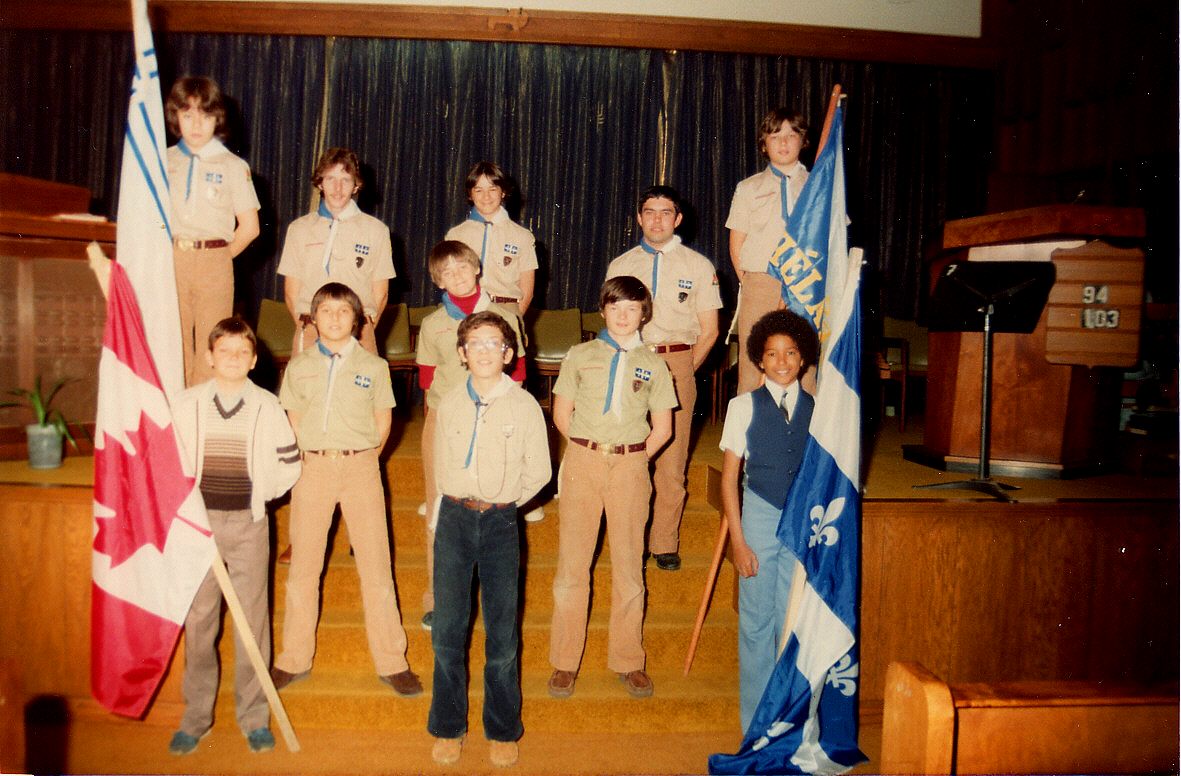 Scouting was an important part of the youth program in Quebec. This photo shows the scouts of the Hochelaga Branch, ca. 1980. (Nicolas Athanassi)
Scouting was an important part of the youth program in Quebec. This photo shows the scouts of the Hochelaga Branch, ca. 1980. (Nicolas Athanassi)
By 2016, there were thirty-seven wards and branches in Quebec, with more than half of these outside the Montreal metropolitan area. Latter-day Saint branches dot the Quebec map, from Alma, Chicoutimi, and Rimouski on the north to Valleyfield, St. Jean, and Granby on the south and from Gatineau on the west to Sherbrooke on the southeast. In addition to family history centres created in Montreal in 1982, family history centres were established in Alma, Chicoutimi, and Trois-Rivières in 2002, making research facilities available to interested genealogists, whether Church members or nonmembers, in locations convenient to many Quebec residents.[202]
The Abitibi Branch, in northwestern Quebec, first organized in 1978 and discontinued and reinstated periodically—being transferred back and forth between the Canada Montreal Mission, the Sudbury Ontario Stake, the Ottawa Ontario Stake, and the Quebec Quebec District and being combined for a time with the Temiskaming Branch—was reinstated in October 2016 as part of the Sudbury Ontario Stake.[203]
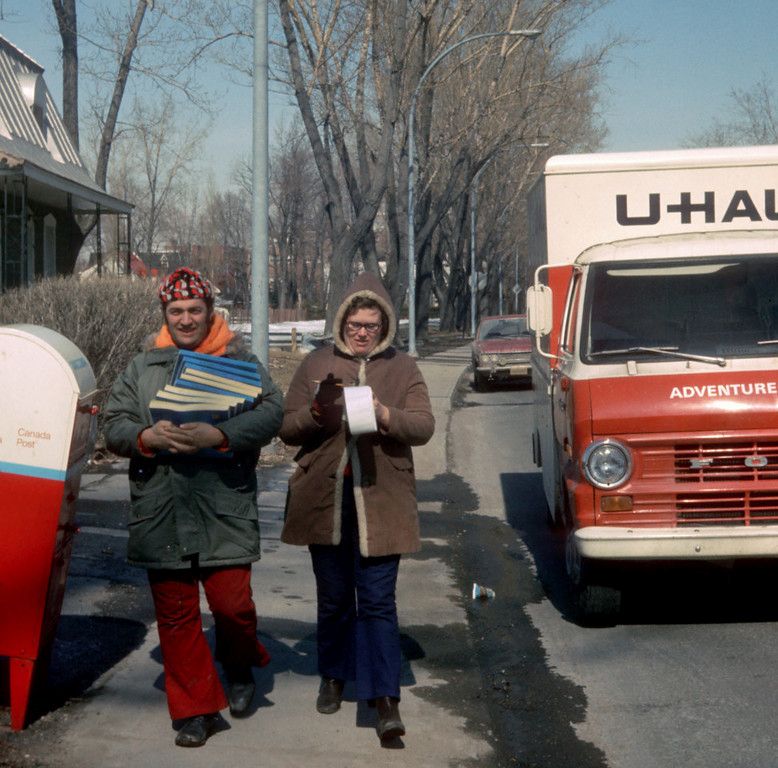 As the Church grew in Quebec, so did the need for more meetinghouses for the growing number of congregations. Fund-raising was essential to meet these needs. Gérard and Linda Pelchat are shown delivering telephone books, one of the major fund-raising activities. (Linda Pelchat)
As the Church grew in Quebec, so did the need for more meetinghouses for the growing number of congregations. Fund-raising was essential to meet these needs. Gérard and Linda Pelchat are shown delivering telephone books, one of the major fund-raising activities. (Linda Pelchat)
On 5 April 2014, Alain L. Allard, president of the Montreal Quebec Stake, was sustained in general conference as an Area Seventy.[204] His assignments included Ontario, Quebec, and the Atlantic Provinces. Allard was the first Church member from Quebec to receive such a calling.
Dedication and Sacrifice of the Members
Building the Church in Quebec has not come easily. Success has been born of the faith, dedication, and sacrifice of the members—men, women, and their families—who have worn out their lives in laying the foundation of a work larger than themselves. Examples of such dedicated service are many and varied and represent true miracles in the service of God. Of the many, many members whose ongoing devotion contributed to that process, a few are recorded here.
Linda Pelchat—The members of the Church used to sell telephone books twice per year to raise funds. The floor of the Church building sank two inches from the weight of the books that would be sold. In those years, the members needed to raise 30 percent of the funds for the local Church budget. In 1974, the branch president asked Linda’s family to pay $1,500 for the Washington D.C. Temple, and that was on top of fast offerings, tithing, and building funds, too.
As the wife of the Montreal Quebec Stake’s first president, Linda felt the burden of the calling, which was very heavy on her and was a lot of work. Her husband was often away four nights per week. She supported him through these times: “It was better than having him at a bar!” she said. Sometimes, her husband would come back from long travel assignments and fall asleep in the car as it sat parked in the driveway. “I had a testimony that the Lord wanted him to do those callings. It was not always easy—it was hard with the boys, but I tried to be supportive.”[206]
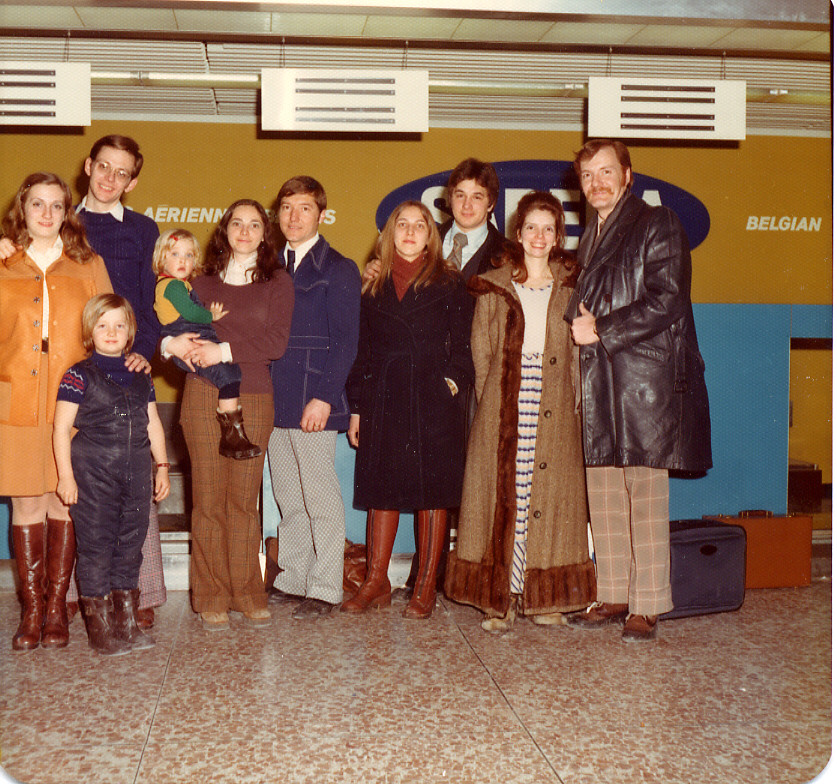 Three couples flew from Montreal to Switzerland in 1974 to receive their temple ordinances and be sealed in the Bern Switzerland Temple, where the ordinances were available in French. Two of these couples—Ghyslaine and Jean Saintonge (left), and Jocelyne and René Sénéchal (second couple from left)—and two Sénéchal children—departed for Switzerland on 16 February 1974. Nicole and Alain Allard (third couple from the left) also flew to Switzerland a week or two later to receive their temple blessings. Georges L. Bourget, the branch president, and his wife, Huguette (the couple on the right), had been to the temple previously and were at the airport seeing off the Saintonges and the Sénéchals.[211] (Nicolas Athanassi)
Three couples flew from Montreal to Switzerland in 1974 to receive their temple ordinances and be sealed in the Bern Switzerland Temple, where the ordinances were available in French. Two of these couples—Ghyslaine and Jean Saintonge (left), and Jocelyne and René Sénéchal (second couple from left)—and two Sénéchal children—departed for Switzerland on 16 February 1974. Nicole and Alain Allard (third couple from the left) also flew to Switzerland a week or two later to receive their temple blessings. Georges L. Bourget, the branch president, and his wife, Huguette (the couple on the right), had been to the temple previously and were at the airport seeing off the Saintonges and the Sénéchals.[211] (Nicolas Athanassi)
Raymond Sawyer—Late one summer day in 1998 or 1999, George Eric Jarvis was playing soccer in the street with some other members of the ward, when Bishop Sawyer approached. “He had been looking for me,” recalled Jarvis, “as one of his counselors in the bishopric, to co-sign a welfare check for a needy member. There I was playing games, and he had been out the whole evening delivering food and other supplies to the members who needed them.”[207] Bishop Sawyer’s dedication, and the humble goodness of his heart, left a lasting impression on those who knew and worked with him.
Thomas Wilde—Commenting about the period when the Montreal branches and wards were part of the Ottawa-Montreal District and the Ottawa Stake, Thomas Wilde said, “Distances were difficult. Ottawa had more leadership, so we travelled to Ottawa. We just did it! Gas was cheaper in those days. People were pretty good about it.”[208]
Walter Svenson—“During the time I was stake president [1998 to 2004], I must have travelled 600,000 km in the course of my duties. It was a very demanding time as stake president.”[209] Svenson’s wife, Sherry, also made important sacrifices. When her husband was stake president, training sessions were periodically held for bishops and their wives. Some of the leaders had to travel from far away for these meetings. Sister Svenson personally made sandwiches and other foods for them, despite the fact that she also had to travel considerable distances to attend the meetings.[210]
Ray Aloi—Before 1974, if members wanted to be sealed in the temple, they had to go to Cardston, Alberta, or Salt Lake City for English ordinances or to Cardston or Switzerland for French ordinances. In the summer of 1974, the Washington D.C. Temple open house took place. Remarkably, of the eleven young single adults (mostly nonmembers) who made the trip and toured the temple, all the nonmembers joined the Church, including Ray Aloi, Kevin Lauder, Vince Belanger, and Mildred Nagy. Carol Labelle, who also joined the group, was coming back to full Church participation, and Leonard Barnes was a member from Alberta who was studying in Montreal at the time.[212]
When Ray Aloi was bishop of the Montreal Ward (2003–09), he would take charge of preparing personalized care packages for the members during the Christmas season. Often, late into the evening, he would be working in his office at the Church on weekdays and weekends. The light from his office burned brightly long after the winter sun had set.[213]
Jean Saintonge—Conveying a quiet confidence, Jean Saintonge said, “I can only testify that it is the Lord that directs his Church and He empowers those who want to serve him, whatever they are in education, profession, social status or church callings. As such, no human organization could survive the way we direct the affairs of the Church. People are called to positions where they feel inadequate just to be released as soon as they began to be efficient. And it goes on. Just take the missionaries as an example. As the Church grows, so do the people who participate. The end product is first the people.”[217]
Michel J. Carter—Born in Drummondville, Quebec, Michel J. Carter became an important Church leader. After serving twice as a bishop and for nine and a half years as the second president of the Montreal Quebec Stake, he served from 2008 to 2011 as president of the France Toulouse (Lyon) Mission. At the time of his call as mission president, he was president and CEO of COGECO Radio-Television Inc.[218] He was called to serve as the Montreal Quebec Temple president in 2016.
Alain Allard—On 22 April 1973, there was a change of branch presidency of the Hochelaga Branch. The new second counselor was Alain Allard, the same who was called as an Area Seventy forty-one years later on 5 April 2014.[219] Elder Allard has been serving for most of the past forty years in various Church leadership positions, including president of the Montreal Quebec Stake from 2006 to 2014, a remarkable record of service for him and his family.
Contributions to Quebec Society
As the Church has grown in strength in Quebec, it has been able to reach out more and more in community service and involvement. In 2007, the Church began to formally organize a public affairs program in the Montreal region. Toronto initially provided training, but by 2009 all three Quebec stakes had public affairs committees. These committees began the work of building relationships with the larger community.
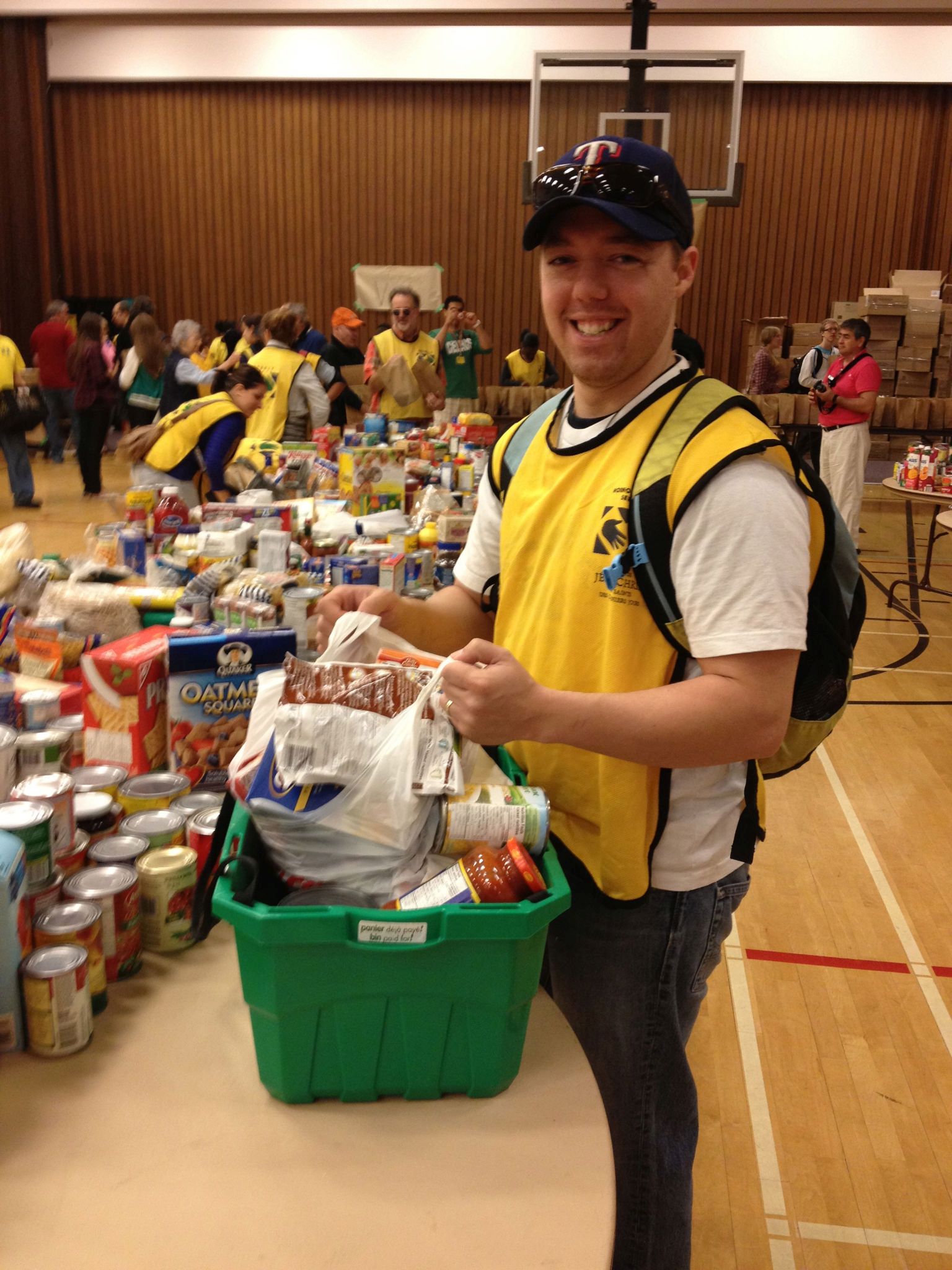 Food drives have become an important element of service for Latter-day Saints in Quebec, as elsewhere in Canada. (Courtesy of Catherine Jarvis)
Food drives have become an important element of service for Latter-day Saints in Quebec, as elsewhere in Canada. (Courtesy of Catherine Jarvis)
Efforts first focused on implementing the Mormon Helping Hands program. On 18 September 2010, the Church held its first tristake Helping Hands event in conjunction with the Great Canadian Shoreline Cleanup. Thirty Quebec congregations participated, with about four hundred Helping Hands volunteers working at two cleanup sites: Angrignon Park in Montreal and along the St. Lawrence River in the City of Longueuil.[220]
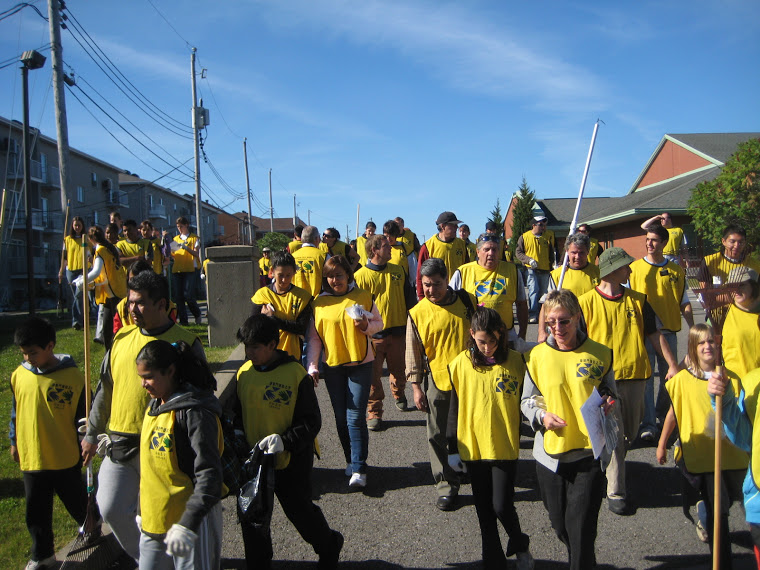 Church members wearing their Mormon Helping Hands vests participated in large numbers in the 2010 Shoreline Cleanup in Quebec. Service such as this has raised the profile of the Church in Quebec. (Ronald Wong)
Church members wearing their Mormon Helping Hands vests participated in large numbers in the 2010 Shoreline Cleanup in Quebec. Service such as this has raised the profile of the Church in Quebec. (Ronald Wong)
Outreach with the interfaith community began when the Montreal Quebec Mount Royal Stake became a member of the Christian-Jewish Dialogue of Montreal (CJDM). LDS members, led by Catherine Jarvis, contributed to the CJDM by founding the annual Interfaith EcoAction Event, which first was held in May 2011 at Mackenzie King Park in Montreal and set the stage for people of various faiths to work together in a practical expression of faith in action. LDS members from Quebec have organized and participated in these annual events since 2011 and have enjoyed working with other faith traditions in support of common values.[221]
As a week-long event from 1 to 5 November 2010, the Cégep (a publicly funded preuniversity college) in Ste-Foy, near Quebec City, hosted the ninth edition of des Journées des sciences de la religion, which focused on Mormonism.[222] This gave unprecedented attention to The Church of Jesus Christ of Latter-day Saints in Quebec City. All told, more than one thousand students from various programs of study participated with their professors, and the six thousand students of the Cégep were introduced to the history of the Church, its organization, its values, and its practices. The Cégep organizer of the event emphasized the efficiency, courtesy, and respect shown by the members of the Church who contributed to its success.[223]
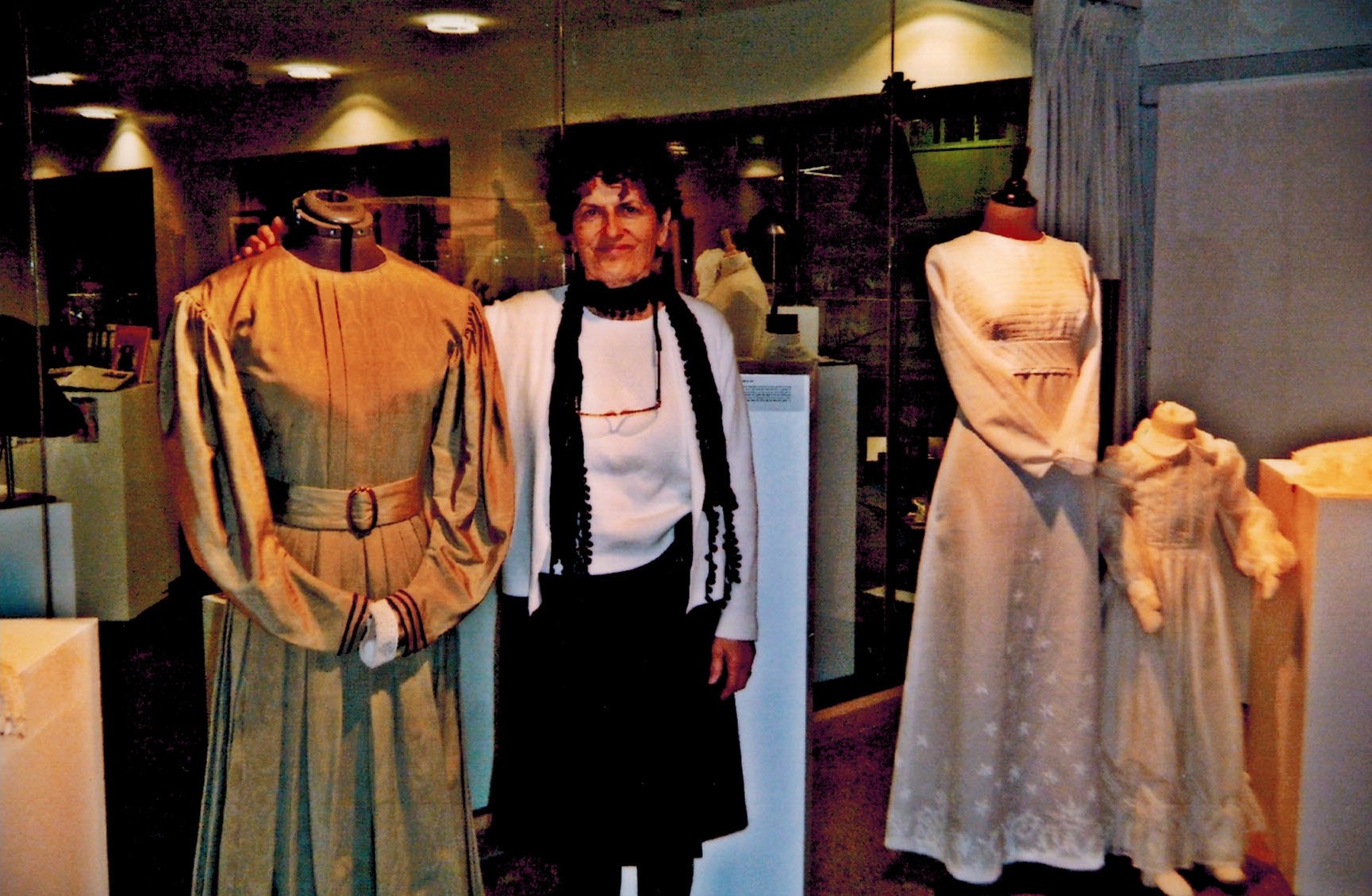 In 2010, the Cégep in Ste.-Foy focused its annual seminar (des Journées des sciences de la religion) on Mormons and invited the Church to participate. Church members, through presentations and displays, shared the history and beliefs of the Church with those attending. This photograph shows the exhibit of authentic Mormon-pioneer period clothing from the Church History Museum. Handcarts, similar to those used by Mormon pioneers to make the great trek from Nebraska to Utah, were also displayed. (Ariane Avril Caron)
In 2010, the Cégep in Ste.-Foy focused its annual seminar (des Journées des sciences de la religion) on Mormons and invited the Church to participate. Church members, through presentations and displays, shared the history and beliefs of the Church with those attending. This photograph shows the exhibit of authentic Mormon-pioneer period clothing from the Church History Museum. Handcarts, similar to those used by Mormon pioneers to make the great trek from Nebraska to Utah, were also displayed. (Ariane Avril Caron)
In June 2011, southern Quebec experienced its worst natural disaster in over 140 years, and Mormon Helping Hands assisted with the cleanup. The Richelieu Valley flooded after two months of record daily rainfalls from March to May. The flooding resulted in excess of 78 million dollars of damage to approximately 2,650 homes and 330 cottages.[224] President Pierre-Paul Morin of the Longueuil Quebec Stake offered the fourteen congregations under his direction as volunteers in the cleanup efforts. When news of the project spread throughout eastern Canada, more than 550 members from congregations in Quebec, Ontario, and the Atlantic Provinces came to participate. Laurent M. Leclerc, director of public affairs for the Longueuil Quebec Stake, and Omer Pirlet, then a member of the stake high council, coordinated the Helping Hands efforts in partnership with local authorities.[225]
The Mormon Helping Hands efforts during the Richelieu flood cleanup was a significant moment for the LDS community in Quebec, as the following report from Perry Spice indicates: “The retired President of our Quebec affiliate, Lionel Tremblay, just called me and brought tears to my eyes. He said, ‘I have just two words for you people—Merci Beaucoup!’ He lives in the Richelieu region, although his house was not directly threatened. His daughter’s house is on a hill, so while it was surrounded with water, her family was OK. But he said he was there on Saturday and saw the Helping Hands group. He said they were ‘sensational.’ Singing, working very hard and impressing everyone. Apparently they were on TV several times, and even the police were praising them for something—he didn’t get specific there. But he did say, and this is a translation of his quote, ‘The Mormons are viewed very well here in Quebec now! Your people were magnificent. Please thank them heartily for all of us.’”[226]
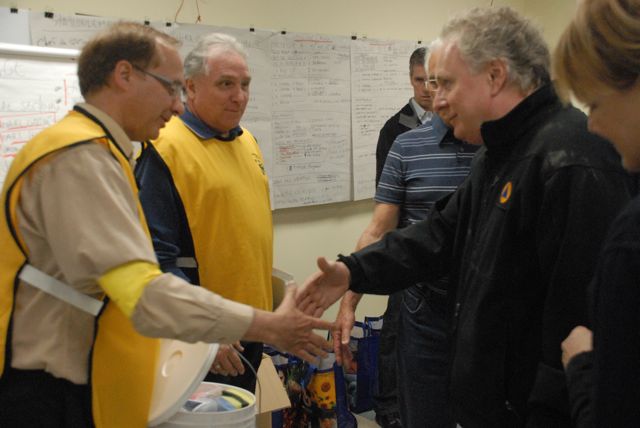 Jean Charest, the premier of Quebec, visited a group of LDS volunteers wearing Mormon Helping Hands vests as they organized supplies for the Richelieu River flood cleanup in 2011. Charest is shown commending Pierre-Paul Morin, president of the Longueuil Quebec Stake (on the left), for the group’s community service. Next to Morin is Laurent M. Leclerc, director of public affairs for the Longueuil Quebec Stake. (Courtesy Nadia Battani)
Jean Charest, the premier of Quebec, visited a group of LDS volunteers wearing Mormon Helping Hands vests as they organized supplies for the Richelieu River flood cleanup in 2011. Charest is shown commending Pierre-Paul Morin, president of the Longueuil Quebec Stake (on the left), for the group’s community service. Next to Morin is Laurent M. Leclerc, director of public affairs for the Longueuil Quebec Stake. (Courtesy Nadia Battani)
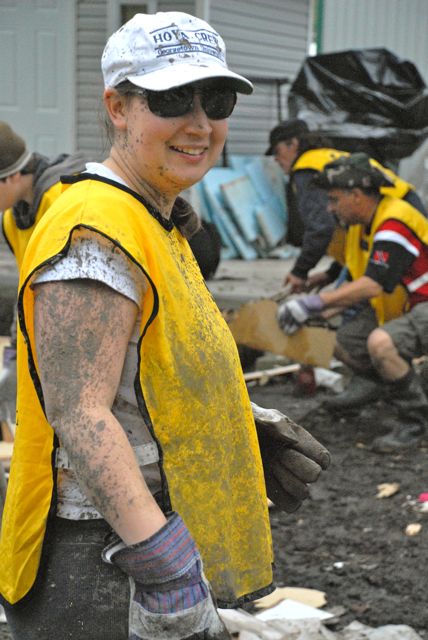
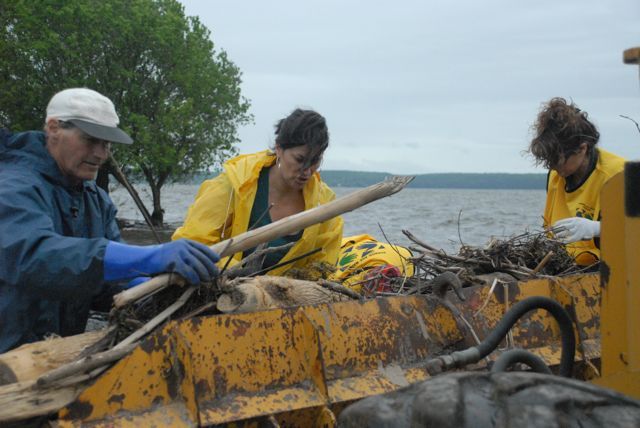 Mormon Helping Hands volunteers assisting with the Richelieu flood cleanup in 2011. (Nadia Battani)
Mormon Helping Hands volunteers assisting with the Richelieu flood cleanup in 2011. (Nadia Battani)
This experience led Church public affairs in Quebec to forge a partnership with the Quebec Red Cross. Initially, The Red Cross worked with the Latter-day Saints on a trial basis, but since then it has requested LDS volunteers for various disaster-relief and service projects.
On 14 April 2013, local stakes hosted the thirty-fourth annual Christian commemoration of the Shoah (Holocaust). This came at the invitation of the Christian-Jewish Dialogue of Montreal, which invites a different Christian church each year to work with members of Montreal’s Jewish communities in a shared act of remembrance of the Shoah. Approximately 250 persons attended the event, which included music, prayers, testimony from a Holocaust survivor, and a candle-lighting ceremony. Rabbi Lisa Grushcow and Cantor Rachelle Schubert of Temple Emanu-El-Beth Sholom participated, along with George Eric Jarvis, president of the Montreal Quebec Mount Royal Stake. Participants were invited to remember the lives lost and the individuals and families traumatized by the Holocaust. They were also encouraged to remember the importance of using interfaith events such as this one to promote fellowship between communities. President Jarvis asked attendees to see in the Shoah a reminder to promote religious freedom and advocate for the human rights of people of all faiths.[228]
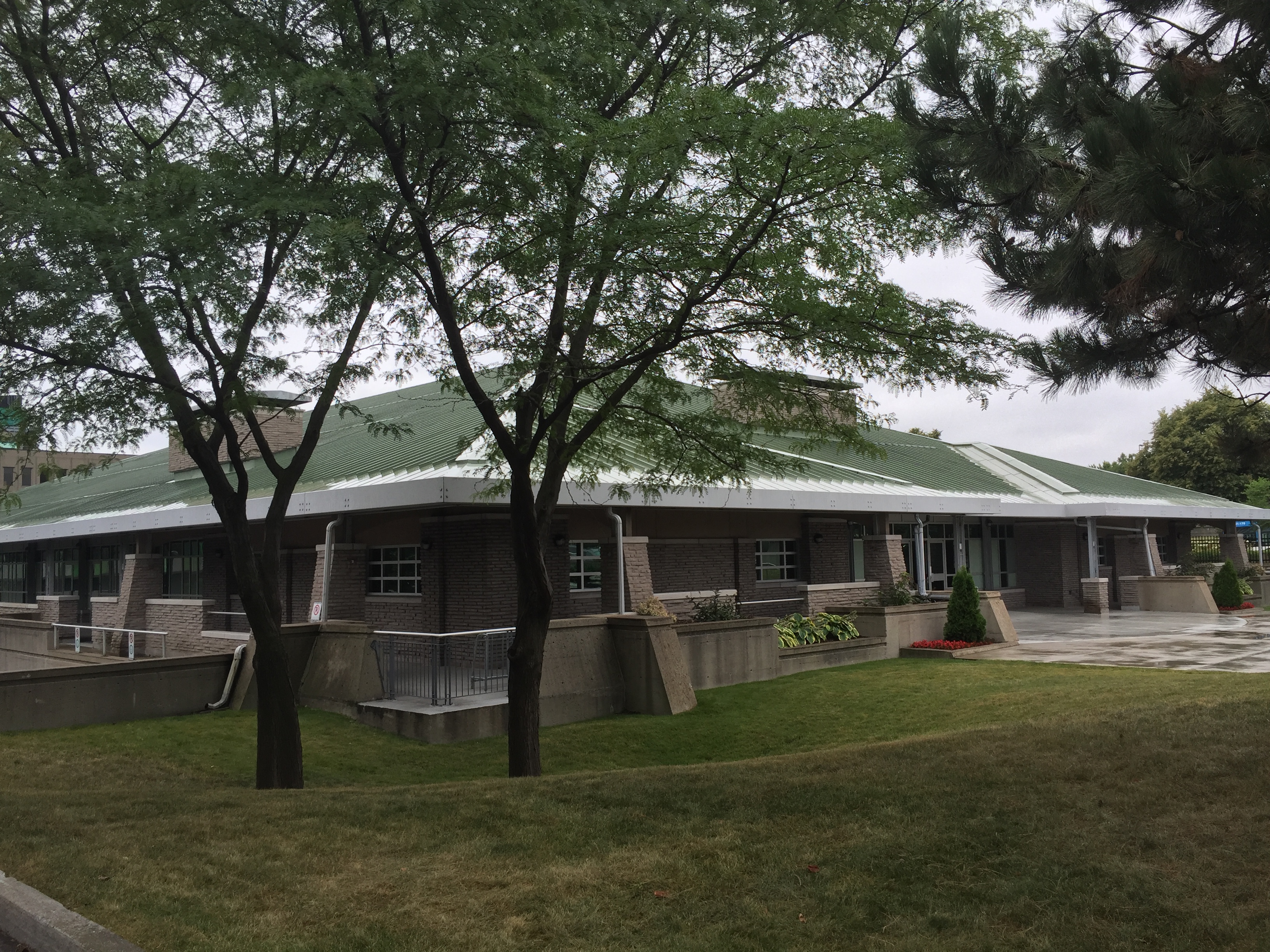 The stake centre of the Montreal Quebec Stake, located at 1777 Avenue de Lorimier, was the home to the Hochelaga and Zarahemla Wards (French and Spanish speaking, respectively) in 2016. (Catherine Jarvis)
The stake centre of the Montreal Quebec Stake, located at 1777 Avenue de Lorimier, was the home to the Hochelaga and Zarahemla Wards (French and Spanish speaking, respectively) in 2016. (Catherine Jarvis)
Contributions to Quebec society have continued. When the Book of Mormon musical toured Montreal in December 2014, several events were organized to combat stereotypes about the Latter-day Saints. Richard and Claudia Bushman gave academic lectures at McGill University, Concordia University, and the University of Montreal. Their lectures included “The Perplexing Book of Mormon” and “Mormon Feminism: Historical and Contemporary Issues.”[229] Public affairs also launched several social media campaigns during this time to share positive messages about the LDS Church. One of these campaigns involved a Christmas flash mob. Event organizer Marie-Frédérique Carter said, “We wanted to send a special Christmas message of goodwill to the people of our beautiful city!” More than two hundred Latter-day Saints, led by professional soprano, Marianne Lambert, sang Christmas carols at Complexe Desjardins on 6 December 2014. A YouTube video of the event received more than one hundred thousand views during the Christmas season of 2014.[230]
Ongoing genealogy work by the Church in Quebec has also been important in integrating the Church into the community. One important contribution was the Church assisting in the conservation of Quebec vital statistics through 1876. As one genealogical journalist wrote, “The Genealogical Society of Utah finally reached an agreement with the Assembly of Quebec Bishops in October 1976, eight years after its initial request. Under the agreement, the Mormons would microfilm all records of baptisms, marriages, and burials kept in the church archives, from the earliest records to 1876. The microfilming was done between 1977 and 1981. The Assembly of Bishops nevertheless retained ownership of negatives, which remained in storage in the archives of the University of Montreal.”[231]
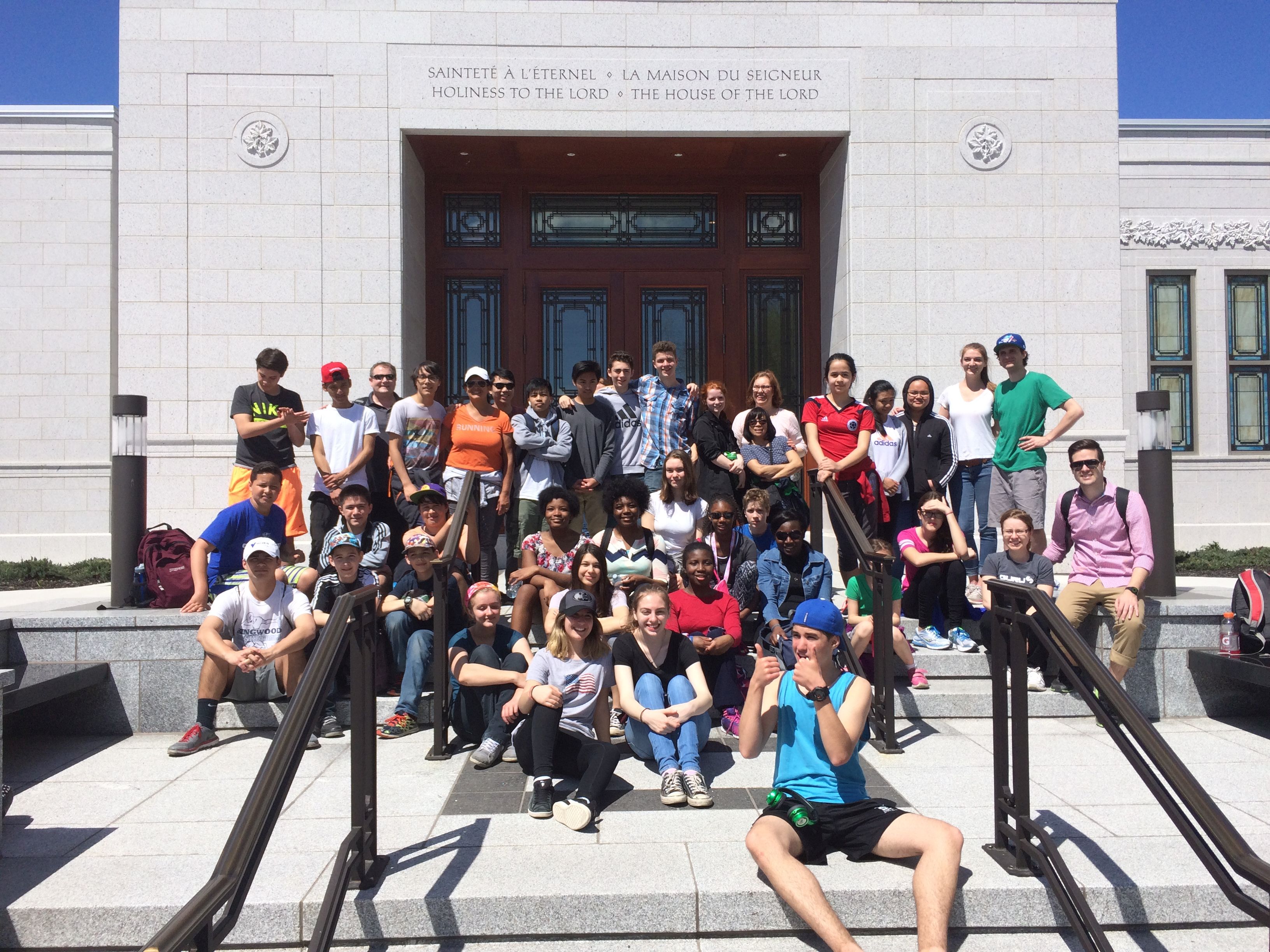 In 2016, youth of the Montreal Quebec Mount Royal Stake held a “temple walk,” walking nine kilometres from the Montreal Quebec stake centre to the temple. (David Brulé)
In 2016, youth of the Montreal Quebec Mount Royal Stake held a “temple walk,” walking nine kilometres from the Montreal Quebec stake centre to the temple. (David Brulé)
Pierre Anthian, a member of the Montreal Quebec Stake, became a celebrity in Quebec after starting the first ever homeless men’s choir (Montreal’s Accueil Bonneau Choir) in 1996.[232] Between 1996 and 2002, his choir went on to give 1,600 concerts, did a world tour, cut six albums (110,000 copies sold), and shared the stage with pop icon Celine Dion (supported by the Association québécoise de l'industrie du disque [ADISQ] and performed at the Olympic Stadium).[233] A made-for-television movie, The Christmas Choir, was released in 2008, based on Pierre’s experience creating the choir.[234] The choir disbanded in January 2002,[235] but Pierre’s idea has inspired the creation of other homeless choirs in Edmonton, Halifax, Chicago, Melbourne (Australia), Frankfurt, and Paris.[236] Pierre Anthian went on to work with other community organizations before entering municipal politics in 2013. In 2016 he was serving as a Laval city councilor for the riding of Laval-des-Rapides.
From these examples, it is clear that the Latter-day Saints in Quebec are beginning to come out of the shadows and make contributions to the mainstream society on a number of fronts. As a growing body of dedicated people, working together for the common good, despite language and ethnic differences, Latter-day Saints in Quebec are gaining acceptance and contributing to their communities.
Conclusions
The Church in Quebec began as a tiny religious minority among the English-speaking population and continued principally among anglophones for more than fifty years. Paralleling far-reaching social and political changes in Quebec during the 1960s and 1970s, Church growth accelerated after 1970, especially among the French-speaking majority. As the numbers of French-speaking members increased rapidly, the Church among anglophone Quebecers had a much slower rate of growth, even dwindling somewhat during times of political uncertainty, such as the 1980 and 1995 referenda for sovereignty. From the late 1970s, a third trend began to establish itself. Allophones, meaning those who speak neither French nor English as their first language, began to join the Church in significant numbers, prompting the creation of language-specific wards and branches (Cantonese, Spanish, and Mandarin).
Constant through these changing patterns of Church growth in Quebec has been the sacrifice of the members, which has driven forward the progress of the Church despite all forces and impediments to the contrary.
The Church in Quebec is maturing and entering a new phase in which a second generation born and raised Latter-day Saint is lending new vitality and maturity. This second generation is marked by numerous men and women who have entered missionary service and returned to live in Quebec. They have brought significant stability to a precarious church, and, with their help, the Church in Quebec is poised to make significant contributions to mainstream society and take its rightful place as an independent and distinct religious community.
In Memoriam
Dean R. Louder, who contributed sidebars to this chapter and otherwise assisted in its preparation, passed away on 10 May 2017. A longtime resident of Quebec and a noted geography professor at Laval University, he was a leader in the study of dispersed populations of Quebec origin in America. He passionately loved the French language and the people of the province and tirelessly advocated their interests. He will be sorely missed as a friend and colleague and fellow member of The Church of Jesus Christ of Latter-day Saints.
Notes
[1] The Great Canadian Mission: A Jubilee History (n.p.: The Canadian Mission of The Church of Jesus Christ of Latter-day Saints, 1969), 48–52.
[2] The Canadian Encyclopedia, P.-A. Linteau, revised by Elaine Young, 2009, s.v. “Montréal,” http://
[3] Stephan Jehoda and Sandra Jehoda, interview by Bruce Blummell, 13 August 1979, James Moyle Oral History Program, Salt Lake City, Utah, typescript, 42, CHL, OH 488.
[4] Great Canadian Mission, 48.
[5] Louise Cousineau, “Le Québec est une ‘terre de mission’ pour les Mormons,” La Patrie, Montréal, 1 October 1967, 22, clipping included in Canadian Mission quarterly reports, 31 December 1967, Canada Toronto West Mission (hereafter CTWM), Manuscript History and Historical Reports (hereafter MHHR), box 3 folder 4, Church History Library, Salt Lake City (hereafter CHL), LR 6520 2.
[6] “Quebec, Facts and Statistics,” Mormon Newsroom, consulted 21 July 2016, http://
[7] Horace Cowan and Hazen Aldrich, Journal History, 23 March 1833, 3–4, CHL 127.
[8] Sarah Studevant Leavitt, “History of Sarah Studevant Leavitt,” 5–8, copied from her autobiography by Juanita Leavitt Pulsipher, June 1919, CHL, M270.07 L439h 1969; see also FamilySearch data on the Leavitt family, https://
[9] Thomas Rowell Leavitt, KWN5-DMX, familysearch.org.
[10] See FamilySearch entries for Leavitt family, David Moore, and Barnabus Merrifield; see also Mormon Pioneer Overland Travel database for these families, history.lds.org/
[11] Jesse W. Crosby, “The History and Journal of Jesse Wentworth Crosby,” typescript, 6–8, 17–23, CHL, MS 24036.
[12] Benjamin Brown, Testimonies for the Truth: A Record of Manifestations of the Power of God, Miraculous and Providential, Witnessed in The Travels and Experience of Benjamin Brown, High Priest in The Church of Jesus Christ of Latter-day Saints, Pastor of the London, Reading, Kent, and Essex Conferences (1853), 20, CHL, M270.1 B877b 1853.
[13] Mormon Pioneer Overland Travel, CHL, http://
[14] “History of the Eastern States Mission from 1830 to 1893, and Continuation to 1903,” New York New York South Mission (hereafter NYNYSM) MHHR, box 1, folder 3, CHL, LR 2475 2.
[15] Eastern States Mission Historical Reports, NYNYSMMHHR, box 2, folder 2, clipping from Liahona, the Elders’ Journal, 28 April 1914, 11:732–35, CHL, LR 2475 2; Eastern States Mission historical reports, NYNYSMMHHR, box 2, folder 4, clipping from Liahona, the Elders’ Journal, 30 July 1918, 16:907–09, CHL, LR 2475 2.
[16] “Canadian Mission,” News from the Missions, Liahona, the Elders’ Journal, 2 September 1919, 17:5, 83, CHL, M205.5 L693.
[17] History of the Montreal Conference (now the Montreal District), Montreal District General Minutes (hereafter MDGM), folder 1, 18–19 October 1919, 1–2 July 1920, 9 November 1920, 3, 12, 19–20, 24 April 1921, 1 May 1921, 30-31 July 1921, November 1921, 26 February 1922, 1, 3, 5–6, 8, 11, CHL, LR 5739 11. By 1923, the Berryman family and their daughter had moved to Detroit (1930 US Census, Detroit, Wayne County, Michigan, Dist. ED 425. Sheet 18b), but the Lamb family with several children remained, as evidenced by their names appearing in Church records in Montreal for many years.
[18] MDGM, folder 1, 19 November 1922, 19, and 16 September 1928, 128, CHL, LR 5739 11.
[19] MDGM, folder 1, 6, 21 July and 1 August 1925, 48–50, CHL, LR 5739 11.
[20] MDGM, folder 1, 27 October 1925, 55, CHL, LR 5739 11.
[21] MDGM, folder 1, [Please insert day] May, 1 June, and 16 September 1928, 123–24, 128, CHL, LR 5739 11.
[22] William. J. Smith, “Montreal,” Canadian Mission, News from the Missions, Liahona, the Elders’ Journal, 14 March 1939, 446; MDGM, folder 3, 29 June 1941, 8–9, CHL, LR 5739 11.
[23] MDGM, folder 3, 22 March 1942, 23, CHL, LR 5739 11.
[24] MDGM, folder 3, 25 June 1942, 27, CHL, LR 5739 11.
[25] Raymond David Sawyer, interview with George Eric Jarvis and Catherine Jarvis, 10 May 2015.
[26] MDGM, folder 1, 19-20 April 1921, CHL, LR 5739 11.
[27] Apostles that visited Montreal included James E. Talmage in 1924; Joseph Fielding Smith in 1925 and 1942; Orson F. Whitney in 1926; George Albert Smith in 1927, 1932, and 1942; David O. McKay in 1929; Melvin J. Ballard in 1931 and 1932; Reed Smoot in 1935; Charles A. Callis in 1936; Joseph F. Merrill in 1937; John A. Widtsoe in 1941; and Stephen L. Richards in 1943. (Clyde W. Ferrin, “Montreal,” Canadian Mission, News from the Missions, Liahona, the Elders’ Journal, 12 January 1937, 359; MDGM, folder 3, 29 June 1941, 12 September 1941, 22 February 1942, 25 June 1942, and 27 June 1943, 8–9, 13–14, 22, 27, 38–41, CHL, LR 5739 11).
[28] MDGM, folder 1, 20–21 June 1925, 44–46, CHL, LR 5739 11.
[29] MDGM, folder 1, 10–13 June 1926, 67–69, CHL, LR 5739 11.
[30] John B. Lake, “Montreal,” Canadian Mission, News from the Missions, Liahona, the Elders’ Journal, 7 November 1933, 258.
[31] MDGM, folder 3, 3 and 20 October 1943, 46–47, CHL, LR 5739 11.
[32] MDGM, folder 3, 22 April 1944, 11 April 1946, 18 May 1946, 52–53, CHL, LR 5739 11.
[33] MDGM, folder 3, 24–25 October 1946 and 10 December 1946, 64-65, 71, CHL, LR 5739 11.
[34] MDGM, folder 3, 13, 24–25 October 1946, 10 December 1946, 26 April 1947, 20 April, 5–7 July, and 2 August 1949, 63–65, 71, 84, 138, 142, CHL, LR 5739 11.
[35] MDGM, folder 3, 13, 25, 30 March, 23, 27, 29 April, and 6 May 1951, 163–65, CHL, LR 5739 11.
[36] CTWMMHHR, box 2, folder 3, 30 June 1955, 31 December 1956, CHL, LR 6520 2.
[37] MDGM, folder 3, 31 March 1941, 4, CHL, LR 5739 11.
[38] MDGM, folder 3, 29 April 1951, 165, CHL, LR 5739 11; CTWMMHHR, box 3, folder 2, 30 June 1962, CHL, LR 6520 2.
[39] “His Conversion Took Courage,” Deseret News, 1 April 1972, 12. See also Hans Peets, FamilySearch, https://
[40] CTWMMHHR, box 3, folder 4, 31 March 1967, 31 December 1969, CHL, LR 6520 2; see also Ottawa-Montreal District quarterly historical report, March 1967, Ottawa-Montreal District (hereafter OMD), MHHR, CHL, LR 6630 2.
[41] CTWMMHHR, box 2, folder 3, 30 September and 31 December 1957, CHL, LR 6520 2.
[42] Canadian Mission Annual Reports, 31 December 1969, CTWMMHHR, box 3, folder 4, CHL, LR 6520; see also OMD quarterly historical report, March 1967, OMDMHHR, CHL, LR 6630 2; Great Canadian Mission, 48.
[43] Georges L. Bourget, email to Catherine Jarvis, 6 March 2017.
[44] MDGM, 11, 17 December 1946, 27 January, 2 July, and 17 September 1947, 26 September 1950, 71–72, 78–79, 87, 92–93, 156, CHL, LR 5739 11.
[45] CTWMMHHR, box 3, folder 1, 30 June 1961, CHL, LR 6520 2.
[46] CTWMMHHR, box 3, folder 1, 30 June, 30 September, and 31 December 1961.
[47] CTWMMHHR, box 3, folder 1, 30 September 1961, and box 3, folder 2, 30 June 1964, 31 December 1965; Stephan Jehoda and Sandra Jehoda, interview, 12–14.
[48] “Deux nouveaux missionnaires Mormons,” Le Soleil, Quebec, 13 October 1966, clipping inserted into CTWMMHHR, box 3, folder 3, 31 December 1966.
[49] CTWMMHHR, box 3, folder 4, 30 September and 31 December 1967, CHL LR 6520 2.
[50] Cousineau, “Le Québec est une ‘terre de mission’ pour les Mormons,” La Patrie, Montréal, 1 October 1967, 22, clipping included in Canadian Mission quarterly reports, 31 December 1967, CTWMMHHR, box 3, folder 4, CHL, LR 6520 2.
[51] Cousineau, “Le Québec est une ‘terre de mission’ pour les Mormons,” La Patrie, Montréal, 1 October 1967, 22, clipping included in Canadian Mission quarterly reports, 31 December 1967, CTWMMHHR, box 3, folder 4, CHL, LR 6520 2.
[52] Canadian Mission quarterly reports, 30 June 1967, CTWMMHHR, box 3, folder 4, CHL, LR 6520 2.
[53] Quebec Ward Historical Information, Church Directory of Organizations and Leaders (CDOL), last updated 14 February 2014, cdol.lds.org; see also “Davenport Named President Of Quebec Mormon Branch,” n.d., newspaper clipping included in Canadian Mission Annual Reports, 31 December 1969, CTWMMHHR, box 3, folder 4, CHL, LR 6520 2.
[54] Hochelaga Ward Historical Information, CDOL, last updated 16 February 2014, cdol.lds.org.
[55] Canadian Encyclopedia, R. Durocher, s.v. “The Quiet Revolution.” For accounts of the Quiet Revolution and subsequent events, see John Dickenson and Brian Young, A Short History of Quebec. 4th ed. (Montreal, Kingston, London, Ithaca: McGill-Queen’s University Press, 2008 [pub. in French, 2009]), 296-344; Paul-André Linteau et al, Histoire du Québec contemporain: vol. 2, Le Québec depuis 1930, rev. ed. (Montreal: Boréal, 1989), 421-32ff.
[56] Canadian Encyclopedia, R. Durocher, s.v. “The Quiet Revolution;” Dickenson and Young, History of Quebec, 305–6, 312–13.
[57] Canadian Encyclopedia, R. Durocher, s.v. “The Quiet Revolution.” See Linteau et al, Le Québec depuis 1930, 428–30.
[58] CTWMMHHR, box 3, folder 4, 31 December 1969, CHL, LR 6520 2.
[59] Stephan Jehoda and Sandra Jehoda, interview, 24.
[60] Canadian Encyclopedia, Maude-Emmanuelle Lambert, 2015, s.v. “Expo 67,” http://
[61] Roger Richards, former missionary in Quebec, email to Joyce Findlay, 24 November 2014.
[62] CTWMMHHR, box 3, folder 4, 31 December 1970.
[63] Richards, email to Findlay.
[64] CTWMMHHR, box 3, folder 4, 31 December 1969 and 31 December 1970.
[65] Linda Pelchat, interview by George Eric Jarvis and Catherine Jarvis, 5 June 2014.
[66] Victorien Bouchard, Liste Des Présidents, personal communication to G. Eric Jarvis, 30 March 2015; see also Carma Prete, “Canada Quebec,” country profile prepared for the Church History Department, 2014, unpublished, CHL.
[67] Jerald R. Izatt, Dean R. Louder, and Georges L. Bourget, presidency of the Quebec Branch, to Delbert L. Stapley, 24 October 1971 and 5 May 1972, in Dean R. Louder, Film de la Branche de Quebec, 1969–1982, September 1983, 139–40, 144–45.
[68] Pierre-Paul Morin, interview by Roy A. Prete, 19 June 2014, CHL, OH 7148.
[69] Canada Montreal Mission MHHR (hereafter CMMMHHR), 31 December 1972, 24 April, 14, 17, 22, 28 July, 1972, CHL, LR 13768 2.
[70] CMMMHHR, 31 December 1974, CHL, LR 13768 2.
[71] CMMMHHR, 31 December 1972, CHL, LR 13768 2.
[72] Historical reports of the Quebec Mission, 31 December 1972, CMMMHHR, CHL, LR 13768 2.
[73] Stephan Jehoda and Sandra Jehoda, interview, 27–28.
[74] Historical reports of the Quebec Mission, 31 December 1973, CMMMHHR, CHL, LR 13768 2.
[75] Linda Pelchat, interview.
[76] Georges L. Bourget, “Beginning of My Work in the Church,” attached to email to G. Eric Jarvis, 7 June 2015.
[77] Montreal District historical events, 31 December 1974, MDMHHR, CHL, LR 5739 2; see also CMMMHHR, 31 December 1974, CHL, LR 13768 2.
[78] Stephan Jehoda and Sandra Jehoda, interview, 10–12; Canadian Mission quarterly reports, 30 June 1964, CTWMMHHR, box 3, folder 2, CHL, LR 6520 2.
[79] Stephan Jehoda and Sandra Jehoda, interview, 36.
[80] CMMMHHR, 31 December 1975, CHL, LR 13768 2.
[81] Valleyfield Branch, Historical Information, CDOL, cdol.lds.org.
[82] Drummondville Ward Historical Information, CDOL, consulted 20 January 2017, cdol.lds.org.
[83] Sherbrooke Ward and Victoriaville Branch Historical Information, CDOL, consulted 20 January 2017, cdol.lds.org.
[84] Historical reports, 31 December 1975, 31 December 1976, CMMMHHR, CHL, LR 13768 2.
[85] Historical Reports, 31 December 1976, CMMMHHR, CHL, LR 13768 2.
[86] Stephan Jehoda and Sandra Jehoda, interview, 42.
[87] Événements historiques, 1978, CMM Annual Historical Reports, folder 1, CHL, LR 13768 3; see also Montréal Québec Stake Historical Information, CDOL, last updated 5 May 2014, cdol.lds.org.
[88] Gatineau Ward (French), Historical Information, CDOL, last updated 10 November 2015, cdol.lds.org.
[89] Jean Saintonge, emails to George Eric Jarvis, 7 and 11 February 2015.
[90] Saintonge, emails to George Eric Jarvis.
[91] Bourget, “Beginning of My Work,” 2015; “Eight New Mission Presidents Called,” Church News, 15 April 1978, 12.
[92] Georges L. Bourget, e-mail to Catherine Jarvis, 5 March 2017.
[93] Roy A. Prete, Journal, vol. 4, 169–70 (20 November 1977), in Roy A. Prete, email (with attachment) to George Eric Jarvis, 8 April 2017.
[94] Georges L. Bourget, e-mail to Catherine Jarvis, 5 March 2017.
[95] Laurent M. Leclerc, email communication to George Eric and Catherine Jarvis, 6 March 2017.
[96] “Deux nouveaux missionnaires mormons,” Le Soleil, Quebec, 13 October 1966, clipping inserted into Canadian Mission quarterly reports, 31 December 1966, CTWMMHHR, box 3, folder 3, CHL, LR 6520 2.
[97] Dean Louder, email to Roy A. Prete, 24 August 2015.
[98] Dean Louder, email to Roy A. Prete, 16 July 2015.
[99] Demoine A. Findlay, “Bagotville Quebec 1968,” email to George Eric Jarvis, 19 November 2016; Demoine A. Findlay, emails to Carma Prete, 17 and 20 August 2016.
[100] Demoine Findlay, email to Carma Prete, 17 August 2016.
[101] Roger Richards, email to Demoine Findlay and Joyce Findlay, 22 November 2014.
[102] Demoine Findlay, emails to George Eric Jarvis.
[103] Richards, email to Findlay and Findlay.
[104] Grant Fletcher, email to Demoine Findlay and Joyce Findlay, 2014.
[105] Richards, email to Findlay and Findlay; Demoine Findlay, email to Carma Prete.
[106] Demoine Findlay, emails to George Eric Jarvis.
[107] Chicoutimi Branch Historical Information, CDOL, consulted 20 January 2017, cdol.lds.org.
[108] R. Truchon, email to George Eric Jarvis, 31 October 2016.
[109] Historical reports of the Quebec Mission, 31 December 1973, CMMMHHR, CHL, LR 13768.
[110] Événements historiques, 1978, CMM Annual Historical Reports, folder 1, CHL, LR 13768 3; see also Saguenay Québec District Historical Information, CDOL, last updated 13 April 2011, cdol.lds.org. There is no mention here of a unit in Val d’Or.
[111] Pierre-Paul Morin, email to George Eric Jarvis, 8 February 2015.
[112] Morin, interview.
[113] G. Lévesque, emails to George Eric Jarvis, 31 October and 1 November 2016.
[114] Rimouski Branch Historical Information, CDOL, last updated 14 February 2014, cdol.lds.org.
[115] G. Lévesque, emails to George Eric Jarvis.
[116] Victorien Bouchard, “L’historique de la branche d’Alma,” email to George Eric Jarvis, 1 November 2016.
[117] Dean R. Louder, email and attachment to George Eric Jarvis, 1 September 2016.
[118] Rémy Tremblay to Catherine Jarvis, [Fall] 2016; “Photo Gallery for Supercentenarians born in the year 1903, as of January 6, 2017,” consulted 3 February 2017, http://
[119] Dean Perkins of the Member and Statistical Records Division, The Church of Jesus Christ of Latter-day Saints, email to Stephen V. Beck, Country Profile Manager, CHL, 31 August 2016 [Hereafter Member and Statistical Records Division, 31 August 2016].
[120] Dean R. Louder, “Canadian Mormon Identity and the French Fact,” The Mormon Presence in Canada (Logan, Utah: Utah State University Press 1990), 320–21.
[121] CMM Annual Historical Reports (hereafter AHR), folder 1 (1996), CHL, LR 13768 3.
[122] Longueuil Branch Historical Information, CDOL, cdol.lds.org; .
[123] Montreal Quebec Stake Historical Information, CDOL, cdol.lds.org; Member and Statistical Records Division, 31 August 2016; Victoriaville Branch was created from the Drummondville Branch two weeks after the Drummondville Branch was transferred to the Quebec Quebec District.
[124] CDOL, Historical Information for each unit listed, cdol.lds.org.
[125] Drummondville, Victoriaville, and Trois Rivières Branches, Historical Information, CDOL, cdol.lds.org.
[126] Member and Statistical Records Division, 31 August 2016; Victoriaville Rimouski, Alma, Lévi, Historical Information, CDOL, cdol.lds.org.)
[127] CMM AHR, folder 5 (2005-2006), 3–4, CHL, LR 13768 3. See also Longueuil Québec Stake Historical Information, CDOL, cdol.lds.org.
[128] CMM AHR, folder 5 (2005–2006), 3–4, CHL, LR 13768; 3; M. Leclerc, email to Catherine Jarvis, 11 February 2017.
[129] CMM AHR, folder 5 (2005–2006), 3–4, CHL, LR 13768 3; see also Longueuil Québec Stake Historical Information, CDOL, last updated 26 March 2014, cdol.lds.org.
[130] Saguenay Québec District Historical Information, CDOL, last updated 13 April 2011, cdol.lds.org.
[131] Shawinigan, LaPrairie, and Granby Branches Historical Information, CDOL, consulted 26 August 2016.
[132] Pierre-Paul Morin, email to George Eric Jarvis, 3 February 2015.
[133] Boyden E. Lee, “Achieving Stakehood: The Ottawa Ontario Stake, 1974–1980,” in Roy A. Prete, ed., Zion Shall Come Forth: A History of the Ottawa Ontario Stake (Ottawa, Ontario: 1995), 47–49.
[134] Historical reports, 31 December 1976, CMMMHHR, CHL, LR 13768 2; Tung Fong Branch Historical Information, CDOL, last updated 13 September 2007, cdol.lds.org.
[135] D. Mark Prescott, “The Montreal Quebec Mount Royal Stake,” in Roy A. Prete, ed., Zion Shall Come Forth: A History of the Ottawa Ontario Stake (Ottawa, Ontario: 1995), 213; see also “Arson Blamed for Explosion that injures six at church,” Montreal Gazette, 11 January 1979; “Revenge Seeker Held for Church Blaze,” Montreal Gazette, 12 January 1979.
[136] Information from Roy A. Prete, 31 August 2016 (based on information from Edward J. Smith, president of the Ottawa Ontario Stake, 1980–1990, under whom Prete served as high councillor).
[137] Member and Statistical Records Division, 31 August 2016.
[138] Roy A. Prete, 1 September 2016 (member of the Ottawa Ontario Stake).
[139] Montreal Quebec Mount Royal Stake Historical Information, CDOL, last updated 20 November 2013, cdol.lds.org; see also Prescott, “The Montreal Quebec Mount Royal Stake,” 212.
[140] Potsdam New York District Historical Information and Associated Organizations, CDOL, consulted 1September 2016.
[141] Member and Statistical Records Division, 31 August 2016.
[142] George Eric Jarvis, former president of the Montreal Quebec Mount Royal Stake and author of this chapter, Summary of Stake Growth 2004–13, 8 November 2013, unpublished.
[143] R. Foot, & D. Latouche, “Rene Levesque,” The Canadian Encylopedia, 2009, retrieved 23 February 2017, from http://
[144] Dean Perkins of the Member and Statistical Records Division, The Church of Jesus Christ of Latter-day Saints, email to Stephen V. Beck, Country Profile Manager, CHL, 28 March 2016.
[145] George Eric Jarvis, Summary of Stake Growth.
[146] Kirkland Ward Historical Information, CDOL, last updated 14 February 2014, cdol.lds.org; see also Prescott, “Montreal Quebec Mount Royal Stake,” 215.
[147] Prescott, “Montreal Quebec Mount Royal Stake,” 215.
[148] Jehoda and Jehoda, interview, 51.
[149] Jehoda and Jehoda, interview, 51.
[150] Thomas Wilde, former president of the Montreal Quebec Mount Royal Stake, “A Brief History of the Church in Montreal,” c. 1990, unpublished; Thomas Wilde, interviewed by George Eric Jarvis, 2014; Pointe Claire Ward MHHR, 29 June 1980, CHL, LR 7071 2; Ottawa Ontario Stake Annual Historical Reports, folder 1, 6 July 1980, CHL, LR 15989 3.
[151] Thomas Wilde, interview by George Eric Jarvis, May 19, 2014.
[152] Domenico Carmine Raimondo Aloi, interview by George Eric Jarvis, 23 April 2014.
[153] Brian Lauder, interview by George Eric Jarvis, 30 March 2015.
[154] Mary-Anne Lauder, email to George Eric Jarvis, 28 April 2015.
[155] Walter Svenson and Sherry Oler, interview by George Eric Jarvis and Catherine Jarvis, May 18, 2014.
[156] Laurent Leclerc, e-mail to Catherine & George Eric Jarvis, March 6, 2017.
[157] Merlin Olsen, interview by George Eric Jarvis, 29 August 2016.
[158] Member and Statistical Records Division, 31 August 2016.
[159] Member and Statistical Records Division, 31 August 2016.
[160] Personal knowledge of author George Eric Jarvis, 1 September 2016. Jarvis served as president of the Montreal Quebec Mount Royal Stake from 2004 to 2013.
[161] Personal knowledge of author George Eric Jarvis.
[162] Personal knowledge of author George Eric Jarvis.
[163] Member and Statistical Records Division, 31 August 2016.
[164] Jay A. Glowa, email to George Eric Jarvis, 20 October 20 2014.
[165] Jay A. Glowa, email to George Eric Jarvis, 14 June 2015.
[166] Historical Reports, 31 December 1975, CMMMHHR, CHL, LR 13768 2.
[167] Zarahemla Ward Historical Information, CDOL, last updated 16 February 2014, cdol.lds.org.
[168] Monte Rey Branch (Spanish) Historical Information, CDOL, last updated 19 March 2014, cdol.lds.org.
[169] Victoria Ward (Spanish) Historical Information, CDOL, last updated 13 April 2014, cdol.lds.org.
[170] Sterling Dietze, emails to Omer Pirlet, 5 April 2015.
[171] Mount Royal Branch (Mandarin), CDOL, last updated 4 February 2014, cdol.lds.org.
[172] Member and Statistical Records Division, 31 August 2016.
[173] Jay A. Glowa, email to George Eric Jarvis, 4 March 2015.
[174] Omar Pirlet, email to George Eric Jarvis.
[175] Dominic Sénéchal, email to George Eric Jarvis.
[176] Montreal Quebec Stake Convert Baptism Data, 2004–2015, given to author by Dominic Sénéchal, president of the Montreal Quebec Stake, from quarterly reports.
[177] Montreal Quebec Stake Convert Baptism Data, 2004–2015.
[178] Louder, email to Prete, 24 August 2015.
[179] Mission Historical Summary 1998, CMM Annual Historical Reports, folder 1, CHL, LR 13768 3; see also “Pres. Hinckley Visits 6 Canadian Provinces,” Church News, 8 August 1998, 3.
[180] Thomas L. Wilde, interview by George Eric Jarvis, 29 May 2014.
[181] George Eric Jarvis, personal recollection of President Hinckley, 2015.
[182] Georges L. Bourget, email to Catherine Jarvis, 5 March 2017.
[183] Eric Dumouchel, “Canada Montreal Mission History,” 1998, accessed with permission of author 1 August 2016, http://
[184] Svenson and Oler, interview.
[185] Julie A. Dockstader, “Montreal Temple Highlight of 40 Years of Progress,” Church News, 10 June 2000, 3; see also “Montreal Quebec Temple,” Church News, 10 June 2000, 4.
[186] “New Temple Presidents,” Church News, 20 May 2000, 12; see also Kahlile Mehr, compiler, Mission President Data Base, volumes 1–2, CHL, M256 M498m 2002.
[187] Georges L. Bourget, email to Catherine Jarvis, 6 March 2017.
[188] George Eric Jarvis, diary entry, 8 December 2015.
[189] George Eric Jarvis, diary entry, 28 January 2007.
[190] Laurier YSA Branch, General Information and Historical Information, CDOL, last updated 18 September 2014, cdol.lds.org; D. Limoges, email to George Eric Jarvis, 11 April 2015.
[191] Joliette Branch, Terrebonne Ward, and Saint-Jerome Branch, Historical Information, CDOL. cdol.lds.org.
[192] George Eric Jarvis, diary entry, 27 May 2007.
[193] Alain Allard, email to George Eric Jarvis, 28 May 2011; George Eric Jarvis, diary entry, 16 July 2011.
[194] “Missionaries Sing Out in Montreal,” Ensign, November 2003, 128; George Eric Jarvis, August 21, 2016, personal recollection of Reid and Nona Nibley. The person conducting the missionaries at the Montreal Expos game is Reid Nibley, who was serving with his wife as a missionary at the time.
[195] George Eric Jarvis, 21 August 2016.
[196] Morin, email to George Eric Jarvis, 7 August 2016.
[197] R. Foster, email to George Eric Jarvis, 8 July 2008.
[198] George Eric Jarvis, diary entry, 16 July 2011.
[199] Alain Allard, email to George Eric Jarvis, 20 January 2009.
[200] W. T. David Murray, email to George Eric Jarvis, 21 July 2009.
[201] Stephan Jehoda, email to George Eric Jarvis, 8 January 2010.
[202] Montreal Quebec Stake, Montreal Quebec Mount Royal Stake, and Longueuil Quebec Stake Associated Organizations, CDOL, consulted 26 July 2016, cdol.lds.org.
[203] Abitibi Branch Historical Information, CDOL, cdol.lds.org.
[204] Dieter F. Uchtdorf, “Sustaining of Church Officers,” Ensign, May 2014.
[205] Dean R. Louder email and attachment to George Eric Jarvis, 1 September 2016; Dean R. Louder email to George Eric Jarvis, 24 November 2016
[206] Linda Pelchat, interview.
[207] George Eric Jarvis, personal recollection of Raymond Sawyer, 2015.
[208] Wilde, interview.
[209] Walter Svenson, 18 May 2014.
[210] George Eric Jarvis, personal recollection of Sherry Svenson, 2015.
[211] Jean Saintonge, email to Catherine Jarvis, 21 August 2016.
[212] Aloi, interview.
[213] George Eric Jarvis, personal recollection of Ray Aloi, 2015.
[214] Jehoda and Jehoda, interview, 13.
[215] Jehoda and Jehoda, interview, 34.
[216] Jehoda and Jehoda, interview, 40–41.
[217] Jean Saintonge, emails to George Eric Jarvis.
[218] “New Mission Presidents,” Church News, 12 January 2008; Michel J. Carter, CDOL, consulted 31 August 2016, cdol.lds.org.
[219] Historical Reports of the Quebec Mission, 31 December 1973, CMMMHHR, CHL, LR 13768 2; Uchtdorf, “Sustaining of Church Officers.”
[220] Catherine Jarvis, “30 Quebec Wards, Branches Help in Shoreline Cleanup,” Deseret News, 12 December 2010. http://
[221] Catherine Jarvis, “Interfaith Community Clean Up in Quebec,” Mormon Times, 5 June 2011, http://
[222] Cégep de Sainte-Foy, Journées des Sciences de la religion du Cégep de Sainte-Foy, 9e éditions, Mormonisme, 2010, cover page.
[223] D. Gignac, email to Ariane Avril Caron, 6 August 2016.
[224] Environment Canada, 2013; Environment and Climate Change Canada. Canada’s Top Ten Weather Stories for 2011: 3. Richelieu Flooding…Quebec’s Longest-Lived Disaster, June 19, 2013. Accessed August 2, 2016 at https://
[225] Catherine Jarvis, “ Mormon Helping Hands Assist Quebec Flood Victims,” Mormon Times, 10 July 2011, http://
[226] Perry Spice, email to Helen K. Warner, 15 June 2011.
[227] Guy Robitaille, Letter to the editor in response to an article entitled “De l’entraide, et sans subventions!” by Adrien Pouliot, La Presse.CA, 14 June 2011, http://
[228] “Mormons Host Christian Commemoration of the Shoah in Montreal,” Mormon Newsroom Canada, 19 April 2013, http://
[229] “Mormon Academics Speak at McGill University,” Mormon Newsroom Canada, 6 December 2014, http://
[230] “Montreal Mormons Gather in a Flash Mob to Celebrate Christmas,” Mormon Newsroom Canada, 16 December 2014, http://
[231] André LaRose, Résumé des Conférence, L’Ancêtre 41, no. 310, 2015, 170–73.
[232] “Homeless Choir Inspires Audiences Worldwide,” GoodNewsNetwork, 17 June 2006, http://
[233] Stéphane St-Amour, “Pierre Anthian mis en demeure par l’Accueil Bonneau,” Courrier Laval.com, 18 January 2016, http://
[234] J. Almeida, “The Christmas Choir,” Minds on Film blog, Royal College of Psychiatrists, 2016, http://
[235] Melissa Kent, “Montreal Homeless Choir Disbands,” CBC News, 3 January 2003, http://
[236] N. Raman, based on interview with Pierre Anthian, “Singing in the Streets,” The Guardian, 26 December 2008, https://
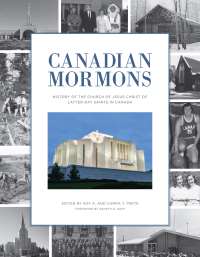
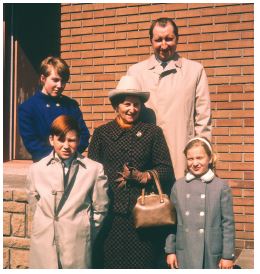 Hans and Elsa Peets and family in 1968. (Peter Peets)
Hans and Elsa Peets and family in 1968. (Peter Peets)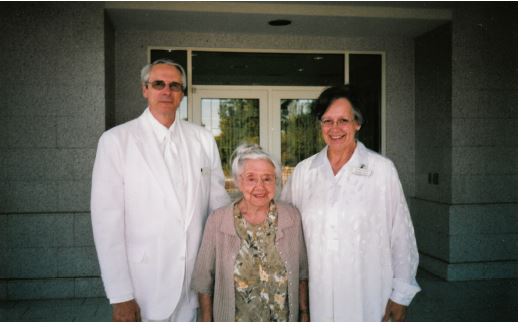 Colombe Benoît-Leclerc (centre), a resident of Quebec City, with Terry and Elenor Rollins,
Colombe Benoît-Leclerc (centre), a resident of Quebec City, with Terry and Elenor Rollins,